 tIn a November, 1999 article in the Honolulu Star-Bulletin, Burl Burlingame wrote, “Hawaiian culture, largely repressed at the beginning of the century in favor of Western education, began a comeback in the 1960’s and is in full flower today. The ‘Hawaiian Renaissance’ would have had trouble getting off the ground, however, if it had not been for the tools provided by educator Mary Kawena Pukui.
tIn a November, 1999 article in the Honolulu Star-Bulletin, Burl Burlingame wrote, “Hawaiian culture, largely repressed at the beginning of the century in favor of Western education, began a comeback in the 1960’s and is in full flower today. The ‘Hawaiian Renaissance’ would have had trouble getting off the ground, however, if it had not been for the tools provided by educator Mary Kawena Pukui.
In the August/September 2007 issue of Hana Hou! magazine, in an article entitled “Kawena’s Legacy” by Chad Blair, DeSoto Brown, Bishop Museum archivist said, “Kawena really is the primary informant for how the Hawaiian culture is practiced today. She recognized that the language and the knowledge were being lost. Kawena felt it incumbent on her to make sure Hawaiians who came after her would be able to go to her work and learn from it.” In the same article, Aunty Pat Namaka Bacon, Kawena’s hanai daughter added, “She always wanted to preserve whatever she had learned.”
The University of Hawai’i at Manoa’s Library guide states, “Mary Kawena Puku’i’s published work spans over 50 years, and her contributions to Hawaiian knowledge and preservation make her a giant in both the fields of Hawaiian language and Hawaiian studies. It is not much of a leap to say that were it not for Tutu Puku’i, much of the information and texts we take for granted would either have remained lost, or would have been trnslated much later. It is not too far-fetched to say that before her death, no other living Hawaiian had worked as hard to preserve the knowledge and culture of the Hawaiian people.”
EARLY LIFE & ‘OHANA: It was about noon on Saturday, April 20, 1895, when Akoni Kawa’a met his brother-in-law, Henry Wiggin, about to stop at a coffee shop on his way home from work at the Hutchinson Sugar Co. in Na’alehu and said, “E Hale, he kaikamahine momona,” (Harry, it’s a fat girl). The new father turned his horse around and galloped toward his mother-in-law’s house, Hale Ola, at Haniumalu, above Na’alehu, Ka’u, on the island of Hawaii. The little infant was delivered by her grandmother, Nali’ipo’aimoku, an experienced midwife. She was named Mary Abigail Ka-wena-‘ula-o-ka-lani-a-Hi’iaka-i-ka-poli-o-Pele-ka-wahine-‘ai-honua (The rosy glow in the sky made by Hi’iaka who was raised in the bosom of Pele, the earth consuming woman) Na-lei-lehua-a-Pele (Pele’s lehua leis) Wiggin. [The next time you watch the sun descend into the ocean at sunset and enjoy the colors of the sky, the rosy glow you see is ka-wena-‘ula.] The last name given the child was in reference to Kawena and her deceased older sister, Mary Binning, from Pa’ahana’s previous marriage. Her name appropriately established her family’s ties to the fire goddess,Pele, and the fire clan of Ka’u, who claim direct descendency from Pele. To all Hawaiians, Pele is Akua (god/goddess) but to the people of Ka’u, Pele is also Aumakua (family guardian).
*******
To Hawaiians, names are very important and carefully given. One would never use just any name they may have heard or seen and many names tied one to family and ancestry and would be recognized. Also inoa po (night names) given by ancestors, aumākua or gods/goddesses in dreams, must be given a child lest the child face illness or death. Kawena’s first Hawaiian name was an inoa po and was told to her aunt, Mary Rebecca Pu’uheana, in a dream just before she was born. To use a name without the proper relationship was inappropriate and just not done. Neither was falsely claiming a familial relationship. To do so was at the very least, shameful, and could even be harmful, should there be a kapu on the name.
He pili nakeke.
A relationship that fits so loosely that it rattles.
Names, like Na-li’i-po’ai-moku’s were commemorative, remembering a trip around Hawai’i island by two Ka’u chiefs who were cousins and brothers-in-law, Hinawale and OwalawahieaKaumaka. They were Po’ai’s great grandfather and great granduncle, respectively. OwalawahieaKaumaka was the paternal uncle of the beloved Ka’u chief, Kupake’e.
Another form of naming was inoa kuamuamu. If someone heard an insult directed at a loved one or relative, the insult would live in a name as a sign of contempt, so the offender would be reminded whenever the name was heard. This is an ancient Hawaiian practice and not easily understood, except by the older generations of Hawaiians. For example, Kawena’s mother heard someone say that her daughter had “haughty” eyes. One of Kawena’s hanai daughters was named Na-maka-uahoa-o- Kawena-‘ula-o-ka-lani (The haughty eyes of Kawena ‘ulaokalani). When this child suffered severely from sickness, Pa ‘ahana had a dream, inoa po, to add to her name, ikiiki-o-ka-lani-nui, to proclaim her a member of the Ka ‘u clan protected by Pele. When this addition was voiced by Pa ‘ahana, her illnesses disappeared. Another example of inoa kuamuamu being used was by Kawena’s great grandfather, Mokila. He was the head kahuna kalai wa‛a (canoe making expert), cousin and constant companion of the chief, Lilikalani aka Haililani. Whenever he heard of an unkind word directed at Haililani, he named his sons accordingly. The first was named Ke-li‛i-kanaka-‛ole-o-Haililani (Haililani, the chief without servants), then Ke-li‛i-kahakā-o-Haililani (Haililani, the disagreeable chief), then Ke-li‛i-kipi-o-Haililani (Haililani, the traitor chief) and Ke-li‛i-pio-o-Haililani (Haililani, the captive chief). When the eldest son died, without any offspring, his brother, Ke-li‛i-kahakā-o-Haililani, took his older, deceased brother’s name, so it would live on, and went by Kanaka’ole. He was Kawena’s grandfather, whose wives were Pamaho‛a, aka Kuku‘ena-i-ka-ahi-ho‘omau-honua, then her cousin, Nali‛ipo‛aimoku, with their children being his descendents. There are no others.. There is also another form of kuamuamu which involves giving a newborn child such a vile and repulsive name, that evil spirits, who would otherwise snatch the life from the baby, would leave the babyalone
* * * I M P O R T A N T N O T I C E * *
As stated above, when the elder brother died (he had no children), his younger brother adopted his name, Keli’ikanaka’ole-o=Haililani, so it would live on. It has been brought to our attention that there are people who are using this name and claim to be descendants. Please (be aware that the only descendants of this brother today are those from Mary Pu’uheana KawahinepelekaneoLunalilo (Kanaka’ole), Fannie Sarah Kamakolunuiokalani Kaulaokeahi (Kanaka’ole), Mary Catherine Keli’ipa’ahana Hi’ileilani Hi’iakaikawaiola (Kanaka’ole) and Rose Angeline Ka’iakoiliokalani Kaliko’iliahiokalani (Kanaka’ole) who were Kanaka’ole’s children with Nali’ipo’aimoku, as well as Ka’iā (Kanaka’ole) and Kukuena (Kanaka’ole) who were Kanaka’ole’s children with Pamaho’a. THERE ARE NO OTHERS!
Some years back, noted genealogist, Edith McKenzie, took Edith and Luka Kanaka’ole to meet with Mary Kawena Pūku’i at her Manoa home to discuss genealogy.* These revered kūpuna talked for a long time, determined and agreed that there was no relationship between our two families! Any claim to the contrary today would demonstrate utter disregard for the knowledge of these respected kūpuna, while exhibiting shameful and very un-Hawaiian behavior.
In addition, knowingly making false claims for gain can be prosecuted in court. But, most importantly, this kind of activity is not the way of our people and can only cause unnecessary confusion, arguments and perhaps resentment. As Hawaiians, we must respect our kupuna and elders, as we have been taught and must teach our children to do.
*(Kawena and Edith were not strangers. Kawena’s daughter, Pele, died of a heart attack after chanting for Edith, who was receiving an award from Gov. George Ariyoshi at the capitol. The last picture of Pele is of her chanting for Edith and holding her hand, with Luka behind them. Edith went to Manoa and spent the evening with Kawena.)
[This notice is because of inquiries and confusion. We hope this will put this matter to rest.]
********
As her father entered the bedroom where the new baby lay, he said, “Hello Tui.” That was the name he called her from that moment until his last breath. Her mother was Mary Pa’ahana Kanaka’ole of Ka’u and her father, Henry Nathaniel Wiggin from Salem, Massachusetts. As the two new parents sat and gazed upon the newborn infant, something occurred that would set the tone for this child’s entire life. You see, it was an old Hawaiian custom that the first born child was given to the grandparents to be reared and taught; a boy to his paternal grandparents and a girl to her maternal grandparents. It was then the responsibility of the grandparents to teach their mo’opuna the family history, genealogy, traditions, legends, who their aumakua were, the lore and language of their people, etc. It was an ancient custom that bore much responsibility for both kupuna (grandparent) and child. The infant’s grandmother went and sat at her haole son-in-law’s feet and looked up at his face. She hesitated to ask him the same question she had asked her Hawaiian sons-in-law each time there was a birth of a baby girl, as she had been turned down each time and told, “He au hou keia!” (This is a new era with new ways!) Although she had been disappointed in the past, she was driven by her traditional family duty. She quietly asked her haole son-in-law, “E Hale, na’u ka mo’opuna?” (Harry, is the grandchild mine?) Kawena’s father, who had much respect and aloha for his Hawaiian mother-in-law, gently touched her shoulder and responded, “Ae, Mama, nāu no ka mo’opuna.” (Yes, Mama, she is yours). Po’ai sat quietly, then stood and went to tell her eldest daughter, Mary Rebecca Pu’uheana, that the baby born that day was hers to raise.
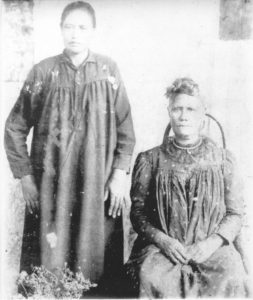 NALI’IPO’AIMOKU (standing) and KALIMAKUHILANI, HER AUNT AND TWIN SISTER OF HER MOTHER, KELI‛IPA‛AHANA Pa’ahana was surprised at this and asked her husband why he did that. “Your mama is getting old,” he said, “and doesn’t have too many years left. Let them be happy ones with a grandchild to teach and to raise in the Hawaiian manner.” From that day until Po’ai breathed her last and left this life, the two were inseparable. Kawena’s father, Henry Nathaniel Wiggin, was a New Englander from Salem, Massachusetts, who came to Hawai‘i in 1892 to work at the Hutchinson plantation in Na‘alehu, Ka‘ū, as head luna. His New England family had owned ships and forests for timber. He spoke fluent Hawaiian but only spoke English to his daughter. He was a direct descendent of America’s first poet, Anne Bradstreet and Massachussets Bay Colony governors, Thomas Dudley (who signed the charter for Harvard University at Cambridge), and Simon Bradstreet. He introduced to herstories of Paul Revere, Ichabod Crane and Rip Van Winkle; the poetry ofHenry Wadsworth Longfellow; read from Ralph Waldo Emerson, Nathaniel Hawthorne and the Bible, exposing her to his language and New England heritage. This knowledge of her mother’s, as well as her father’s language was invaluable and allowed her to bridge the two. It was an old Hawaiian custom that the ‘iēwe (placenta) of a newborn be buried under a tree or rock. Because of her mixture of Hawaiian and foreign ancestry, Kawena’s grandmother buried hers under a loquat tree, one of two foreign trees that grew there. The other foreign tree, a avocado, was where older sister’s ‘iēwe, from an earlier marriage and who died in infancy, was buried. After a month at Hale Ola, Kawena and her parents returned to their home in Na’alehu. Her grandmother gathered what she needed and went, too. At three months old, Po’ai added pa’i ‘uala (compressed sweet potato used as a substitute for poi, also called poi ‘uala) to the baby’s diet made from ‘uala (sweet potato) from Po’ai’s garden. If the baby needed a mild laxative, Po’ai would squeeze the juice from ‘ilima blossoms gathered from her garden into Kawena’s mouth. (This is called kanaka maika’i) A broth from ‘opihi (limpet) was fed for strength. Also, as was custom, nine days after the umbilical cord (piko) dropped off, it was taken to Pa’ula cave and secreted there. Many generations of Ka’u families had their piko hidden there. Po’ai also shaped the baby’s body to make the body attractive; a very old Hawaiian practicd. There was a desired look, accomplished by the shaping of the head, especially within the ali’i class. Infancy was the time to perfect the features of a favorite child. Long, tapered fingers were preferred over short, stubby ones, so they were pulled with the tips gently rolled to make them taper. A flat nose (‘upepe) was pressed for a sharper ridge, the buttocks, especially of a boy, should be round and not flat (kikala pai). Mothers were careful not to let the child’s ears fold over, lest they stick out; eyes would be pressed from the sides to make them larger, heads were gently shaped for a pleasing appearance. A flat head (po’o ‘opaha) was unattractive so babies must not be laid only on the back. This is a very old Hawaiian practice and Po’ai applied her knowledge on her baby. When Kawena was seven or eight months old, she fell off of her parents’ bed, where her father had laid her, and injured her back. Po’ai massaged Kawena daily with the juice of mashed raw kukui nuts. In addition, she buried her little one up to her waist in sand and stood behind Kawena with her arms through her baby’s armpits and very gently lifted her. She continued this, with her massaging, for several years, until Kawena was healed. This type of corrective treatment was called pakolea. When Kawena was eleven months old, her weaning took place at her grandmother’s home. Po’ai said prayers to Ku and Hina to remove the baby’s desire for breast milk. Kawena sat on her grandmother’s lap while two small stones were placed in front of her, The stones represented her mother’s breasts. Her mother, Pa’ahana, answered questions posed by Po’ai, acting as proxy for her daughter. There were questions, such as, “Do you wish the desire for breast milk to go away?” When all the questions were answered, Kawena picked up one of the stones and threw it off the lanai, signifying no further interest in breast-feeding. The stone hit her aunt, Mary Rebecca Pu’uheana, who lived there with her husband, Akoni Kawa’a, on the back between her shoulders. Thus ended the weaning process. Pa’ahana returned to their home in Na’alehu and Kawena stayed at Hale Ola with her grandmother. .Kawena’s older sister, Mary Binning, who was from Pa‘ahana’s previous marriage and who had died in infancy, was the hiapo (first born) and for her was held the ‘Aha‘aina Mawaewae, the last one held in the family.
NALI’IPO’AIMOKU (standing) and KALIMAKUHILANI, HER AUNT AND TWIN SISTER OF HER MOTHER, KELI‛IPA‛AHANA Pa’ahana was surprised at this and asked her husband why he did that. “Your mama is getting old,” he said, “and doesn’t have too many years left. Let them be happy ones with a grandchild to teach and to raise in the Hawaiian manner.” From that day until Po’ai breathed her last and left this life, the two were inseparable. Kawena’s father, Henry Nathaniel Wiggin, was a New Englander from Salem, Massachusetts, who came to Hawai‘i in 1892 to work at the Hutchinson plantation in Na‘alehu, Ka‘ū, as head luna. His New England family had owned ships and forests for timber. He spoke fluent Hawaiian but only spoke English to his daughter. He was a direct descendent of America’s first poet, Anne Bradstreet and Massachussets Bay Colony governors, Thomas Dudley (who signed the charter for Harvard University at Cambridge), and Simon Bradstreet. He introduced to herstories of Paul Revere, Ichabod Crane and Rip Van Winkle; the poetry ofHenry Wadsworth Longfellow; read from Ralph Waldo Emerson, Nathaniel Hawthorne and the Bible, exposing her to his language and New England heritage. This knowledge of her mother’s, as well as her father’s language was invaluable and allowed her to bridge the two. It was an old Hawaiian custom that the ‘iēwe (placenta) of a newborn be buried under a tree or rock. Because of her mixture of Hawaiian and foreign ancestry, Kawena’s grandmother buried hers under a loquat tree, one of two foreign trees that grew there. The other foreign tree, a avocado, was where older sister’s ‘iēwe, from an earlier marriage and who died in infancy, was buried. After a month at Hale Ola, Kawena and her parents returned to their home in Na’alehu. Her grandmother gathered what she needed and went, too. At three months old, Po’ai added pa’i ‘uala (compressed sweet potato used as a substitute for poi, also called poi ‘uala) to the baby’s diet made from ‘uala (sweet potato) from Po’ai’s garden. If the baby needed a mild laxative, Po’ai would squeeze the juice from ‘ilima blossoms gathered from her garden into Kawena’s mouth. (This is called kanaka maika’i) A broth from ‘opihi (limpet) was fed for strength. Also, as was custom, nine days after the umbilical cord (piko) dropped off, it was taken to Pa’ula cave and secreted there. Many generations of Ka’u families had their piko hidden there. Po’ai also shaped the baby’s body to make the body attractive; a very old Hawaiian practicd. There was a desired look, accomplished by the shaping of the head, especially within the ali’i class. Infancy was the time to perfect the features of a favorite child. Long, tapered fingers were preferred over short, stubby ones, so they were pulled with the tips gently rolled to make them taper. A flat nose (‘upepe) was pressed for a sharper ridge, the buttocks, especially of a boy, should be round and not flat (kikala pai). Mothers were careful not to let the child’s ears fold over, lest they stick out; eyes would be pressed from the sides to make them larger, heads were gently shaped for a pleasing appearance. A flat head (po’o ‘opaha) was unattractive so babies must not be laid only on the back. This is a very old Hawaiian practice and Po’ai applied her knowledge on her baby. When Kawena was seven or eight months old, she fell off of her parents’ bed, where her father had laid her, and injured her back. Po’ai massaged Kawena daily with the juice of mashed raw kukui nuts. In addition, she buried her little one up to her waist in sand and stood behind Kawena with her arms through her baby’s armpits and very gently lifted her. She continued this, with her massaging, for several years, until Kawena was healed. This type of corrective treatment was called pakolea. When Kawena was eleven months old, her weaning took place at her grandmother’s home. Po’ai said prayers to Ku and Hina to remove the baby’s desire for breast milk. Kawena sat on her grandmother’s lap while two small stones were placed in front of her, The stones represented her mother’s breasts. Her mother, Pa’ahana, answered questions posed by Po’ai, acting as proxy for her daughter. There were questions, such as, “Do you wish the desire for breast milk to go away?” When all the questions were answered, Kawena picked up one of the stones and threw it off the lanai, signifying no further interest in breast-feeding. The stone hit her aunt, Mary Rebecca Pu’uheana, who lived there with her husband, Akoni Kawa’a, on the back between her shoulders. Thus ended the weaning process. Pa’ahana returned to their home in Na’alehu and Kawena stayed at Hale Ola with her grandmother. .Kawena’s older sister, Mary Binning, who was from Pa‘ahana’s previous marriage and who had died in infancy, was the hiapo (first born) and for her was held the ‘Aha‘aina Mawaewae, the last one held in the family.
The following is a kanikau, a lamentation written for Mary Binning by her mother, Pa‘ahana:
He kanikau, he aloha kēia,
Nou no e Miss Mary Binning,
Ku‘u Kaikamahine i ka makani kuehu lepo o Na‘alehu,
Aloha kahi a kaua e noho ai ,
‘Auwe ku‘u kaikamahine ho‘i e,
Ku‘u kaikamahine i ka pali o Lauhu,
E hu‘e pau mai ana ko aloha i ku‘u waimaka,
‘Auwe ku‘u kaikamahine, ku‘u aloha la e—
Ku‘u kaikamahine i ka wai hu‘i o Ka-puna,
Aloha ia wahi a kaua e hele ai
Ku‘u kaikamahine i ka ua nihi pali o Ha‘ao,
Aloha ia wahi a kaua e pili ai,
Pi‘i aku kaua o ke ala loa,
O ke alanui malihini makamaka‘ole,
‘Auwe ku‘u aloha ku‘u minamina e
Ua hele i ke ala ho‘i ‘ole mai
Auwe ku‘u lei, ku‘u milimili la e,
Ku‘u hoa pili o ua ‘aina nei,
Eia au ke noho a‘e nei,
Me ka ukana nui he aloha.
‘Auwe kuēu lei momi la e
Kuēu kaikamahine i ka wela o Wai-ka-puna
Aloha ia wahi a kaua e hele ai,
Ku‘u kaikamahine i ke ‘ala o na pua,
‘Auwe ku‘u lei kula e, aloha no, a…
This is a dirge, an expression of affection,
For you, O Miss Mary Binning,
My daughter in the dust-scattering wind of Na‘alehu,
In the home we shared together,
Oh——-my daughter!
My daughter at the cliff of Lau-hu
Love for you makes my tears flow unchecked,
Oh my daughter at the cold spring of Ka-puna,
A beloved place to which we went,
My daughter in the rain that passes the hill of Ha‘ao,
A place we were fond of going together,
We used to go up the long trail,
A little known trail, unattended by a friend,
Oh my darling –how sad i am at losing you,
You have gone on a road on which there is no returning,
Oh my darling–my pet,
My constant companion in the homeland,
Here I remain.
With this great load, a yearning for you,
Oh my darling, precious as a necklace of pearls,
My daughter in the warm sun of Waikapuna,
Beloved is that place where we used to go,
My daughter among the fragrant flowers,
Oh my necklace, my golden chain, farewell–alas–!
*****************
For Kawena’s first birthday, a ‘aha‘aina palala, usually given for the high chiefs and wealthy, was held. It was the largest feast held in her honor. Her parents raised the pigs and chickens; her uncles caught the fish and gathered the sea foods and her aunts did all the preparation, waited on the tables and cleaned up afterwards. Kawena’s father told her it was a very big affair. Being raised by her grandmother provided Kawena with a unique education and appreciation for her maternal heritage. Po‘ai taught Kawena the mother tongue of Hawai‘i, she memorized ancient chants and rituals, learned old hula, customs, beliefs, religion and family history. This Hawaiian custom of grandparents teaching the eldest of each family was to insure the preservation of the culture and lifestyle. Little Kawena was very curious about everything and was always asking questions of her grandmother. Once, when her grandmother was treating a woman in a closed room, Kawena was so curious that she climbed a tree and observed the proceedings quietly through a window, unbeknownst to anyone. Po’ai, an expert kahuna la’au lapa’au tended to all Kawena’s ailments, but she would defer to the plantation doctor, Dr. Thompson when faced with ma’i haole (foreign diseases) like mumps, measles, chicken pox, tracoma and others which she was never trained to treat. Tracoma had spread throughout the plantation and there was a shortage of help, so Harry would go into the camps himself, to drop medicine into the eyes of the laborers, resulting in him contracting the disease and losing the sight of one eye. Even though Kawena was kept away from contamination, she caught the disease anyway and almost lost the sight of both eyes. Dr. Thompson kept the room dark and her eyes bandaged for a couple of weeks. He visited his little patient daily, sometime spending an hour or so, telling her interesting things he saw or did. Kawena recovered and the family held a feast to give thanks. Kawena always remembered her doctor with affection for his care and attention paid to his little patienr. 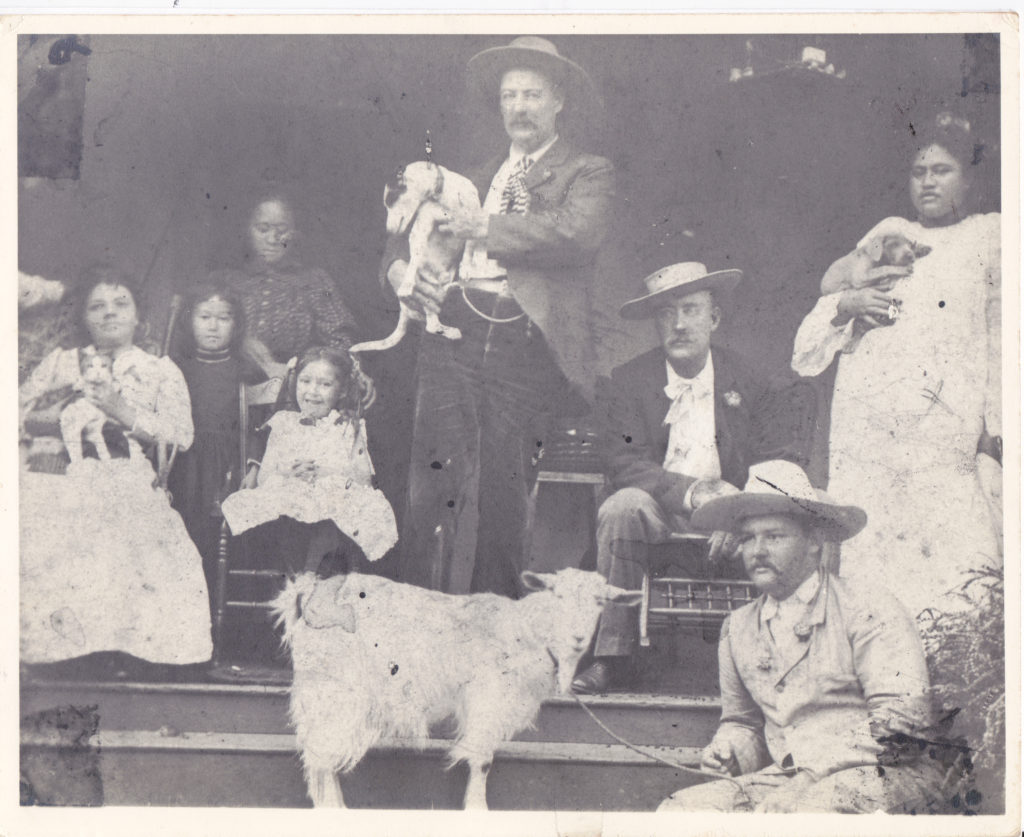 WIGGIN ‘OHANAL to R: Abigail Wiggin, wife of Edwin Wiggin; Maggie Makino, friend; Ida the maid; Mary Abigail Kawena Wiggin; Edwin Wiggin, brother of Henry; Henry Nathaniel Wiggin, Kawena’s father; Mary Pa’ahana Wiggin, wife of Henry & mother of Kawena Front: Nancy, the favorite goat; Walter Hazelden, friend
WIGGIN ‘OHANAL to R: Abigail Wiggin, wife of Edwin Wiggin; Maggie Makino, friend; Ida the maid; Mary Abigail Kawena Wiggin; Edwin Wiggin, brother of Henry; Henry Nathaniel Wiggin, Kawena’s father; Mary Pa’ahana Wiggin, wife of Henry & mother of Kawena Front: Nancy, the favorite goat; Walter Hazelden, friend
Po‘ai descended from a long line of kahuna, chiefs and chiefesses of Ka‘ū, and other districts, as well as Maui Island. She was very close to “her Queen Emma,” and was once summoned by the Queen to travel with her to Ni‘ihau, Kaua‘i and Ka‘ula as a dancer and chanter. 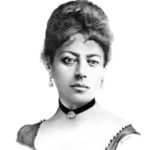 QUEEN EMMA Po‘ai, then in her late twenties, responded, meeting the queen in Honolulu, with her twenty year old cousin, Kuluwaimaka. (Kuluwaimaka is the great great grandfather of noted chanter/kumu hula, genealogist, lecturer and cultural expert, constantly called upon to judge hula competitions here and abroad, Cy Bridges, board member of the MKPCPS.)
QUEEN EMMA Po‘ai, then in her late twenties, responded, meeting the queen in Honolulu, with her twenty year old cousin, Kuluwaimaka. (Kuluwaimaka is the great great grandfather of noted chanter/kumu hula, genealogist, lecturer and cultural expert, constantly called upon to judge hula competitions here and abroad, Cy Bridges, board member of the MKPCPS.) 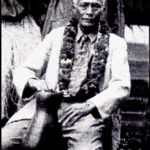 KULUWAIMAKA He was a noted chanter and in his late years became the chanter of Lalani Village in Waikiki. Po‘ai had recently given birth to a daughter, Kalamanamana, who she gave to her cousin, Ka-pule-nui, who lived in Manoa Valley and who had begged for a child of hers for so long, as he and his wife were childless. This allowed her to join her queen. Joining them in Honolulu were two teenaged sisters, ‘Ai ‘ō-nui and Ka-maka-huki-lani. They were relatives as they shared the same ancestry as the two from Ka’u. ‘Ai’ō-nui (Great debt) was named for the debt of the chief, Boki, and Ka-maka-huki-lani, for Boki’s mother. The ho’opa’a (drummer) for the group was a wahine named Keahi, who Kuluwaimaka later married. She was twice his age, very knowledgeable and expanded Kuluwaimaka’s repertoire. He descended from the chief, Palea, and was named for the tears shed by the chief, La’anui, of Ka’ū, when his beloved daughter passed away. After the tour, Po’ai returned to her family in Ka’u. Po‘ai had much aloha for “her” queen, Emma, and because of that deep aloha chose to have Kawena baptized by Bishop Willis of the Episcopalian church when he visited Ka‘ū. Queen Emma and her husband, Kamehameha IV, Alexander Liholiho, were instrumental in the establishment of the Episcopal Church in Hawaii, founding St. Andrew’s Cathedral, Saint Andrew’s Priory School for Girls and laid the groundwork for Iolani School, named in honor of her husband.
KULUWAIMAKA He was a noted chanter and in his late years became the chanter of Lalani Village in Waikiki. Po‘ai had recently given birth to a daughter, Kalamanamana, who she gave to her cousin, Ka-pule-nui, who lived in Manoa Valley and who had begged for a child of hers for so long, as he and his wife were childless. This allowed her to join her queen. Joining them in Honolulu were two teenaged sisters, ‘Ai ‘ō-nui and Ka-maka-huki-lani. They were relatives as they shared the same ancestry as the two from Ka’u. ‘Ai’ō-nui (Great debt) was named for the debt of the chief, Boki, and Ka-maka-huki-lani, for Boki’s mother. The ho’opa’a (drummer) for the group was a wahine named Keahi, who Kuluwaimaka later married. She was twice his age, very knowledgeable and expanded Kuluwaimaka’s repertoire. He descended from the chief, Palea, and was named for the tears shed by the chief, La’anui, of Ka’ū, when his beloved daughter passed away. After the tour, Po’ai returned to her family in Ka’u. Po‘ai had much aloha for “her” queen, Emma, and because of that deep aloha chose to have Kawena baptized by Bishop Willis of the Episcopalian church when he visited Ka‘ū. Queen Emma and her husband, Kamehameha IV, Alexander Liholiho, were instrumental in the establishment of the Episcopal Church in Hawaii, founding St. Andrew’s Cathedral, Saint Andrew’s Priory School for Girls and laid the groundwork for Iolani School, named in honor of her husband.
*********
Kawena’s godfather was a young Haole clerk who worked in the plantation store. His name was Alexander Lindsey, who, years later, became a judge in Honolulu. Po‘ai was named as godmother. Po‘ai’s knowledge was extensive and she passed on to her mo‘opuna punahele (favorite grandchild) everything she could. Po‘ai was a practiced midwife and expert in medicines, somtimes sending her young mo‘opuna out to gather the plants she needed. Little Kawena had been taught which hand to use to pick the medicinal plants and what prayer to utter while doing so. Po‘ai had learned to be a midwife from her mother, Ke-li‘i-pa‘ahana, who was an expert. Po‘ai trained three of her children: Ka‘iā, Ka-makolu-nui-o-ka-lani and Rebecca Pu‘u-heana. Po‘ai delivered alll her own children, except the last, Rose Ka‘iako’ili, when she needed Ka‘iā’s help at the last moment. Po‘ai would be up and working in one day. With mostly girls in her large family, Po‘ai had the younger ones do tasksusually done by boys. The two eldest girls, Mary Rebecca and Kamakolunuiokalani were taught to plait and sew. They were both very good, Mary Rebecca better at sewing and her younger sister wove a little better. A lauhala mat would be made in a single day. Mary Pa‘ahana was very good with children. She tended to the younger ones, helped with imu preparation, weed cutting/carrying and some cooking. Mary Rebecca, Rebecca Pu‘uheana and Rose were skilled in dressmaking. Mary Rebecca was the ‘ukeke player and Kawena loved to listen to her. When her foster mother put it down, Kawena would pick it up and mimic the sounds she heard and that’s how she learned to play the ancient instrument. As for playing the guitar, Mary Pa’ahana played slack key beautifully with her brother, Ke-li‘i-kipi-o-Haililani a close second. Mary Pa‘ahana and Kamakolu (who was named for one of Kalani‘ōpu‘u’s wives) were dancers, like their mother, and like Po‘ai, danced until the very last. The best singers were Mary Pa‘ahana and Annie Kukuena; the first had the sweeter voice and the latter, more husky with a memory for lyrics. Although Christianity was introduced to Hawai’i in 1820, ten years before Po‘ai was born, in 1830, she grew up only knowing the religion of her ancestors. Po‘ai had been raised by her step-father, Kanekuhia, who was a Priest of Lono and who taught her the chants and rituals of his calling. Her mother’s side of the family were ali’i, priests and priestesses of Pele and Kawena remembered watching her grandmother do some interesting dances. Po‘ai taught Kawena that respect was very important. Respect for the‘aumakua (family guardians), for the chiefs and one’s elders. She had to learn the names of her ‘aumakua so when there was a need, she could call on her own ‘aumakua instead of someone else’s. By the time she was five years old, Kawena had memorized the names of over fifty family ‘aumakua. ‘Aumakua were also called po‘e o ka pō (people of the night, or invisible people). However, they could take many visible forms, or kino lau, like shark, owl, lizard, bird, mouse, mudhen, eel, plant, rock, etc., as well as human form. An example is the story of one of Ku’s sons, Kumuhea, who settled at Pu‘u-‘enuhe (Caterpillar hill) in Ka‘ū, where he took a wife and only fed her his favorite diet of sweet potato leaves. She only saw him between sunset and sunrise and almost died from starvation. A kahuna discovered he was a supernatural being and her family appealed to his father, who took away his human form. Thereafter, he only had his other forms as a ‘enuhe (caterpillar) on land or loli (sea cucumber) in the sea. Kawena’s family would never kill a caterpillar or eat a sea cucumber. Kawena had to learn to understand signals given by ‘aumakua. For example, she learned if one’s pueo (owl) ‘aumakua behaved as though it wanted to be followed, do so because you’re being shown the safe path away from danger. If it crossed and re-crossed one’s path, there’s danger ahead so return from whence you came. If it slapped your shoulders, it means to sit down. The pueo will perch upon your head to disguise your presence. If slapped between the shoulder blades, one should lie down so the pueo can conceal one’s presence. Should the pueo cry at your doorway, it’s telling you to leave immediately because danger approaches. If the pueo takes one of your chickens, one must look within to determine what caused that to happen and to resolve the situation and the taking will stop.
******
‘AUMAKUA
(From Nānā I Ke Kumu vol.1)
There is a sea of time, so vast man cannot know its boundaries, so fathomless, man cannot plumb its depths. Into this dark sea plunge the spirits of men, released from their earthly bodies. The sea becomes one with the sky and the land and the fiery surging that rise from deep in the restless earth. For this is the measureless expanse of all space. This is the timelessness of all time. This is eternity. This is Pō. In Pō, there dwell our ancestors, transfigured into gods. They are forever god-spirits, possessing the strange and awesome powers of gods. Yet, they are forever our relatives, having for us the loving concern a mother feels for her infant, or a grandfather for his first-born grandson. As gods and relatives in one, they give us strength when we are weak, warning when danger threatens, guidance in our bewilderment, inspiration in our arts. They are equally our judges, hearing our words and watching our actions, reprimanding us for error, and punishing us for blatant offenses. For these are our godly ancestors. These are our spiritual parents. These are our ‘aumakua. You and I, when our time has come, shall plunge from our leina into Pō. If our lives have been worthy, our ‘aumakua will be waiting to welcome us. Then we too shall inhabit the eternal realm of the ancestor spirits. We, in our time, shall become ‘aumakua to our descendents even yet unborn.
******
THE SHARK GUARDIAN
(The following is a true story and took place when Kawena was a little girl in Ka‘ū. It first appeared in “Tales of the Menehune”; Mary K. Pūku‘i, C. Curtis; Bishop Museum Press; 1960.)
One very rainy day in Ka‘ū, little Kawena had a craving to eat nenue fish and told her mother what she wanted. Pa‘ahana told her they had none, couldn’t go fishing in the rain and to hush her nagging for nenue. She went into a corner and softly cried because she so wanted to eat nenue. Her aunt, Annie Kukuena dropped by to visit and asked Kawena what was wrong. “The sky is shedding enough tears,” she smiled and said to Kawena, “So why are you adding more?” Kawena whispered, “I really want nenue fish but we don’t have any.” The rain was now subsiding and her aunt said, “Then you and I shall get some. Let’s go see my uncle.” Kawena donned her raincoat and the two set off, talking, laughing and playing until they came to Tutu ‘Ōpū-Pele’s cave home, Puhi’ula by the beach. “Aloha,” said the old man, “What brings you two here on this rainy morning?” “The mo‘opuna is ‘ono for nenue,” said Kawena’s aunt. “Then nenue you shall have,” he said to Kawena. Tutu ‘Ōpū-Pele grabbed his net and climbed over his cave home to some rocks overlooking the bay. He stood motionless, after laying his net in the water, for a long time. Too long, thought Kawena as she stood quietly and watched, wondering why he didn’t do anything. All of a sudden she saw him move swiftly over the rocks to the beach, waded out into the water and gathered his net with fish in it. Kawena watched him as he held up one fish and threw it in the water and said, “The first one is for you, old one.” A shark rose up and seized the fish. Tutu ‘Ōpū-Pele said to the shark as he handed four nenue fish to Kawena, “These are for the mo‘opuna.” Kawena held her fish but watched in wonderment as the big shark swam away. They all stood and watched as the shark exited the bay, out into deep waters. “That is our guardian, our ‘aumakua,” said Tutu ‘Ōpū-Pele to the two standing next to him. “Tell our baby, Kawena, about our guardian,” said her aunt as the three walked back to the cave, “She ought to know that story.” After they sat comfortably in the cave, the old man began to tell the story. Many years ago, I found my older brother lying on the sand where we were standing a few minutes ago. I thought he was dead, but as I got closer, he opened his eyes and whispered something.. When I didn’t move, he said, “‘Awa and bananas……bring them quickly!” As I hurried to get what he wanted, I saw him pull himself up and, looking out to the bay, said, “The boy went to get ‘awa and bananas and will be right back.” He dragged himself to the rocks near where I stood earlier today and as I took what I had in my arms to him, he called out with all the strength he had, “Here is ‘awa. Here are bananas. Come and eat.” Suddenly, a large shark appeared. He opened his mouth and my brother poured ‘awa, followed by bananas that he peeled, until the shark was satisfied. My brother thanked the large one and said to come back anytime he’s hungry. As he swam away, my brother rested on the sand and told me what happened. He was out fishing by himself when he ran into a squall. His canoe overturned and the waves and heavy rain caused him to lose sight of the canoe. He was exhausted and believed his end was near, when he felt a rock and grabbed it. The rock started to move swiftly through the waves and he realized it was the dorsal fin of a great shark. He held on until the shark took him to the shore where I found him. My brother continued to feed the great one and catch the fish he would chase into my brother’s net. When he was breathing his last, he asked me to continue to take care of this guardian, which I have for many years. Today, he wanted to share nenue with you and put the thought into your mind, Kawena, so you would come and see him. We must never forget our guardian, our ‘aumakua. Kawena never forgot Pakaiea, the son of Kua, the great red shark, protector of Ka‘ū, and out of respect, our family does not wear red at the beach or in the ocean.
******
Kawena would relate in her later years that being in her position as a child, a punahele with many kapu, was sometimes difficult. It was also a little peculiar because she had older girl cousins who should have been the punahele, but their parents wouldn’t allow it. So, she was a junior, daughter of Po’ai’s 12th child, but Po’ai’s eldest daughter, Pu’uheana, lived with her mother and became Kawena’s foster. mother as there was much to learn and many restrictions; her food bowls, dishes and utensils were washed and kept separated; she had her own bathtub; her clothesline and pins were separate; her clothes were washed separately, could not be worn by anyone else and when outgrown, would be soaked and buried or burned; no one could rest on her sleeping mat nor eat out of her dishes. She was always around folks of her mother’s or grandmother’s generation. She could not be spanked, nor could her mother send her on errands. Except for her pet goat, Nancy, (who didn’t like males and would butt any male that came close to Kawena), she had no toys or playmates.
But she had her grandmother, Po‘ai. The two were inseparable. Wherever Po‘ai went, Kawena went too……to the beaches, to the upland, to the Mormon church at Nalua, to the wharf at Honu‘apo, spending the night at Palahemo in Kalae…..everywhere. When Po‘ai softened the earth around her potato mounds, the child was there, asking questions about the caterpillars, cocoons, rats’ nests or whatever she found. Po‘ai patiently answered all her mo‘opuna’s questions. There was much for Po‘ai to teach her mo‘opuna, things to do and things not to do. What to do if you’re alone and hear a whistle; what to do if you accidentally run into the huaka‘i i ka pō, the night marchers; what to do if the sea recedes suddenly, etc. Do not sit or stand near anyone with your hands on your hips, crossed behind your back or behind your head. Do not point a finger at the clouds or a rainbow lest you offend an ‘aumakua. Do not spit or make faces near anyone lest you become a victim of sorcery. Do not sit or stand in the doorway of the house. Do not run or play hide-and-seek in the house, do that outside. Do not deny food and/or water to anyone who asks, for it may be your ‘aumakua in human form. Do not interrupt an adult, but save any questions for later. Be still and quiet at story telling time. Kawena’s father had subscribed to a weekly Hawaiian newspaper for his mother-in-law and when it arrived, the neighbors joined Po‘ai and her family at Hale Ola and took turns reading aloud to the group. There was ‘Ōpū and his wife, Kapeka, also Ka-uwepa and his wife, La‘ie. Amongst this group sat little Kawena.
******
HAWAI’I……THE MOST LITERATE COUNTRY IN THE WORLD
(This article, written by La’akea Suganuma, was in the Jan/Feb 2004 issue of The ‘Oiwi Files newspaper) The fact is, Hawai‘i, at one time, was the most literate country in the entire world. Once our language became a written one, Hawai’i had the highest percentage of folks who could read and write. Not only were they able to write, many in both Hawaiian and English, which was a second language, but when they wrote, they continued to maintain the poetry and beauty of their native tongue, something we have lost and must retrieve. Our people became prolific writers, witnessed by the numerous Hawaiian language newspapers that were published. In fact, there exists much meterial and informaItion in the form of these newspapers that still need to be translated. I recall my grandmother, Mary Kawena Puku’i, saying she would have to live several more lifetimes in order to translate all the Hawaiian newspapers stored at the archives and /Bishop Museum, where she worked for many years. Alu Like’s Hawaiian Language Newspaper Project’s collection consists of approximately 120,000 newspages taken from 100 separate periodicals published between 1834 and 1948. These pages, however, contain many more words than today’s newspapers. A page today characteristically has 2,500 words, whereas a Hawaiian newspaper page may contain 6,600 words. I would like to share a family kanikau as am example of the beauty of the poetry of our language and the skill that our people possessed. Compare this with today’s obituaries that, basically, list name, birth/death dates and survivors. The following was written by Akoni Kawa‘a for his wife, Mary Rebecca Pu‘uheana, who was my grandmother’s aunt. They were foster parents of my grandmother, Kawena Pūku‘i, as she was raised by her maternal grandmother, Nali‘ipo‘aimoku, who the Kawa‘a’s lived with. The Hawaiian text is presented in its original form. Diacritical marks were not necessary because our people knew their language well. My aunt/foster mother, Patience Namaka Bacon, still writes in Hawaiian without the use of these helpers because she doesn’t need them. I very much appreciate the wonderful poetry and descriptiveness of our language and the great skill and understanding of our forbears in the weaving of their compositions and I hope that sharing this with others will foster a new appreciation for the talents of our people. L. La‘akea Suganuma, ʻŌlohe KA NUPEPA KUOKOA DECEMBER 11, 1903 Mr. Lunahooponopono, Aloha oe, Ma ka home pumehana o ko maua mau pokii aloha Mr. and Mrs. Mikalemi ma Aiea, Ewa, Oahu nei, a ma ka wehena o ke alaula o ka wanaao hora 4 of ka Poalima, Nov. 20 iho nei, aia hoi, ma ka palanehe luaole, me he malu ana la o ke ao polohiwa ia ka onohi o ka la, ua oili mai la he elele ike ole ia me ka upena o ka make ma kona lima, a hoohei ae la I ka hanu hope loa o kuu Mrs. Beke Puuhena, a kaili aku la i ke ala koula a Kane, a ahu iho la na pua wahawaha i Wailua, he kaa huila ole, he kino lepo, he hale naha e ku wala ana, ua helelei kona mau paia. Ua hanauia oia ma Kaunamano, Naalehu, Kau, Hawaii, I ka A.D. 1859, i ka malama o Augate ma ka puhaka mai o Mr. Kanakaole ame Mrs. Poai. Ua piha iaia na makahiki 44 ma keia ao inea a hele wale aku la no. Ua hoohuila maua me ka berita o ka maree ma Naalehu, Kau, Hawaii I ka A.Dd. 1897, e ka Hon. J.W. Waipuilani. He makuahine aloha no ka home, he puuwai waipahe no na makamaka me na hoaloha. Nolaila, e na kini o maua mai ka la hiki a ka la kau, kona mau pokii, ua moe a ua moku a ua pio ke kukui o ka hale o kuu hoa hoomanawanui o nei ao mauleule, ua moku ke kaula gula o kuu lei diamana, ua moe aku la I ka moe kau moe hooilo no ka wa mau loa. A nolaila, i ou mau kini apau o ke one kuilima o Ewa nei, ne makamaka ame na hoaloha, e oluolu e lawe aku i kou hoomaikai palena ole no ko oukou ae oluolu mai e u pu me au, a moe wale aku la no ma ka ilina o ko makou mau makua i hala e aku ma ke awakea o ka poaono, November 21. Aka, na ke Akua no i haawi mai a nana no i iawe aku, e hoomaikai ia kona inoa. O wau iho no me ka ehaeha, Akoni Kawaa Aiea, Ewa, Oahu, November 23, 1903
****
Greetings to you, Mr. Editor, In the loving home of our beloved younger sibling, Mr. and Mrs. Ed B. Mikalemi, in Aiea, Ewa, Oahu and at the opening of the flaming path of dawn at the hour of 4 a.m., Friday, November 20, behold with incomparable quiet like peace, the dark light in the eye of the sun from which appeared an unseen messenger with the net of death in his hands to snare the very last breatgh of my Mrs. Beke Puuheana and snatch it on the red pathway of Kane, heaped up with the flower of sorrow at Wailua, a wheeless carriage, an earthly remain, a house shattered, just barely standing with its wall fallen forever. She was born in Kaunamano, Naalehu, Kau, Hawaii in the year 1859 in the month of August, from the loins of Mr. Kanakaole and Mrs. Poai. She had reached 44 years of age in this world of hardship and suffering until her departure. We were joined in holy matrimony in Naalehu, Kau, Hawaii in the year 1897, by the Honorable J.W. Waipuilani. She was a loving mother for the home with a courteous and polite heart for the close friends and loved ones. Therefore, to our relatives from the rising of the sun to the setting of the sun, your younger sibling sleeps; the light of the house of my patient companion is extinguished; the golden thread of my diamond lei is cut; she sleeps the summers and winters forever. And therefore, to all my relatives joining arms in the sands of Ewa, the close friends and beloved companions, please take my unbound blessing for your kindness to weep together with me and to remain at the grave site of our parent who has gone, at noon on Saturday, November 21st. But it is for the Lord to give and for him to take. Blessed is his name. I remain grieving, Akoni Kawaa Aiea, Ewa, Oahu, November 23, 1903
**********************************************************
Another kind of respect was prevalent in those times and still exists with most people. However, there are too many today that do not possess any awareness of this. It is respect for the property of others. Doors were never locked and there was no fear of homes being broken into or one’s goods and possessions being stolen. Everyone knew that taking something that belonged to someone else would, without a doubt, cause problems for the offender.
If Po‘ai and Kawena were to be gone for an extended period, Po‘ai would just close the door, sit on the lowest step with her mo‘opuna next to her and ask Jehovah, her ancestral gods and ‘aumakua to keep watch over Hale Ola and her property “from north to south, east to west, top to bottom and inside and out. Leaving everything in their care, grandmother and mo‘opuna would set off to wherever they were going. While visiting Kawena’s parents once, a heavy rainfall prevented Po‘ai and Kawena from returning home, so they spent the night in Na‘alehu. When they returned home, they found some people at their home who got caught in the rain and sought shelter. Although they could have left early that morning, they decided to wait until the occupants returned so they might thank them and let them know what happened. They had not touched the sleeping mats and surmised, because of the little containers hanging from the rafters, that there was a child and didn’t touch her things. Not carrying any food, the ate what they found. Po‘ai asked them to spend another night so they could depart in the cool of the early morning, which they did. Once on their travels, Kawena became thirsty, so Po‘ai went to the next home but no one was there. She asked the unseen guardians if she could take some water for the child and thanked them when they left. Po‘ai later ran into the home owners and explained what happened. Makai of the gate to Hale Ola was a large stone with a flat surface, big enough for two to sit. It was an ancient ‘o‘io‘ina, or resting place for travelers going from Na‘alehu to Pu‘u-makani. Whenever Po‘ai heard one or more resting there she would always, after exchanging greetings, invite them in to have something to eat, whatever they had and, no matter how much or litttle there was, the best was always offered to the guest(s). That was the way of life….hospitality, sharing, kindness to strangers.
******
THE FAMILY HAKA -Kawena also learned about and experienced the work of the haka, the family trance medium. There was a time when every family had a haka. A haka was someone who an ‘aumakua (family guardian), ‘unihipili (kept spirit of a deceased person), kupua (demigod; supernatural spirit) or even akua (god,godess) would speak through and address the family that the haka and spirit belonged to. The haka provided a means for those in the spirit realm to communicate with those in the physical realm. The spirit would perch on the shoulder of the haka and take control of the haka’s body and speech, allowing the spirit to speak to those who were present. A haka was also called a waha-‘olelo (speaking mouth).
Kawena was told by Po‘ai to be quiet and observe what transpired in these sessions. The haka that Kawena watched was a close relative of her mother. Kawena noticed that the haka did not know what happened from the point where the spirit took over until it left. During one session, Kawena was so tired that she fell asleep in the lap of the haka.
There was a procedure that had to be followed. The haka had an assistant, referred to as a kanaka pule or kanaka lawelawe. He or she would set up the area using a mat or cloth, the color depending upon which spirit would come. La‘i or ti leaves, of a special variety only, were place in a pattern. ‘Awa was prepared and the area and everything used would be purified by pikai (the sprinkling of water with pa’akai (salt) and sometimes ‘olena (tumeric) mixed in called wai-huikala. This attendant would make sure the haka had the right clothing, say the prayers and carry out orders and had to be a man, a woman past menopause or a pre-adolescent girl. Both haka and the kanaka lawelawe lived under strict kapu. Kawena recalled that there was some discussion about her being trained to be a haka, but it never came to pass.
Kawena’s grand uncle, John Kai’a Baker, told her a story about his experience with a haka, a relative, who was visiting Akoni Kawa‘a’s sister in Aiea, O‘ahu. He was a poiceman in Honolulu at the time and wanted to ask about his chances of winning a marksmanship competition the following day. On his way to the house, he walked along the bank of a taro patch. Looking down, he spotted some shrimps, bent over, caught a few and put them in his pocket. When he reached the house, the haka was already possessed by the spirit of a child. To test him, he asked the child if he could tall him exactly what he had in his pocket. The child laughed and said, “You have a quarter and some shrimp. I passed you as you bent over to catch them in the taro patch.” That was exactly right and so he asked if he would win the shooting match the next day. He was told he would win if he stayed away from drinking alcohol. He drank anyway and came in second.
- * * * * * * * * *
PO‛AI’S HOME, Hale Ola, was originally built at Waikapuna, near Poninau by Po’ai’s mother, Keli’ipa’ahana, who kept herds of goats at Waikapuna and Ha’ena in the 1860’s, when their hides were exported. Saving her money carefully, Keli’ipa’ahana was able to build the very nice frame house. After both, Keli’ipa’ahana and her daughter, Po’ai, became widows, they moved the home to Haniumalu. This land had been in the family for generations. It was their farming place; a place to grow sweet potatoes, which was the main staple for the people of that area. Taro was grown at Waiohinu, Waikalonā and other upland places in small amounts, but in that area, sweet potato was the main food. Po’ai had a large patch of sweet potato both in front and back of the house. She also grew watermelons, tomatoes, green onions, chili pepper and pumpkins. Po’ai also had fruit-bearing trees such as papaya, avocado, guava, loquat and rose apple. There were honeysuckle, chrysanthemums, ha’iku, geraniums, roses maile haole and verbenas that also grew in her garden. She always grew more than what was needed by her household, as well as those of her daughters, so she could share with ‘ohana (famiy) that lived on the shores and who frequently came to visit, with dried or fresh seafoods and fish. The old Hawaiian way of subsistence was still in effect. ‘Ohana from the uplands would share what they grew with shore-dwelling kinsmen who would share their fish and other foods they had. This system of sharing was the Hawaiian way of life. Po’ai liked to spend a part of summers on her favorite beaches at Pa’ula and Waikapuna where she would fish and gather salt. She always took sacks of sweet potatoes with her to share. Of course, little Kawena would be with her.
On the acreage of Hale Ola was an area for growing weeds. Those weeds were medicine and attended to only by Po’ai who was trained as a kahuna la’au lapa’au (medicinal expert) and pale keiki (midwife). In this patch grew medicinal weeds such as koali, pukala, ‘ihi, uhaloa, kukaepua’a, laukahi and others. There was a noni tree and popo’ulu and lele bananas to treat ailments called ‘ea and pa’ao’ao. If other types of mountain plants were needed, such as lehua, mamaki, pala, etc., Po’ai rode on horseback to the forests back of Waiohinu and Kahuku. If other plants were needed, there was Hono-Kane gulch. Medicinal plants and herbs were always picked at particular times and with the proper hand, accompanied by prayers. Prayers were also important when administering medicines. Wherever Po’ai went, her grandchild, Kawena, went too. Just below the house was an old dry stream bed that once was filled with flowing water. On its banks grew ferns and various upland plants. An old story said that the goddess, Hina, had once rested by this stream under a shelter she made of coconut leaves, giving the place the name Haniumalu (coconut leaf shelter) After water was diverted by the plantation, the stream dried up. Some then called this place Kapaliwai’ole (The hill with no water), but those who lived there and loved the area used the old name, Hāniumalu. A three foot high stone wall surrounded the four acres that Hale Ola stood on. A sugar cane field in front of the house extended almost to the main road leading down to Honu’apo or up to Waiohinu. Water for the house, cooking or washing clothes came from a flume that crossed the front of the property, within its boundaries and was available for use from 4 PM to 8 AM. Hale Ola consisted of three rooms in a row, with a wide lanai from end to end. One of the rooms was Po’ai’s bedroom which was furnished with a large koa bed, covered by a quilt made by Po’ai. The pillow case, edged with crocheted lace, was starched. The floor was covered with a lauhala mat. There was also a koa dresser and trunk. A mosquito net, hanging from the ceiling, was neatly tied back with a ribbon. Po’ai rarely ever slept in her bed. Her daughter, Mary Rebecca Pu’uheana’s room was similarly furnished by also had a sewing machine, with which she skillfully made holokus and mu’umu’us for her mother and sisters. There was no furniture in the parlor, just a table in the corner where Po’ai kept her bible. No one was allowed to sit or stand with their backs facing her bible, nor could anyone sleep with their feet facing it. The floor was covered with a lauhala mat. There were a few family pictures on the wall, and also a Japanese picture scroll. This was the sleeping room. Everyone had their own sleeping mat and blanket which were aired out every morning and rolled up for the next night’s use. The house was built high enough to walk under and provided space for storing saddles, wood and other items, as well as a workroom for Po‘ai, which was Kawena’s favorite room. The ground was covered with small stones, about twelve inches deep, so that dirt could not soil the room. On top of this layer of stones was a thick layer of dried banana leaves and ‘ilima branches. On top of this were three lauhala mats with decreasing mesh from bottom to top. Rolls of lauhala were stacked against the walls, up to the ceiling. Most of the rolls were of dried lauhala, gathered from the tree. This lauhala could only be worked on in the evening, on cool or rainy days. Heat would make the leaves brittle and difficult to work with. The others were of young leaves, carefully prepared by toasting over a fire. These were for making fine mats and were called lauhala ‘ōlala. Kawena’s father, Harry, persuaded his mother-in-law to add three more rooms to her house; a bedroom, a kitchen and a pantry. He bought her a new wood burning stove from the plantation store, which would be started with a little kerosene. It was a fine stove, something to show visitors, but was never used by Po‘ai. A customary feast was held at the completion of the addition, the same as when a new house is dedicated. Po‘ai preferred cooking outdoors as she always had, A shallow hole was lined with stones, except for one side. Two iron bars were laid across to keep the pots over the fire. The iron pots would take much scrubbing to clean the smoke-blackened pots.
Kawena’s great grandmother, who built Hale Ola, Keli‘ipa‘ahana (The industrious chiefess), had a twin sister, Kalimakuhilani (The royal hand that points). They were both named for a Ka‘ū chiefesss and relative, Po‘oloku. She had a fiery temper and was always directing her people, pointing at work that needed to be done, but working right alongside them. One day, when digging holes and planting bananas in a long gulch, between Pakini and Kama‘oa , some men told her to sit and they would do the digging. They received a shower of stones from her, telling them to get to work at their own tasks. Because of her industrious nature, her people were always well fed and taken care of.
Keli‘ipa‘ahana was married to Kanakaokai aka Keli‘ikanaka‘oleoImakakoloa. He was a Maui born cousin of Boki who hated court life and left Maui. He preferred the simple life and went by Kanaka‘ole, dropping the Keli‘i and Imakakoloa parts of his name. They met in Puna, where she was visiting relatives. Their daughter, Po‘ai, was born in 1830, in Keahialaka, Puna, before they moved to Waikapuna, Ka‘ū. He was named for the chief, Imakakoloa who was named for a earlier chief, I-mai-ka-lani. Imaikalani was the blind chief of Ka‘ū well-known for his strength and prowess in battle. He destroyed many chiefs who went up against him, splitting them in half. ‘Umi-a-Liloa had been trying for many years to conquer Kaʻū and feared I-mai-ka-lani. Although blind, his secret was the ducks he trained to warn him of an approaching foe. He also had men around to hand him his weapons and tell him where the enemy was and the positioning of his foe’s weapons. Imaikalani only perished after his secret was discovered. One of Umi-a-Liloa’s generals watched him until he learned the sources of Imaikalani’s strengths, then killed his ducks and his attendants. Only then was Imaikalani defeated. I-maka-koloa (I with the eyes of ducks) was a chief of Puna named for Imaikalani. He had led a rebellion against Ka-lani-‘ōpu‘u and had to flee for his life, hiding for a year while Kalani‘ōpu‘u’s men hunted for him. Historians said that he was found hiding and was sacrificed at the dedication of the heiau Halau-wailua, near Kama‘oa. This is the dedication where Kamehameha grabbed the body when his cousin Kiwala‘o was supposed to, which started the great rift between them.
However, the story whispered throughout Ka‘ū was that another, who looked like the chief, voluntarily took his place, after discussing this plan with his father, who directed Kalani’ōpu’u’s men to where his son was convincing them to release the real chief. Imakakoloa spent the rest of his life as a simple farmer. Po‘ai’s father was named for him, (Imakakoloa, the chief without servants). Kanaka‘ole died before Po‘ai was a year old, so mother with daughter moved back to Kama‘oa, Ka‘ū. About a year later, Keliipa‘ahana married Kanekuhia, a Lono priest, who loved and raised Po‘ai as his own. . Keli‘ipa‘ahana was the last in the family to be buried in Kilauea. Her daughter, Po‘ai, was the first of her generation to have a Christian burial. Keli‘ipaahana was a beautiful dancer and taught her daughter the chants and dances of Pele. She was also an expert midwife and passed that knowledge on to her daughter. Kanekuhia was a priest who was trained in the temple of Lono at Kealakekua, in Kona. This was where Captain Cook landed and was thought to be Lono. He passed on to Po‘ai the lore of the priesthood of Lono. When Po‘ai was fifteen, her cousin, Kuku‘ena-i-ka-ahi-ho‘omau-honua, aka Pamaho‘a, who was terminally ill, asked Po‘ai to marry her husband so she would know her children would be cared for. She had given birth to seven, but only two survived. Po‘ai agreed and after Pamaho‘a passed, she married Ke-li‘i-kanaka-‘ole-o-Haililani, who was forty. Po‘ai raised her cousin’s two children, Ka‘ia (k) and Kukuena Pamaho‘a (w ), who were very young when their mother died. She and Kanaka‘ole had 15 children (12 daughters and 3 sons). One son died in infancy, another at twenty-two and one lived to old age but had no children. Of the girls, four have descendents today. As far as Po‘ai was concerned, however, they were all her children and would be furious at anyone who mentioned a “step” relationship or “half” sibling relationship. Keli‘ikanaka‘ole’s father, Mokila, was a cousin, constant companion and head kahuna kalai-wa‘a (canoe making expert) for the Ka‘ū chief, Haililani aka Lilikalani (an ancestor of Cy Bridges, board member of the Mary Kawena Pūku‘i Cultural Preservation Society) of Kama‘oa, Ka‘ū. Mokila’s wife, Kuakāhela, was the namesake for he who returned to Ka‘ū from Kawaihae, wailing about the death of the Ka‘ū ali‘i, Keōua-kū-‘ahu-‘ula and the Ka‘ū chiefs and warriors slaughtered by Kamehameha, who invited them to a peace meeting, for which he said to come unarmed. Upon arrival, they were attacked by Kamehameha’s army. The popular version of Keōua’s death claimed that Ke’eaumoku speared Keoua as he stepped off of his canoe. Another version was that Ke’eaumoku grabbed and drowned Keōua when his canoe landed on the beach. Those stories never happened.
Though unarmed and in canoes, the Ka‘ū warriors fought for hours, catching spears and stones and returning them, killing many of Kamehameha’s warriors. Keōua stood on one bow of his double-hull canoe and his general, Ka’ie’iea stood on the other and fought from morning to afternoon, until the great Ka‘u ali‘i was felled by a sling stone after telling Ka’ie’iea that his arms were weary. Only by treachery could Kamehameha win over the fierce Ka‘ū fighters.
Mokila and Kuakāhela had four sons, each named after the chief, Haililani with inoa kuamuamu. When Mokila heard an insult directed at Haililani, he would name his sons thusly: When someone said Haililani had no servants, his son was named Ke-li‘i-kanaka-‘ole-o-Haililani (Haililani, the chief without servants). This son was said to be over seven feet tall. The next was Ke-li‘i-kahakā-o-Haililani (Haililani, the insignificant chief). Then Ke-li‘i-kipi-o-Haililani (Haililani the traitorous chief) and Ke-li‘i-pio-o-Haililani (Haililani, the captive chief). When the eldest died, the second son took his name. He was born in 1805 and Po‘ai became his second wife. Their marriage was not of love, but Po‘ai was chosen because of her kinship to Kanakʻole and they having the same priestly background. He was a noted kahuna la‘au lapa‘au and is mentioned, along with his foster brother, Keku‘a, in a book in the Bishop Museum in which Kalakaua made note of him. He was also a kahuna ho‘oulu i‘a (expert concerning fish habits). He imposed the setting and releasing of kapu regarding fishing for the area and was reputed to be a very good fisherman. At Wai-ka-puna stood a stone named Kanoa. It was here that Kanaka‘ole used to stand, praying with his ‘apu ʻawa (coconut cup for ‘awa) before him on the stone, which was used only to lay offerings upon, to free (hoʻonoa) the kapu he had imposed earlier in the year. After the kapu was freed, the first five days’ catch belonged to the chiefs, who maintained large households. The catch for the next three days belonged to the konohiki (headman of an ahupua’a land division) and the people fished freely thereafter. Many years before his passing, this practice ceased. After the death of Kamehameha, Ka‘ahumanu abolished the old kapu system, which included the strict conservation laws in effect for many centuries, keeping the people fed. All of the rules concerning effective land and ocean management and conservation collapsed. However, Kanaka‘ole continued his ways, fishing for his family and kinsmen and remembering his chiefs, with his catch.
In May 1940, Kawena presented “SONGS (MELES) OF OLD KA‘Ū, HAWAI‘I” at a meeting of the Anthropological Society of Hawai‘i, later printed in the Journal of American Folklore, July-September, 1949. The following chant, composed in about 1850 is about her grandfather, his younger brother and their cousin, fishing in the sea of Manāka‘a, Ka‘ū.
KA-LAWAI‘A-HŌLONA-I-KE-KAI-O-MANĀKA‘A
The Unskilled FIisherman At The Sea Of Manāka‘a
Eō e Ka-lawai‘a-hōlona-i-ke-kai-o-Manāka‘a
Ku mai o Kanaka‘ole ka mea iāia ke uha‘i o ka ‘ulei,
E ho‘omakaukau kākou ‘oi kau ka lā i luna,
O waiwai ‘ole o Alakaihu-i-ke-Kupa‘ai,
O ke-kipi-o-Haililani ka i ke kaua ‘iako,
O Waiu, o Lumaheihei ka i ka‘a i ‘o,
Moehau‘una ka maka o ka i‘a,
Pupuhi kukui, ahuwale lalo, ‘ikea ka i’a a ka hōlona,
Kahea mai ua lawai‘a nui nei, “E ke keiki, pehea a’u?”
Pae a’e a uka, pākahi, pālua, pākolu,
Ku mai o Kapule ka mea iāia ke ka‘i o ka ‘aha,
O Huli-o-kamanomano ke ka‘ika‘i i na ipu,
O Ka-‘ai-‘uki ke kōmikōmi ma ka paia,
O Kalua-kapu-kane ‘ole‘ole,
Ku mai ka hikiwawe Keawehano,
Lohe aku la ka uka ma‘ulukua i ka i‘a a ka hōlona,
Ninau mai o Pamaho‘a ia Kanaka‘ole, “Ua hei ia ‘oukou ka i‘a?”
“Ae, ua hei ia mākou ka i‘a, ho‘okahi lau me ke ka‘au keu elua,”
Ku mai o Kahalikua-ka-manomano,
Ka hihipe‘a, ka ‘imi pono o na kaikua‘ana,
‘A‘ohe no he mamo lawai‘a; he mamo mahi‘ai,
I mahi i ka lā me ka ua,
Kuhihewa ua lawai‘a nui nei i o‘o ka lae i mino ka papālina,
Ke holo la i ke a makapouli o ku‘u ‘aina,
I ke kai o Ka-wai-uhu Uhu mai na keiki lawai‘a nui a Kaha‘i-moku, Ninau, “Pehea la ka i’a o Manāka‘a?”
Ho‘ole ua lawai‘a nui nei,
“‘A‘ohe i‘a, he i‘a na ka hōlona.”
‘A‘ohe no he lawai‘a nui i ‘ole ka ‘ai i ka pipipi i ka hulalilali,
Piha ka waha o ua lawai‘a nui nei.
O na inoa pākolu kēia o na makua o‘u i hea ai i ku‘u keiki,
O ka lawai‘a hōlona kona, o ka inoa ko ia nei a.
O Huli he makua, e o a.
Answer, O The unskilled fishermen at the sea of Manāka‘a,
Kanaka‘ole, who held the native rosewood rod, stands forth,
(Saying), Make ready while the sun is still above.
Lest Alakaihu-i-ke-Kupa’ai be without (fish).
Ke-kipi-o-Haililani was at the place where the outrigger boom joined
the canoe.
Waiu and Lumaheihei sat beyond him.
The eyes of the fish were blinded (by the light).
The kukui nuts were blown into the water, (on) the sea floor could be seen the fish of the unskilled ones.
The great fisherman called out, “My boy, how about me?”
Once, twice, thrice they went ashore.
Kapule, who was in charge of the guide line stood forth,
Huli-o-ka-manomano was in charge of the containers,
Ka’aiuki patted along the sides (of the net)
(While) Kalua-kapu-kane talked incessantly,
The quick one, Keawe-hano, stood forth,
For the news of the fish of the unskilled ones had reached inland. Pamaho‘a asked Kanaka‘ole, “Did you catch any fish?”
“Yes, we have caught four hundred and eighty.”
Kahalikua-ka-manomano stood forth,
She who was interested in the affairs of her elder sisters,|
We are not the descendants of fishermen but of farmers,
That farmed in the sun and the rain.
The great fisherman with strong forehead and wrinkled cheeks was mistaken
And ran over the blackened lava beds of my land
To the sea of Ka-wai-uhu.
The sons of the great fisherman, Kaha‘i-moku,
Asked,”How is the fish of Manāka‘a?”
The great fisherman denied that there was fish.
“There is none, except for the unskilled.”
No great fisherman had even gone without eating the pipipi shell fish of the shiny lava rocks,
These have filled the mouth of the great fisherman.
The name given to the child was for her three fathers (father and uncles).
They were the unskilled fishermen, but the name is hers,
Huli was her mother,
O answer to the name chant.
Kanaka’ole (Ke-li’i-kanaka-‘ole-o-Haililani) was Kawena Pūku‘i’s grandfather, who sired her mother, Mary Pa‘ahana Kanaka‘ole. Ke-kipi-o-Haililani (Ke-li‘i-kipi-o-Haililani) was his younger brother and Kawelu was their cousin. Keawe-hano was a noted fisherman and is referred to as “the quick one.” The three men, from Waikapuna, Ka’ū, began to fish in the sea of Manāka‘a (at the eastern end of Waikapuna and outside of Kawaluhu.) Keawe-hano made fun of them and called them the unskilled fishermen of Manāka‘a. Kanaka‘ole, who was a noted kahuna la‘au lapa‘au (medicinal kahuna) and kahuna ho‘oului‘a (expert on fish habits), began to offer prayers to a female ‘aumakua who lived in the sea. It was said that she answered his prayers by giving him quantities of fish (480) which he caught for his chief, Alakaihu-i-ke-Kupa‘ai. When the first great haul of fish was caught at Manāka’a, Keawe-hano forgot his unkind words and in his excitement, ran to help so that he might be given some. Pamaho‘a was Kanaka‘ole’s first wife. When she knew she was going to die, she asked her cousin, Nali‘ipo‘aimoku, to marry her husband after her death so she knew her children would be taken care of. Po‘ai did so and had fifteen children with Kanaka‘ole. She was Kawena’s grandmother who raised her from infancy. Not long after this event, Huli-o-ka-manomano, the wife of one of the fishermen, Kawelu, gave birth to a little girl. This was her name chant and she was named Kalawai‘ahōlonaikekaiamanāka’a. Years later, after this little girl had grown up and married, she gave birth to a stillborn baby. Kanaka‘ole placed the child in a large calabash, held the calabash up to catch the warmth of the sun, and prayed that she would live. The baby stirred and cried and it was Kanaka‘ole who named her, “Hanau-maka-o-Kalani” (Kalani who was born from an eye), for a shark ‘aumakua who was born from his mother’s eye.
******
Kaʻū was somewhat isolated and therefore, insulated from the politics, Christian missionary demands, foreign influences and rapid changes taking place in Honolulu. Her grandmother had adopted Mormonism in 1871, but she never abandoned the old ways and would rise early and give voice to ancient chants, so old that they were said to be composed by the Gods themselves. She would chant in praise of her beloved Pele, the Fire Goddess, Akua to all, but also aumakua to the fire clan of Kaʻū. .When Catholics and Congregationalists began activity in Ka‘ū, Poūai and her mother assisted them with no favoritism or preference. Po‘ai would say, “For God, one mustn’t grumble.” Besides her Holy Bible, Po‘ai had rosaries, medals a catechism and a Hoku Ao Nani hymnal; all sacred items to her. Her son, Ke-li‘i-kipi-o-Haililani, was taught by Father Kelekino (Celestino) and became and remained a Catholic. In late 1869 and early 1870’s, Mormons became active in Ka‘ū, Po‘ai and many of her ‘ohana joined. Her cousin, Kahoali‘i, was the leader of the Waiohinu group; Joseph ‘Ili, husband of her granddaughter, Kulu-wai-maka, headed the Na‘alehu group; a niece, Lokinihama, gave a portion of her land at Nalua for the building of a church; her son-in-law, Akoni and his wife, Mary Rebecca Pu‘uheana, a cousin Na-ono-‘aina and his wife, Na-iwi-elua, a relative, and many others of her ‘ohana became Mormons. Po‘ai attended church regularly, occupying a front row seat, closest to the pulpit. Po‘ai and Kawena would walk from her home in Hāniumalu to Nalua faithfully, even when age and rheumatism hampered her movements. She and her mo‘opuna would walk, rest, walk, rest, Po‘ai with her cane, to and from Nalua. Kawena would often get bored and fall asleep, or slyly make faces at the other children in the back.
Kawena and her grandmother were visiting her mother at her parents’ house when she saw a Japanese girl about her age, the daughter of the gardener. The girl had a “rice bowl” haircut, straight bangs across her forehead and short all around. Kawena’s hair was carefully brushed by her foster mother and aunt, Mary Rebecca Pu‘uheana and was in two long braids. Kawena got ahold of a scissors, sat before a mirror and began to give herself a haircut, attempting to copy what she saw on the Japanese girl. The more she cut, the worse it got. Her mother and grandmother gasped when they discovered her. It was so bad that they had to call the barber to come and he had to cut it all close to the scalp, just to even it out. Po‘ai looked at her granddaughter and proclaimed, “This is the manewanewa, the mourning of the dead, a sign of death.”
As Po‘ai predicted, death came swiftly. Kawena’s aunt, Annie Kukuena, the gayest of Po‘ai’s daughters had been at an all night party at the Hawaiian camp in Na‘alehu. She and a friend walked over to her sister, Mary Pa‘ahana’s, house where Kawena and Po’ai were visiting with her mother and having breakfast. Annie Kukuena was telling happy stories about the party they had attended and laughing when she picked up Kawena and kept repeating, “Our baby….our pretty baby” as she walked to a bedroom to lie down. With a gasp, she fell to the floor with Kawena in her arms and expired. Dr. Thompson was called and pronounced her dead. Annie Kukuena was taken to Hāniumalu where relatives from all over the district came to wail over the loss. It was customary to wear black and Po‘ai had nothing to wear, so her daughters hastily shopped and sewed two holoku for her in a few hours. Annie was laid to rest next to Kawena’s older sister, Mary Binning.
Soon after, Dr. Thompson was called to the house again. Po‘ai had a stroke and her daughters lay her in her koa bed to rest. Kawena was told to be quiet and was kept away from Po‘ai’s bedroom. A few days later, Po‘ai somehow indicated to her daughters that she wanted to see her mo‘opuna. Kawena was taken to her grandmother and was shocked to see how her mouth was twisted. She kissed Po‘ai’s cheek before she was led out of the room. It was exactly one week after Annie Kukuena had died when Po‘ai passed away. Mary Rebecca Pu‘uheana, being the eldest, had to prepare her mother for burial. Kawena’s mother, Mary Pa‘ahana assisted. Po‘ai was bathed in her bed, salt in think cloth was placed on her navel and she was dressed in her best holoku. She was placed on boards supported by saw horses, feet towards the front door and a silver dollar placed on both eyelids so the eyes would not open, which meant another would follow i death. A few leis, made from the flowers in her garden, were placed on her. Relatives and friends came from all over, bringing food for all to share. As was custom, her daughters faced the front door so they could see who approached. When recognized, a wail from one of them would welcome the mourners, telling of the loss of their mother.
Those approaching would wail in return, telling of the relationship and how the deceased would be missed. Perhaps mentioning stories of times shared together. Between arrivals, people would talk, sing the deceased’s favorite songs, or dance a favorite hula. Three old women, who Kawena had never seen before, approached. They were from Moa’ula in the uplands. They laid down a mat and kneeled in a row. They wailed and swayed in unison, beating on their chests with clenched fists, clasping their hands behind their necks and flinging them up towards the sky while wailing, “Auwe ku’u kaikua’ana!” (Alas, my older sister!) Po‘ai was an only child, so these were junior cousins. As Kawena watched them, held in the arms of her foster father, Papa Akoni, she asked what they were doing. “That is the pa‘i-a-uma,” he said. Kawena never saw that again.
Po‘ai was laid to rest next to her daughter, Annie Kukuena, and it wasn’t until she saw the coffin being lowered into the ground that little Kawena realized she would never see her beloved grandmother again. She sobbed for the first time since her grandmother was stricken. After the coffin was lowered, personal items were added; her kukui nut lei, her clothing, favorite hats and even her hand sewing machine. It was an ancient custom to ho’omoepu, to put personal items with the deceased. A lock of Kawena’s hair was put in Po‘ai’s coffin so she could take a part of her mo‘opuna with her and not look back. The only thing that was forgotten was her favorite poi pounder. It was given to Kawena who passed it on to her grandson, La‘akea, who she cared for in infancy like her grandmother did her.
NALI’IPO’AIMOKU’S favorite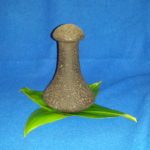 pōhaku ku‘i ‘ai (poi pounder), the one with which Kawena learned how to pound poi as a little girl.
pōhaku ku‘i ‘ai (poi pounder), the one with which Kawena learned how to pound poi as a little girl.
After Po‘ai was buried, Kawena went home with her parents to their home in Na‘alehu, where her mother, Mary Pa‘ahana, continued to teach Kawena the ways of her people. Her aunt and foster mother, Mary Rebecca Pu‘uheana, so grieved over the death of her mother, that she and her husband, Akoni, moved to Puna. About a month later, stones were laid over the three graves, like the paepae, or foundation, of a house. Po‘ai was the first of her generation to receive a Christian burial. Prior to Po‘ai, many generations of Kawena’s ‘ohana, far back into the dim mists of time, were joined with Pele, after death, in the pit of Kilauea. Being of the Ka‘ū fire clan, bones of the deceased were bundled in black and red kapa and taken to the rim of Pele’s home. With ancient rituals and prayers, after midnight, the bundle was thrown into the fire pit. Pele would either accept or reject the remains. If the bundle was thrown back out of the pit, the person was not of her clan. Kawena would talk about this at times and with pride and a twinkle in her eyes, she would remark that none of our family were ever rejected.
In her later years, Kawena related that the most precious time in her life were those years spent with her grandmother, Po‘ai, and would express her gratitude many times, throughout her life to her Haole father who allowed her to be raised by his Hawaiian mother-in-law, Nali‘ipo‘aimoku.
NOTE FROM LA’AKEA: MANY YEARS AGO, MY GRANDMOTHER HAND WROTE MANY OF HER COMPOSITIONS IN AN OLD SPIRAL NOTEBOOK FOR ME TO HAVE. MANY ARE WELL KNOWN, SOME WERE WRITTEN FOR A SPECIAL OCCASSION OR JUJST FOR FUN, AND SOME, LIKE THE FOLLOWING MELE, HAVE NEVER BEEN SET TO MUSIC. AT THE END OF THE MELE, SHE WROTE, ” WRITTEN AS I RECALLED MY LIFE WITH MY GRANDMOTHER.” IT WAS PROBABLY WRITTEN IN THE 1940s OR EARLY 1950s, I THOUGHT IT WOULD BE NICE TO SHARE IT WITH EVERYONE:
HĀNIUMALU
He hali‘a kēia i hiki mai Fond recollection comes to me, No ku‘u home o na la kamali’i Of my childhood home I luna o Ka-pali-wai-‘ole Up on Ka-pali-wai-‘ole I ke alo ‘olu o ke kupuna. In grandma’s gracious presence. ‘Ike aku, ‘ike mai ka nohona Life is a recognizing of each other He laulima a he ka‘ana pū Helping and sharing too O ke aloha o ka hoa kanaka The love for the fellow man Ke ‘ano ia o ia mau lā. Was the way of those days. Ke kipa mai na makamaka When friends come Ka honi no a ke aloha Hawai‘i A kiss was the Hawaiian greeting. He ohaoha ka leo heahea Cheerful were the words of greeting Ka ha‘awina pu‘uwai hamama. The gift of open hearts. Ia au ua nalohia aku That period has passed on ‘ A‘ole na‘e pau loa But not entirely gone. He mea kuluma ke aloha Aloha is a customary thing I ka pu‘uwai o ka Hawai‘i. Imbedded in Hawaiian hearts. E puana a‘e au i ku‘u mele Here I will end my story No ku‘u home o na la kamali‘i Of my childhood days I ka pali o Hāniumalu On the hill of Hāniumalu I ke alo o ku‘u kupuna. In the presence of my grandmother.
*********************
KAWENA 6 YRS. OLD 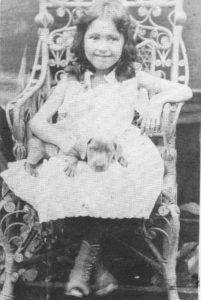
EDUCATION: Kawena’s education by her grandmother started shortly after her birth, but as far as her “formal” education, she attended Catholic school in Waiohinu, where Father Kelekino (Celestino) taught lessons and prayers in both English and Hawaiaian. The one room school held first through eighth grades and Kawena would listen to the older children as they recited their lessons. Because of her retentive memory, it was often Kawena, the baby of the school, standing by herself at the end of a spelling bee. She remembered walking with relatives and friends from Na’alehu to Waiohinu and back, sometimes chewing kukui gum (pilali) gathered from trees on the way.
In 1902, the family moved to Ka-pu‘e-uhi, now known as Glenwood, Puna, in the uplands near Kilauea and Kawena attended Mountain View Public School, traveling to and from school on horseback. Her father had been the assistant to the manager of Hutchinson Plantation, a Mr. Hewitt. A new manager, a German, was hired and Henry did not like the harsh way he treated the workers, so he left, disgusted, and moved his family. Kawena then attendeid Hilo Union School in Hilo, where classes were in English and speaking Hawaiian was prohibited. When Kawena was nine, her father was transferred to Kilauea on Kaua‘i, where Kawena celebrated her 10th birthday, before moving back to Hawai‘i Island when she was eleven, because her mother was ill.
Henry and Pa‘ahana moved to O‘ahu when he was offered a job in Honolulu by a friend and former co-worker at the plantation, Alexander Lindsay, who had moved to Honolulu, studied law and become a judge. He was also Kawena’s godfather. Henry became a baileff in his friend’s court. After Judge Lindsay’s term was up, Henry got a job as a prison guard at O‘ahu Prison. Meanwhile, Kawena stayed on Hawai‘i with an aunt until she joined her parents in Honolulu when she was fourteen, then helped to care for her sick Uncle Ned, her father’s brother, until he passed away.
********
Meanwhile, the German manager of Hutchinson Sugar had been grabbing any land that he thought was not properly documented, and planted sugar cane. He would kill livestock on the land. Some plantation workders had donkeys who had been allowed to roam freely on the plantation. The German didn’t like that and ordered any found loose to be shot and killed. In Honolulu, the Wiggins’ received work that Po’ai’s home, Hale Ola, had been destroyed with all her furniture and the land plowed over, including the family burial ground. The people appealed to Prince Jonah Kuhio Kalaniana’ole, Hawai’i’s delegate to Congress, who put a stop to the land grabbing, but couldn’t undo the damage that was done previously.
Kawena went to Central Grammar School (later named Central Intermediate, now Central Middle School), and Bethel Grammar School. She was later enrolled as a boarding student at Kawaiaha‘o Seminary, also called Kawaiaha‘o Seminary for Girls. 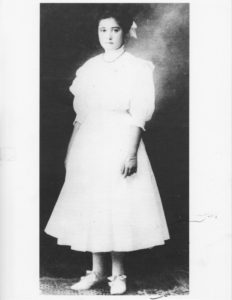 (Very few today know anything about, or even heard of thismissionary school. Kawaiaha‘o Seminary was founded in1864, located on King Street, diagonally across the street from Kawaiaha‘o Church and in 1908, merged with Mills Institute for Boys, founded in 1894. Thirty-five acres of land in Manoa Valley were purchased by the Hawaiian Board of Foreign Missions where both schools were relocated but operated independently, until merging in June 1923, becoming co-educational, and thereafter known as Mid-Pacific Institute.)
(Very few today know anything about, or even heard of thismissionary school. Kawaiaha‘o Seminary was founded in1864, located on King Street, diagonally across the street from Kawaiaha‘o Church and in 1908, merged with Mills Institute for Boys, founded in 1894. Thirty-five acres of land in Manoa Valley were purchased by the Hawaiian Board of Foreign Missions where both schools were relocated but operated independently, until merging in June 1923, becoming co-educational, and thereafter known as Mid-Pacific Institute.)
One day, a girl who had just arrived and didn’t speak or understand much English, asked Kawena for help. A teacher overheard Kawena speaking to the girl in Hawaiian. She was severely reprimanded for such a terrible infraction as trying to help another girl by speaking in the outlawed Hawaiian tongue.
She was also made an example of by being allowed to eat only bread and water for lunch, for an entire week, doing so on a table by herself, in front of all the other students. In addition, she was not allowed to go home to visit her family. She was very hurt by this incident, which caused a deep dislike for the school. Her mother, Pa‘ahana was indignant when she found out what had happened and vowed her daughter would never return to that school after the term ended. She left at 15 years of age, and did not return. She never forgot this incident, recalling with great sadness, the hardship imposed, especially upon children from country areas who knew little if any English, by being punished for speaking their own language, the language of their ancestors, the Hawaiian people.
It is ironic, and yet befitting, that one young Hawaiian girl, who was punished for trying to help another young girl by speaking to her in their mother tongue, grew up to co-author the Hawaiian-English dictionary, the most complete work of the Hawaiian language consisting of 10,000 more words than any previous dictionary, in her effort to preserve her language forever.
*********************************
In 2008, five old trunks were found in the attic of an old house in Berkley, CA that had been forgotten for over 100 years. Amongst the materials were love letters, postmarked from 1890 – 1893 between Carrie PrudenceWinter, a missionary teacher at Kawaiaha‘o Seminary and her fiance, Charlie. Carrie described teaching and living with Hawaiian girls, the often harsh discipline she and her fellow teachers imposed, her struggles with fellow teachers, her meetings with royalty and important figures in Hawaiian society, health issues including leprosy and malaria that impacted her students and the Hawaiian people. She described Hawaiian folklore, the turbulent politics of the time, as well as shocking accounts of clear intent and attempts to suppress the culture of young Hawaiians, by these missionary teachers. In her letters, she told Charlie that she disciplined the girls by placing them in closets or corners, sometimes for extended periods of time; applying corporal punishment by using a whip on the girls’ legs after making them raise their skirts; and sometimes restricting food, as was school policy. The infractions noted in Carrie’s letters included insubordination, theft of food, failure to do assigned tasks, speaking Hawaiian or dancing the hula. These letters provide rare evidence from a primary source that truly confirms the suppression of culture that took place in the Missionary Schools. (from An American Girl In The Hawaiian Islands, U of H press, 2012)
************************************************
A neighbor of the Wiggin family, Laura Green, would visit and was delighted with the stories of old Hawaii told by Kawena and her mother. She recognized Kawena’s memory and ability to translate Hawaiian thoughts into English and encouraged her 15 year old neighbor to write and record her knowledge. Kawena began to write stories and recollections of what she had been taught, including sayings and proverbs. Laura Green also informed her cousin, Dr. Martha Beckwith, a professor of folklore at Vassar College about Kawena’s great knowledge for one so young, eventually bringing the two together. Dr. Beckwith enlisted Kawena’s help in translating, resulting in a publication, Hawaiian Stories and Wise Sayings (Beckwith 1923). 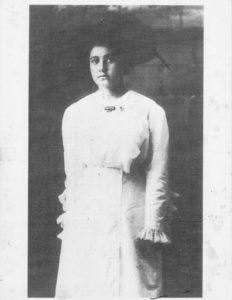 Even though she had started to write and record these things, Kawena wanted to complete her schooling. When she reached the age of 21, the court gave her $400, left to her by her paternal Uncle Ned. She gave her father half and put $200 away until she could buy something she wanted very much, something lasting. Eventually, she decided to invest that money in herself, by getting an education. She was determined, and ignored how unusual it was for a married woman at her age to go to school. She wanted to better be able to write, just for herself, the things she had seen and heard as a child, the stories and ways of her mother’s people.
Even though she had started to write and record these things, Kawena wanted to complete her schooling. When she reached the age of 21, the court gave her $400, left to her by her paternal Uncle Ned. She gave her father half and put $200 away until she could buy something she wanted very much, something lasting. Eventually, she decided to invest that money in herself, by getting an education. She was determined, and ignored how unusual it was for a married woman at her age to go to school. She wanted to better be able to write, just for herself, the things she had seen and heard as a child, the stories and ways of her mother’s people.
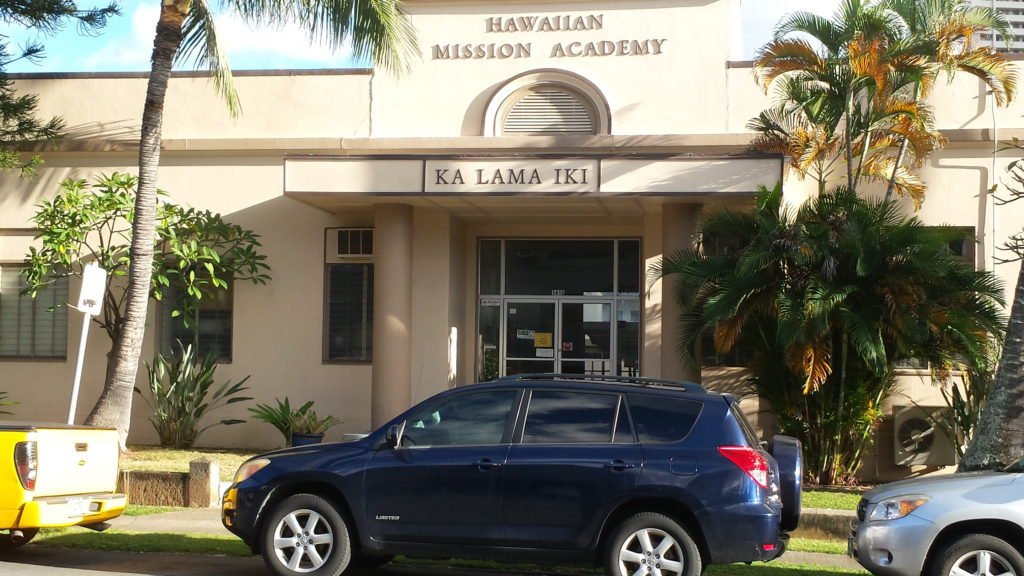
An old friend and teacher, Annie Aiona, was enthused with the idea and so was her mother. The wife of the Adventist Pastor, Theresa Hutchinson, opened a way for her and, with the blessing of her husband, Napoleon Kaloli‘i Pūku‘i, she went back to school, at age 23, and attended the Seventh Day Adventist Hawaiian Mission Academy, the only educational institution who would accept a married student. She received her high school diploma in 1923, when she was 28 years old and had been married for ten years. 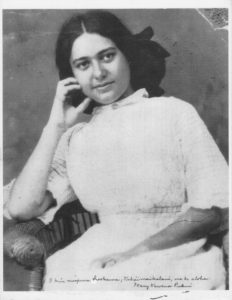 At the end of 1917, as Queen Lili‘uokalani’s funeral procession moved slowly from ‘Iolani Palace to her final resting place, Mauna ‘Ala in Nu‘uanu, Kawena observed everything from a second floor window of the Kapi‘olani Building. She saw the kukui torches burning in broad daylight, a symbol of the Queen being a direct descendent of Iwikauikaua, the hearse being drawn by Hawaiian Po‘ola (stevedores) in two long rows wearing white with white sailor caps and many kahili bearers in black with black hats, her husband Kaloli‘i being one of them.
At the end of 1917, as Queen Lili‘uokalani’s funeral procession moved slowly from ‘Iolani Palace to her final resting place, Mauna ‘Ala in Nu‘uanu, Kawena observed everything from a second floor window of the Kapi‘olani Building. She saw the kukui torches burning in broad daylight, a symbol of the Queen being a direct descendent of Iwikauikaua, the hearse being drawn by Hawaiian Po‘ola (stevedores) in two long rows wearing white with white sailor caps and many kahili bearers in black with black hats, her husband Kaloli‘i being one of them. 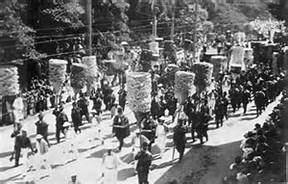 There was beautiful, non-stop Hawaiian chanting by two white-haired grandparents, who had lived through many summers and winters, and who accompanied the procession. When one got tired, the other repeated the last line of the chant and continued from there, all the way to Mauna ‘Ala. One of these chanters was Mary Padeken and the other, Ka-ho‘ale-a-wai Ka-luhi-o-ka- lani, who was a cousin of Kawena’s mother, who lived in Kalihi, across what is now Likelike Highway. The Bishop Museum could be seen from his lanai. One day, when Kawena went to visit him, he chanted a heahea, a welcome to her, as she approached and kissed him on the cheek. He told her to sit in a chair on his lanai, then stood behind her and chanted and prayed.She was then directed to go sit in his dining room where it was quiet and told her that one day, she would work in and love Pauahi’s house. He said she would lead the work there. His young, 22 year old niece expressed her doubts because she “lacked schooling.” It was years later that his prediction became reality.
There was beautiful, non-stop Hawaiian chanting by two white-haired grandparents, who had lived through many summers and winters, and who accompanied the procession. When one got tired, the other repeated the last line of the chant and continued from there, all the way to Mauna ‘Ala. One of these chanters was Mary Padeken and the other, Ka-ho‘ale-a-wai Ka-luhi-o-ka- lani, who was a cousin of Kawena’s mother, who lived in Kalihi, across what is now Likelike Highway. The Bishop Museum could be seen from his lanai. One day, when Kawena went to visit him, he chanted a heahea, a welcome to her, as she approached and kissed him on the cheek. He told her to sit in a chair on his lanai, then stood behind her and chanted and prayed.She was then directed to go sit in his dining room where it was quiet and told her that one day, she would work in and love Pauahi’s house. He said she would lead the work there. His young, 22 year old niece expressed her doubts because she “lacked schooling.” It was years later that his prediction became reality.
******
In 1925 Kawena had a dream in which an old woman, dressed in a holoku and smoking an old pipe, similar to the one her grandmother smoked, walked up to her with tears in her eyes, embraced and kissed her, leaving a very bitter taste in her mouth and throat. She was going to spit it out when the woman told her, “No, no, you must swallow it.” She told her mother about the dream and her mother said nothing until later that afternoon, when Pa‘ahana told her that a duty had been placed upon her to speak for her people but she will taste bitterness at times from opposition, criticism and disappointment. She would spend her life preserving the ways of her ancestors, and must carry on even through the difficult times. She experienced this time and again as she worked to do just that, preserve the ways of her people.
PUNAHOU SCHOOL: In 1937, Jane and Mary Winne asked Kawena to teach a Hawaiian Culture class at Punahou School as part of the elementary social studies class, sometimes aided by her mother and daughters, making classes lively and fun for the students. They were taught to use their hands, making fish nets and other things. she taught them how to count and the order of the Hawaiian moon phases.
******
KAMEHAMEHA SCHOOLS: After Punahou, she taught at the Kamehameha Preparatory Department in 1944, when it was located at Ka-iwi-‘ula, before moving up to Ka-pā-lama heights, its present location. She taught them how to chant. Since standing hula was *despised by the administration, she taught them hula noho, or dancing while sitting. She also introduced conversational Hawaiian *The following information, in part, is from a speech given by Kawika Eyre, Hawaiian language teacher at Kamehameha, in January 2004, entitled, “Suppression of Hawaiian Culture at Kamehameha Schools.” The first principal of the Kamehameha School for Boys, established in 1887, was Reverend William Oleson, who was a member of the committee that forced the “Bayonet Constitution” upon King Kalākaua, greatly limiting and diminishing the authority of the monarchy. One of his first orders was banning the speaking of Hawaiian at the school. Boys were punished for speaking their native tongue and rewarded with prizes, free periods and off-campus passes for not speaking Hawaiian for one month. Interestingly, this banning of speaking Hawaiian took effect at Kamehameha years before it became law for other public and private schools in 1896.
******
The dancing of hula was viciously attacked. Reverend Sereno Bishop, who gave the prayer at the opening of the school for boys, and who maintained a relationship with the school wrote, ” The dance was one of the foul florescenses” on the “great poison tree of idolatry.” Bishop said hula corroded Hawaiians and labeled it moral leprosy. When the Kamehameha School for Girls opened in 1894, the rules against Hawaiian culture were well in effect. The struggle for Hawaiian identity relaxed eventually but it took a very long time. Interestingly, when the school for girls started, many of those attending the missionary school, Kawaiaha‘o Seminary for Girls, left to attend Kamehameha, forcing Kawaiaha‘o to seek the enrollment of other ethnicities in order to survive.
******
Dr. Don Mitchell, who arrived to teach at Kamehameha in 1930, started Hui ‘Ōiwi, a boys’ club formed to learn and demonstrate Hawaiian cultural practices. He became a student of Kawena Pūku‘i and it was she who gave him the name, “Kilolani.” The lessons developed by Dr. Mitchell were first published by K.S. in 1969 as “Resource Units in Hawaiian Culture.” The first paragraph of The Acknowledgements page reads: “The author wishes to express a sincere mahalo to Mary Kawena Pūku‘i, my Hawaiian culture teacher for many years. The results of her delightful sharing form a very special part of the units in this book.”
******
In 1933, Kawena and her daughter, Namaka, did a historic demonstration of traditional hula at a Kamehameha School for Girls assembly. Kawena narrated and chanted keeping rhythm with her ipu, while Namaka, her hair down to her ankles, gracefully performed the dances.
******
During the war years, the school’s newspaper, Ka Mō‘i, ran columns on Hawaiian language, “Na Ha‘awina Hawai‘i. These included a glossary and ten or more sentences in Hawaiian and English. A September 1943 lesson is prefaced: “The Hui ‘Ōiwi is sponsoring this column for the third year with the hope that the Kamehameha students will learn more of the language of their ancestors through these simple, practical lessons. A sincere mahalo nui to Mrs. Mary Kawena Pūku‘i of the Bishop Museum for her invaluable aid.”
******
“News From Boys, Girls Kamehameha School” by Barry Ontai reported on the Saturday, April 22, 1944 activities of the junior division at the boys’ school. Two color movies were shown in the assembly hall, filmed in color by George Tahara, a U.H. student. The first was “A Victory,” a film for the Junior Police Officers on the K.S.B. campus. In the second feature, “Make Way for Victory,” two boys of the Preparatory department, Kealoha Coleman and Kui Lee, had leading roles. There were also dances by the preparatory pupils directed by Mrs. Mary K. Pukui and Mrs. Lei Hapai. (note: Kawena’s daughter, Pele, was also in this film)
******
“News From Boys, Girls Kamehameha School” by Harriette Hurley reported on the 1944 Song Contest. “People who enjoy Hawaiian music have expressed the desire to know the meanings of the Hawaiian songs. Translation of the two prize songs to be used in the Kamehameha School for Girls’ song contest to be held on February 13, appear below. Mrs. Mary Kawena Pūku’i, translator at the Bishop Museum and director of Hawaiian activities at the Kamehameha Preparatory School, has translated the songs. (note: translations of Lei ‘Awapuhi and Pa‘au‘au Waltz followed.)
******
In the spring of 1947, the president, Col. Howard Kent, established a Hawaiian Culture Committee, headed by Don Mitchell, to look into aspects of the culture that could become part of the curriculum. Members of this committee were Rev. Stephen Desha, Mrs. Mary Kawena Pūku‘i, Miss Margaret Titcomb, Miss Beatrice Mo‘okini, Dr, Kenneth Emory, Miss Caroline Curtis and Mrs. Dorothy Kahananui Gillette.
******
“The decade of the 50’s was one of numerous publications – the culture of the written word. The collaboration of Pūku‘i/Curtis produced such titles as “Pīkoi,” “Water of Kane,” and “Tales of the Menehune.”” These published by the Kamehameha Schools Press.
******
“The absolute crowning achievement in Hawaiian cultural publications in the decade of the fifties was the appearance in 1957 of the Pūku‘i/Elbert “Hawaiian Dictionary,” the springboard for so much that has happened in Hawaiian language and culture ever since.”
******
Kawena’s daughter, Pele, was a student at Kamehameha in the late 1940’s when she was suspended by girls’ school principal, Dr. Pauline Fredericks, because she was “caught” dancing hula, standing up, on a float in a parade.
******
In the mid-1960’s the trustees were faced with strong sentiment to remove the ban on dancing hula while standing. Don Kilolani Mitchell, in a letter to the trustees, dated February 16, 1965, expressed the view on this matter from the Bishop Museum. “Knowledgeable staff there recognized that this form of expression was and still remains a dance of grace, beauty and meaning. The story of Hawai‘i could not be understood without it. Mary Kawena Pūku‘i has said for many years that Kamehameha should teach and perpetuate the very best in traditional hula, including the standing forms, and teach the very best versions.”
******
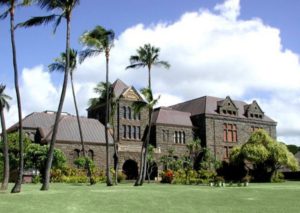
BERNICE PAUAHI BISHOP MUSEUM: Kawena’s long association with the Bernice Pauahi Bishop Museum, “Pauahi’s House,” as her uncle had called it years before, began when she was asked by Dr. Martha Beckwith for assistance in translating old Hawaiian manuscripts and newspapers arounnd 1923. Kawena’s skills soon attracted attention from other noted scholars, anthropologists, biologists, etc., who sought her assistance in their own work. She actually worked helping others at the museum for some fourteen years before she was hired as a translator. According to Sam Elbert, the museum director, Dr. Herbert Gregory, didn’t want to hire any Hawaiians because he said he had some kind of problem with a former hire. It was only after a new director, Sir Peter Buck (Te Rangi Hiroa), a part Maori, was hired that she was put on the museum payroll in 1937. Museum ethnologist, Dr. E.S.C. Handy actually paid her out of his own pocket for her help, which was extensive. 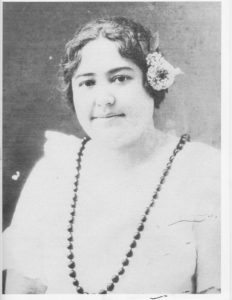 In 1933, Dr. Handy was interested in therapeutics and enlisted Kawena’s help. He had been introduced to Kawena by Jane Winne. Kawena translated manuscripts and added new information from her knowledge, combined with that of her mother, Pa‘ahana, and other Hawaiian friends, culminating in the publishing of The Outline of Hawaiian Physical Therapeutics, Handy and Pūku‘i in 1934. The names, Handy and Pūku‘i would appear on other notable works in years to come. In 1935, Dr. Handy told Pa‘ahana that he and his wife were going on a field trip to Hawai‘i and would like Kawena to go with them. Pa‘ahana gave them her blessing and knowing that her people would not talk to foreigners, she said she would hanai (adopt) them. “Now go with your sister to my homeland,” she said.
In 1933, Dr. Handy was interested in therapeutics and enlisted Kawena’s help. He had been introduced to Kawena by Jane Winne. Kawena translated manuscripts and added new information from her knowledge, combined with that of her mother, Pa‘ahana, and other Hawaiian friends, culminating in the publishing of The Outline of Hawaiian Physical Therapeutics, Handy and Pūku‘i in 1934. The names, Handy and Pūku‘i would appear on other notable works in years to come. In 1935, Dr. Handy told Pa‘ahana that he and his wife were going on a field trip to Hawai‘i and would like Kawena to go with them. Pa‘ahana gave them her blessing and knowing that her people would not talk to foreigners, she said she would hanai (adopt) them. “Now go with your sister to my homeland,” she said.
***
Ho‘okahi no ‘ohana o Ka‘ū, Offshoots of one lineage are the people of Ka‘ū,
Mai ka uka a ke kai, From the uplands to the sea, Mai kahi pae a kahi pae. From border to border.
***
Ka‘ū lepo ‘ulaula (Ka‘ū of the red earth) Said of the natives of old Ka‘ū who were one family. The people, proud of their homeland and selves intermarried until they were of one blood, and as one with their beloved homeland.
***
KA‘Ū, KUA MAKANI (Ka‘ū of the windblown back) The people of Ka‘ū, unlike all the other districts of these islands, have always considered themselves to be of one family. This southernmost district of Hawai‘i Island was also the most rugged area to survive in, creating hardy people and fierce warriors. Ka‘ū breeded strong-minded individualists. The district of Ka’u also had the singular distinction of disposing of their chiefs if they were tyrannical, abusive, greedy or ignored the welfare of the people.
This was the Fire Clan of Ka’ū. Ka‘ū makaha (Ka‘ū of the fierce fighters) Known for fierce and independent warriors. Rebellious subjects killed abusive chiefs, like Kohaikalani, Koihala and Hala’ea.
****
Hilina’i Puna, kalele ia Ka’u, Puna trusts and leans on Ka’u, Hilina’i Ka’u, kalele ia Puna, Ka’u trusts and leans on Puna The ancestors of these two districts were originally of one extended family. There came a time when each ditrict desired to have a name of their own without breaking their familial link. The people of Ka’u called themselves the Makaha, while those of Puna called themselves the Ku-makaha, as mentioned in the old chants of the chiefs of Ka’u.
****
Kawena descended from ali‘i and kahuna and her family was extensive, throughout Ka‘ū, Hilo, Puna, and Kona. They were able to gather much information as the word spread about Pa‘ahana’s adopting the Handys, who accompanied Kawena, child of Ka‘ū. Many doors of family and their friends were opened for then. However, there was an elderly aunt of Kawena’s, Keli‘ihue, who was still reluctant to share her knowledge, until an ancestor came to her in a dream and very sternly ordered her to go and reveal all she knew. She and Kawena’s mother, Pa‘ahana actually became the primary sources for most of the information gathered. This material became important works in the years to come, resulting in The Hawaiian Planter, Volume 1 (E.S.C. Handy, in collaboration with Mary K. Puku’i 1940) and The Polynesian Family System of Ka‘ū, Hawai‘i (Handy and Pūku‘i, 1958) and Native Planters in Old Hawai‘i, Their Life, Lore and Environment (Handy and Handy with Pūku‘i, 1972)
[In later years, Dr. Handy would refer to Kawena as being 50% Haole and 100% Hawaiian.]
During this field trip, near Kiolaka‘a, above Waiohinu, Ka‘ū they saw a beautiful food patch but no house near it. They were curious to find out who the owner was. One morning they saw an old man there, stooped and leaning on a heavy cane. He was friendly, kind and gladly led them around his food patch and answered their questions. He had tall sugar cane, bananas, neat rows of sweet potatoes and many varieties of taro growing. When he had answered all their questions, he had some of his own. He asked Kawena where was she born, who were her parents, etc. She said she was born in Ka‘ū and mentioned her mother’s name. He shook his head in non-recognition. He asked, “And your grandparents were whom?” When she mentioned her grandmother’s name, he asked if she was the Nali‘ipo‘aimoku who lived at Waikapuna beach and when Kawena confirmed that she was, he immediately began to wail out loud. He was her cousin but had moved to Kona before Pa‘ahana was born, so didn’t recognize her name. In the ancient custom, the old man wailed naming hills, beaches, legendary spots, rocks, ancient warriors, etc, all mentioned in poetical terms. How Kawena wished she had some way to record his wailing because the custom was dying fast with the older folks and she knew it wouldn’t be long before it was heard no more.
They traveled by rented station wagon which the Handys slept in at night, while a pup tent was set up for Kawena next to the car. One night, in the Kawaihae area, as Kawena was sleeping, she was awakend by rocks being thrown on her tent. She thought it was probably some of her cowboy cousins who came by to visit. When she looked outside, however, there was no one there. She lay down to go to sleep again when her pillow was pulled from under her head and thrown across the tent. She said in Hawaiian, “Leave me alone.” A voice responded, “I will not. It’s only 1:30.” Kawena knocked on the station wagon door and asked if she could sleep on the front seat. When she lay her head down, she glanced at the clock on the car dash which read 1:31 A.M.
When Kawena returned to Honolulu, she told her mother that she was shocked, saddened and a little puzzled at how things had changed from her childhood days in Ka‘ū. Where they once lived, Kapu‘euhi, was now called Glenwood and there were names like Mountain View. The Hutchinson Plantation had taken over the lands they once lived on; Po‘ai’s beloved home, Hale Ola, where Kawena was born, had been bulldozed and sugar cane replaced their former home. Rocks were piled on the family graveyard. Upon hearing this, Kawena’s mother, Pa‘ahana, was so saddened that she vowed never to go home again, not wanting to see what Kawena had described.
******
The following is from chapter VI of “The Polynesian Family System of Ka‘u, Hawai‘i.”
“A Hawaiian’s oneness with the living aspect of native phenomena, that is, with spirits and gods and other persons as souls, is not correctly described by the word rapport, and certainly not by such words as sympathy, empathy, abnormal, supernormal or neurotic; mystical or magical. It is not “extra-sensory,” for it is partly of-the-senses and not-of-the-senses. It is just a part of natural consciousness for the normal Hawaiian – a “second sense,” if you will, like the Keltic “second sight” -but it is not “sight” only, or particularly, but covers every phase of sensory and mental consciousness. Psychic, in its original Greek meaning as referring to that which related to the soul, is the word that we prefer to use.”
Some years after this field trip, Kawena had several dreams in which pieces of a mele called, “Lono-hali‘i” were given to her. She chanted it to her uncle once and he got up and called out, “Kawena, your grandmother used to chant that. Where did you learn it?”
******
When Kawena’s daughter, Pele, was about 5 years old, she was running around, blowing on a tin horn. She slipped and fell with the horn in her mouth and the sharp-edged mouthpiece got lodged in the roof of her mouth and started bleeding heavily. They did not have a phone and tried to stop the blood and prayed. A man knocked on the door and identified himself as a doctor. He said he was walking on King Street, near where it crossed Birch Street, when a woman in a mu’umu’u told him to hurry down Birch street to the Puku’i house on the corner. She told him they needed his help immediately. He attended to Pele, who healed from the deep cut. Who was the women that stopped the doctor? No one knows. Kawena and her mom just said it was an angel, answering their prayers.
********
Kawena once wrote a letter to her grandson that was living on the mainland at the time. In the letter, she wrote that she had a dream that she was at a beach and saw a little girl playing with some sea shells in the sand at the water’s edge. A couple of old ladies walked with her to look at the little girl when one of them said, “Her name is Kauilaokalani and she is the image of you. Then she said, “We have told your daughter this several times, but she can never remember when she awakens.” When this letter was received, her grandson had just found out that his wife was expecting and they hadn’t had time to tell anyone yet. Kauilaokalani (Lightning in the sky) was born nine months later, bearing the same features as her great grandmother.
******
One night, Kawena had a dream that two whales were swimming very fast towards each other and collided, which woke her from her sleep. A short while later, she received a call that her daughter, Pele, had been in a car accident and was in the hospital. Pele recovered after a stay in the hospital.
******
Pele had earlier given birth to a son and mentioned to an elderly Hawaiian woman friend that she was fortunate in having her son born “circumsized.” The woman immediately exclaimed, “That comes from your mother’s side of the family!” Pele went to see her mother and asked what did her son being born “circumsized” have any connection with the family. Kawena explained that it was the Hawaiian belief that ‘ohana of the Pele clan may be born “circumsized” and if so, are under the protection of Pele’s beloved older brother, Kamohoali‘i, lord of the sharks.
******
When Pele was in high school, she, some friends and a cousin, Richard Papa went driving up the Old Pali Road. It was pitch black outside as the teenagers playfully dared Pele to do a chant, to add to the spooky nature of their surroundings. Pele, being young, proceeded to do a chant she had learned about her namesake, the fire goddess. All of a sudden a big fireball came roaring down the road towards the car and went skimming right over it, The youngsters screamed and took off down the road. Pele never did that again.
******
Kawena had much aloha for her relatives and was close to a kinsman, George Kawaha, a former sheriff of Ka’u, who lived in Waiohinu. He was much older than her, but because he belonged to a younger generation George always respectfully called her “aunty.” Although he was not sired by his father, Luhi, (done at the advice of a kahuna to allow his mother to have children, which she was unable to do before this) as far as Luhi was concerned, George was his eldest son and the two were very close. There came a time when Luhi was in a home to be taken care of. George told Kawena that he was napping one day when he heard his father beside his bed tell him, “Is that all you have to do this fine day?” George awoke but there was no one there. His phone rang and it was the home saying his father had just passed away. George said, “In death, as in life, my father always turned to me first.” Kawena had taken her grandson, La’akea, to meet his uncle when on a field trip in 1960. Years later, the two were home alone when the phone call came that George had passed away. She cried on La’akea’s shoulder for a long time.
******
When Kawena was a little girl, during one of their travels, her grandmother, Nali’ipo’aimoku accidentally stumbled onto the property of a powerful kahuna. The ground held her fast and she couldn’t move. It was only because of her knowledge and prayers to her ‘aumakua that Po’ai was released from its hold so the two could continue on their journey.
******
Another time, there was a gathering at her home at Kapu‘euhi when a small white dog appeared and played around with the children. Kawena remembered following after the dog, going down the driveway away from the party when the dog stopped, looked at her and then disappeared from tail to head. She ran to tell the older people what she saw and was told about the white dog stories connected with Pele. These kinds of occurrences are just confirmations of her existence was what she was told.
******
Kawena and her family lived on Birch St. and kept her pahu (drum) in a closet. Every once in a while the drum would beat by itself, signalling that someone would soon come to the house to ask them to dance hula somewhere.
**************
Kawena also taught Hawaiian language at the Bishop Museum then later, at the YWCA and after that, at her home. She taught adults who were interested in learning the language. Among her haumāna (students) were well-known Bishop Museum anthropologist, Dr. Kenneth Emory, Jack Waterhouse of Alexander & Baldwin and Samuel Elbert, University of Hawai‘i professor of linguistics, who eventually collaborated with Kawena in the creation of the Hawaiian-English dictionary, Edwin Burrows and Birdie Reist, a close friend of Kawena’s for many years. 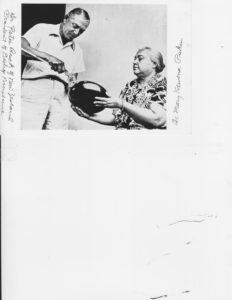 Kawena with museum director, Sir Peter Buck (Te Rangi Hiroa), who joined the museum as a researcher in 1927 and later becoming its director until his death in Dec. 1951. Kawena officially became a staff member of the Bishop Museum when she was hired as a translator in 1937. She spent the next 25 years there, except for a brief period during World War II, when she was recruited to be a forelady at the Waikiki Camouflage Unit, being that the workers there were Hawaiian, many of them lei sellers from Mauna Laha, a Hawaiian settlement in upper Makiki and also from Kalihi. WAIKIKI CAMOUFLAGE UNIT
Kawena with museum director, Sir Peter Buck (Te Rangi Hiroa), who joined the museum as a researcher in 1927 and later becoming its director until his death in Dec. 1951. Kawena officially became a staff member of the Bishop Museum when she was hired as a translator in 1937. She spent the next 25 years there, except for a brief period during World War II, when she was recruited to be a forelady at the Waikiki Camouflage Unit, being that the workers there were Hawaiian, many of them lei sellers from Mauna Laha, a Hawaiian settlement in upper Makiki and also from Kalihi. WAIKIKI CAMOUFLAGE UNIT  Honolulu Star-Bulletin photo 1-31-1942 “Mary Kawena Pukui, left, Hawaiian translator at Bishop Museum, explains to Primrose Kinolau how to make camouflage nets for the U.S. engineers. They will be used to hide gun emplacements and air raid warning stations on Oahu. More than 150 Hawaiian women, many of them former lei sellers, are working on the project “somewhere on Oahu.”
Honolulu Star-Bulletin photo 1-31-1942 “Mary Kawena Pukui, left, Hawaiian translator at Bishop Museum, explains to Primrose Kinolau how to make camouflage nets for the U.S. engineers. They will be used to hide gun emplacements and air raid warning stations on Oahu. More than 150 Hawaiian women, many of them former lei sellers, are working on the project “somewhere on Oahu.”
**********
By the late 1940’s, Kawena had established a reputation as an expert in things Hawaiian and was an eloquent and accurate informant. The August 1963 Ka ‘Elele, the Bishop Museum News, noted, “Adrienne Kaeppler and H. Arlo Himmo wrote: ‘Most field workers today are not so fortunate as to have informants such as she (MKP), who would not only fully answer the interrogator’s questions, but pose questions he did not think to even ask..'” While at the museum, she authored, co-authored, translated, or otherwise assisted in many publications that have become key resources. She was determined to preserve the Hawaiian culture so that her mo‘opuna and others of the coming generations would know about their people, who they were, where they came from and how they lived.  KAWENA SHOWING A HUEWAI TO HER COUSIN, EMILY TAYLOR AND AND DAISY McKEAGUE AT THE BISHOP MUSEUM Speaking of where we came from, back in the 1940’s Kawena disagreed with the scientists, of that time, who
KAWENA SHOWING A HUEWAI TO HER COUSIN, EMILY TAYLOR AND AND DAISY McKEAGUE AT THE BISHOP MUSEUM Speaking of where we came from, back in the 1940’s Kawena disagreed with the scientists, of that time, who 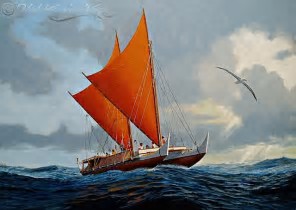 deemed it impossible that Polynesians navigated the Pacific using the stars. Many subscribed to Thor Heyerdahl’s theory of currents bringing Polynesians from Peru and others said it was Asia, but nevertheless, was totally accidental, mandated by ocean currents Heyerdahl’s Kon Tiki expedition of 1947 was expected to prove his theory. Kawena argued that the ancient chants told the stories of the great navigators and migrations throughout Polynesia. They didn’t beliieve it then, but it has been proven and the world now knows the ancient stories (na mo‘olelo kahiko) to be true, as proven by Hokule‘a.
deemed it impossible that Polynesians navigated the Pacific using the stars. Many subscribed to Thor Heyerdahl’s theory of currents bringing Polynesians from Peru and others said it was Asia, but nevertheless, was totally accidental, mandated by ocean currents Heyerdahl’s Kon Tiki expedition of 1947 was expected to prove his theory. Kawena argued that the ancient chants told the stories of the great navigators and migrations throughout Polynesia. They didn’t beliieve it then, but it has been proven and the world now knows the ancient stories (na mo‘olelo kahiko) to be true, as proven by Hokule‘a.
******
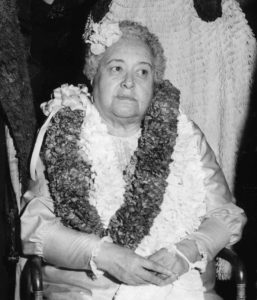
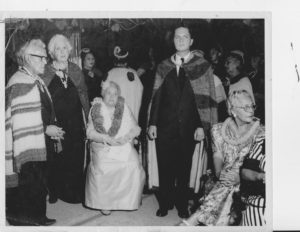
The First
DAVID MALO AWARD
1957
L to R: David “Daddy” Bray, unknown, Mary Kawena Puku’i, unknown, unknown
******
Kawena would sometimes say to her grandson, “La‘akea, you have a stubborn grandmother.” After asking her, “Why grandma?” she would say, “Stubborness channeled in the right direction is determination, and in the wrong way is just being obstinate.” One can only imagine where our culture would be today if she had succumbed to the criticisms of others.
AT WQRK AT THE MUSEUM, WITH FRANCES FRAZIER. 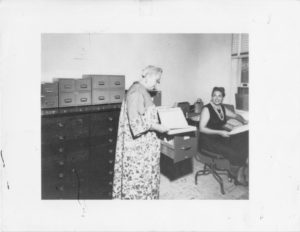
Kawena came to understand the world of academia, but she clearly maintained her own priorities. In 1958, she was asked for a summary of her year’s contributions, to be included in the Museum’s Annua Report. It was to be “concise, but in sufficient detail to present an adequate picture of activities and accomplishments.”
The suggested outline listed five topic headings. Kawena totally ignored three of them. She responded to two, as follows:
Work for the year, including staff and volunteer assistance a. Work completed (blank) b. Work in progress: Translations, tape recordings, giving information c. Field work: none d. Publications: none e. Plans for future work: Same as work in progress.
Relations with the public, including a. Assistance given institutions and individuals: Plenty! b. Talks given: University of Hawaii (Carey Miller) c. Publicity material furnished: Plenty! d. Visitors to the department: Also Plenty! e. Work on exhibits: Information. Upon completion of this important report, she signed it in ink Then she picked up her pencil, turned back to the yellowed and fragile newspaper on her desk and went back to translating.
************
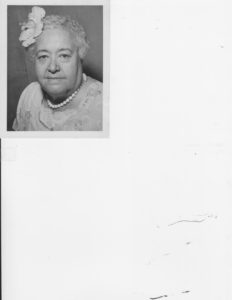 Adrienne Kaeppler, who was an anthropologist at the Bishop Museum in the 1970’s, and is currently Curator of Oceanic Ethnology at the National Museum of Natural History at the Smithsonian Institution in Washington, D.C., has written that “Kawena was the preeminent source on Hawaiian culture for nearly half of the twentieth century, and no thorough work on Hawaiian history or culture can be written or understood without reference to Kawena’s vast writings and oral traditions.”
Adrienne Kaeppler, who was an anthropologist at the Bishop Museum in the 1970’s, and is currently Curator of Oceanic Ethnology at the National Museum of Natural History at the Smithsonian Institution in Washington, D.C., has written that “Kawena was the preeminent source on Hawaiian culture for nearly half of the twentieth century, and no thorough work on Hawaiian history or culture can be written or understood without reference to Kawena’s vast writings and oral traditions.”
********
One day, a young haole scientist went to see Kawena with a paper she had written about a cultural topic. He sat down in front of her desk with the paper in his hand and said, “Mrs. Pūku‘i, this is all fine and well, but where is your documentation??” She stood up and looked at the young man and said, “I AM the documentation.”
********
KAWENA AND ELLIE WILLIAMSON RECORDING AN INFORMANT  In addition to the above, Kawena, along with her assistant, staff member and companion, Ellie Williamson, traveled throughout the islands, from Kaua‘i to Hawai‘i, interviewing older folks about their lives, memories, thoughts and experiences, recording these discussions on a small, portable reel-to-reel tape recorder, that was considered high tech in those times. These many recordings remain in the museum archives, a record of the lives and times of those recorded, preserved for posterity. During a field trip to Hāna, Maui, Kawena approached three Hawaiian women who were reluctant to speak to the wahine haole (Caucasian woman) from the Bishop Museum in Honolulu. Kawena greeted them thusly: “He aloha no Ka‘uiki, o ka ua Laniha‘aha‘a o Hāna.” (Beloved Ka‘uiki, the rain-of-the-low-sky-of-Hāna) The women were delightfully surprised and told Kawena they had not heard that kind of Hawaiian since the old days of political rallies. “You speak high-class Hawaiian,” said one of the women. Besides interviewing others, she aske her daughter, Pele, who had studied traditional chanting with Malia Kau and Namakahelu, well-known chanters from Moanalua, O‘ahu, to record material for the Bishop Museum. In 1965, she recorded her own thoughts. “I am now exchanging knowledge with those interested in Hawaiians, themselves, their thinking pattern, the why of their behavior. I tell them of the old and they tell me of the new and together, we learn. I like to learn, even if I am over three score and ten…Because I know my mother’s language, I’ve enjoyed exchanging thoughts with other Polynesians to discover our alikenesses and our differences. And because I know my Father’s, I can explain to others what we have had here and lost and what we still retain.” After every trip, Kawena and Ellie would spend many hours transcribing the tapes, Ellie typing and Kawena translating. These tapes and transcriptions are a treasure, housed in the Bishop Museum’s archives for all eternity. In 1960, Kawena took her grandson, La‘akea, on a field trip to her home island of Hawai‘i. She gave him a composition book and told him to keep a journal of their travels. The three of them traveled to many places. Kawena interviewed folks, Ellie ran the tape recorder and La‘akea kept quiet and listened. La‘akea’s journal was found over forty-five years later amongst Kawena’s things. Here is the trip through the eyes and thoughts of a ten year old boy:
In addition to the above, Kawena, along with her assistant, staff member and companion, Ellie Williamson, traveled throughout the islands, from Kaua‘i to Hawai‘i, interviewing older folks about their lives, memories, thoughts and experiences, recording these discussions on a small, portable reel-to-reel tape recorder, that was considered high tech in those times. These many recordings remain in the museum archives, a record of the lives and times of those recorded, preserved for posterity. During a field trip to Hāna, Maui, Kawena approached three Hawaiian women who were reluctant to speak to the wahine haole (Caucasian woman) from the Bishop Museum in Honolulu. Kawena greeted them thusly: “He aloha no Ka‘uiki, o ka ua Laniha‘aha‘a o Hāna.” (Beloved Ka‘uiki, the rain-of-the-low-sky-of-Hāna) The women were delightfully surprised and told Kawena they had not heard that kind of Hawaiian since the old days of political rallies. “You speak high-class Hawaiian,” said one of the women. Besides interviewing others, she aske her daughter, Pele, who had studied traditional chanting with Malia Kau and Namakahelu, well-known chanters from Moanalua, O‘ahu, to record material for the Bishop Museum. In 1965, she recorded her own thoughts. “I am now exchanging knowledge with those interested in Hawaiians, themselves, their thinking pattern, the why of their behavior. I tell them of the old and they tell me of the new and together, we learn. I like to learn, even if I am over three score and ten…Because I know my mother’s language, I’ve enjoyed exchanging thoughts with other Polynesians to discover our alikenesses and our differences. And because I know my Father’s, I can explain to others what we have had here and lost and what we still retain.” After every trip, Kawena and Ellie would spend many hours transcribing the tapes, Ellie typing and Kawena translating. These tapes and transcriptions are a treasure, housed in the Bishop Museum’s archives for all eternity. In 1960, Kawena took her grandson, La‘akea, on a field trip to her home island of Hawai‘i. She gave him a composition book and told him to keep a journal of their travels. The three of them traveled to many places. Kawena interviewed folks, Ellie ran the tape recorder and La‘akea kept quiet and listened. La‘akea’s journal was found over forty-five years later amongst Kawena’s things. Here is the trip through the eyes and thoughts of a ten year old boy:
August 1960
My Field Trip to Hawaii
Sun. 14 Spent the night with grandma so as to be ready to go the next morning. Mon. 15 Uncle Ka‘upena and Auntie Ellie met us at grandma’s house and Uncle Ka‘upena took us to the airport. We left Honolulu at 9:45 A.M. and made a brief stop at Kahului airport; arrived in Hilo at 11:25 A.M. Asked the stewardess, Mary Pua‘a, how fast we were going and she said that we were going at the rate of 260 M.P.H. We had a U-Drive car waiting for us at the airport. The first place we visited was a Hawaiian village in Keaukaha. There were three grass houses that were built by the people that lived in that area. One house had a green vine growing over the thatch. One house had lost half of its thatching, and the third house had none at all. Nearby was a pavilion where two Hawaiian ladies were making seed leis. They told grandma and Auntie Ellie all about the tidal wave. They said that the sea washed away the bridge to Coconut Island (Moku Ola). Later we saw debris, broken houses and buildings at Waiakea. We saw Chinese banyan trees at the Naniloa Hotel planted by celebrities such as Babe Ruth, the Cisco Kid and many others. We had lunch near Kai Palaoa where Kamehameha first pronounced the Mamalahoa law. We spent the afternoon visiting relatives, many of them. We spent the night at the Cunningham Hotel. Tue. 16 Took a walk with Auntie Ellie this morning to see if any stores were open. None were, so we walked to the Wailuku river, and looked up at a small waterfall near an electric power house. We also walked to Pu‘ueo and saw a marker at the entrance of an ancient heiau that stood there, named Pinao. The Naha stone once stood there. Auntie Ellie also showed me the Naha stone, which Kamehameha overturned. It was prophesied that if he succeeded in doing that he would be the ruler of the islands. Aftr breakfast, we bought groceries, then left a picture at Uncle Louie’s house. On the lanai was a sign, “Take off shoes, no smoking.” Hilo is a beautiful place with flowers, ferns, and trees. For the first time, I saw lehua trees, manyof them. We stopped a little while at Glenwood where grandma showed me the farm and house they lived in, over fifty years ago. She pointed out the places where the flowers and trees grew. Japanese own it now, and the only things we saw were weeds and grass. At the museum in the Kilauea National Park, we were just in time to hear a lecture and see a movie. Then we walked around to see the exhibits. The stuffed animals were very interesting. After that we rode to the Kilauea Iki lookout where we had lunch. The new cinder cone there is named Pu‘u Pua‘i. It was made in the latest flow there, about two years ago. Auntie Ellie and I walked into Thurston’s lava tube, and she showed me some interesting plants, mau‘u, la‘ili or “tatoo grass,” pa‘iniu and others. We heard the calls of native birds too. After this we rode around Kilauea crater. Halema‘uma‘u was full of steam and I could smell sulphur. The wind was very strong near the rim. I was glad to see the volcana bird, the koa‘e, fly within the crater.
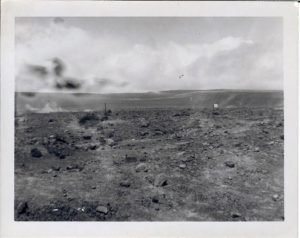
We went up to Uwe-kahuna. The smoke of Halema‘uma‘u blew in every direction except there. We drove down to Punalu‘u, a black sand beach in Ka‘ū. I walked with grandma to Pūhau, the largest and coldest spring in the whole district.
In Na‘alehu, grandma pointed up to a hill where she was born. The spot was called Hā-niu-malu,and is located in Kau-nāmano .
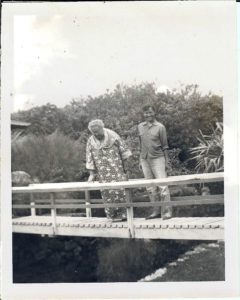
When we arrived in Wai-o-hinu, we stopped to see Uncle George Kawaha. Grandma told me that her mother and his grandma were sisters. He is an old man about 74 years old. He gave me a package of big red mangos. We stopped at Uncle Willie Meinecke’s. He is an old family friend. My bedroom is between Auntie Ellie’s and grandma’s. For the first time, I saw and smelled a heliotrope. Wed. 17 This morning the thermometer read 60 degrees. This is a cool place. I tasted poha’s this morning, and had honey in a comb this noon. After breakfast we went to Na‘alehu to make a tape recording of Ku‘umi Kin In, and his cousin, Kalama Kahape‘a. It was too rainy this afternoon to go anywhere. Grandma had asthma and I rubbed her back with deep heat.
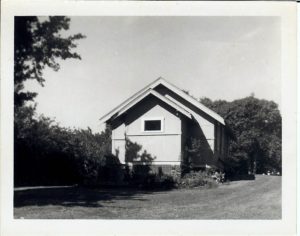
Thurs. 18 This morning the thermometer read 66 degrees. I got up very early because it was cold. After breakfast, Uncle Willie took grandma and I to Uncle George’s house. then he went to look for a man named Ka-welau-o-ke-kapu Kua‘ana, who was going to make a tape with us. Uncle George told me stories about his father, Luhi Kawaha, and his maternal grandfather, Kaho‘omana, who was a lua expert. His stories are very interesting. After that Auntie Ellie, Grandma, and I went to the Na‘alehu School where they made a second recording of Ku‘umi Kin In and Kalama Kahape‘a. After we were through recording Ku‘umi’s wife came and she invited us to go to their house that night. After supper, we all went to Ku‘umi’s new home. He was so happy because the electric light was installed just before we arrived. We made another tape recording that night. Mrs. Kin In is the namesake of grandma’s cousin, Alice Ka‘ainoa Horswill. This cousin was the stepmother of Auntie Ellie’s father. Fri. 19 We went to Ka‘alu‘alu to make a recording of Ka-welau-o-ke-kapu Kua‘ana. Kapu was
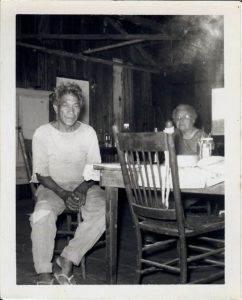
very kind and gave us one bag of salt and Auntie Ellie and me a hi‘a each.
From there we went to Kalae, stopped above Ka-‘ala-a-ka-menehune (trail of the menehune). Grandma promised to tell me the story of that place.
It was windy at Kalae, I took a picture of a fish God behind Kalalea heiau. It was a heiau to attract ‘ōpelu. Some fishermen at Kalae caught a shark. After that we went to Palahemo. It is a large and deep waterhole. The old Hawaiians said, “If you haven’t seen Palahemo, you haven’t seen Ka‘ū.” We also went to Pu‘u Ali‘i where we found human bones. Uncle Willie and I buried them. At Kealai, we went into the first cave I had ever entered in Ka‘ū. I came home tired but happy. Sat. 20 Before leaving Waiohinu, we went to see Uncle George. He and Uncle Willie are very interesting persons. After that we went to the Kiolaka‘a Homestead where a recording of Mr. Otto Breithaupt was made. Then we rode to Manukā Park where grandma and I walked around until she became sick with asthma. Just as we were leaving, Ma Keppeler, her son, Jack, and his family and her daughter arrived. A short ride later and Ka‘ū was left behind. On the way to Auntie Rosalie’s we visited Ho‘okena and The City of Refuge, which is in Honaunau. At the City of Refuge, grandma sat down and wrote while Auntie Ellie and I went for a swim. After that we went to Keauhou, where grandpa Pūku‘i was born. There we saw a stone memorial for Kamehameha the third. He was born dead and placed on the stone. Kapihe, a kahuna, prayed and brought him to life. Then we drove to Cullin’s Place to see an ancient heiau. We are now staying with Aunty Rosalie on the grounds of the Hulihe‘e Palace. On the right hand side of the house is Ki‘ope Spring, where royalty used to bathe after being in the sea. On the left hand side of the house is a grass house where Princess Ruth’s son lived. That night, Auntie Ellie, Auntie Rosalie, and I, drove to Ahu‘ena and Kamaka honu. Here, Kamehameha lived and died. We slept on the lanai of Auntie Rosalie’s cottage. Grandma and I shared one pune‘e. Sun. 21 This morning Auntie Ellie and I went horseback riding. This afternoon, she and I went swimming.
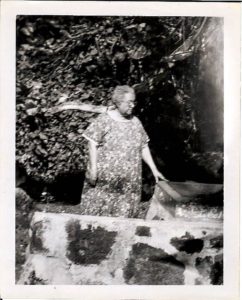
Keauhou, Kona
Mon. 22 Fed the fish this morning and then raised the flag for Auntie Rosalie.
After breakfast, we rode to Kawaihae where grandma pointed out Pu‘u Koholā and Maile Kini heiau. We met Albert Nahale-ā at the park and went looking for his granduncle, Mahealani Lono I-mahi-la‘a, whom everyone calls Mahea Lono. The old man is a hundred years old. A recording was made of him. Tonight we made a recording of Mary Ha‘anio of Keauhou. She knows so much about fishing and planting. After she left with her family, Auntie Rosalie asked us to go to Alice Brown’s farm for fruits and to Napo‘opo‘o for fish. We got back at midnight. Tues. 23 Fed the fish in Ki‘ope Pond this morning, before leaving for the airport. I like Ka‘ū where grandma was born and Kona where grandpa was born. After we arrived, grandma bought me new shoes (for school).
****
Even before being officially hired by the Bishop Museum, Kawena Pūku‘i had established a relationship with professionals and researchers at the museum who sought her assistance in their work. During her years at the museum, Kawena became the “go to” person for anything Hawaiian. Her time and expertise was always in demand. In the June 2015 issue of The Journal of the Polynesian Society; in an article by Adrienne Kaeppler, entitled, “TWO HAWAIIAN DANCERS AND THEIR DAUGHTERS,” she stated: “The academic works of E.S.C. Handy and Martha Beckwith depended largely on the work of Kawena. She was also a primary source for the works of Dorothy Barrěre, Kenneth Emory, Adrienne Kaeppler Alphonse Korn, Margaret Titcomb and many others.”
Back in July of 2003, La’akea asked DeSoto Brown about the extent of his grandmother’s works in the museum archives. He responded as follows:
1) The Hawaiian Ethnographic Notes (HEN) consist of 8,000 to 9,000 pages of Hawaiian writings gathered from newspapers, old manuscripts, material from other researchers and verbal communications. He said, “I think she tried to find as wide a range as possible of topics.” 2) The Helen Roberts Collection contains thousands of pages of transcriptions of cylinder recordings made in the early 1920’s. She went through these, making corrections and transcriptions. 3) The Vivienne Mader Collection. Mader, from New York, studied hula here in the 1930’s and was taught by both Kawena and Helen Desha Beamer. This collection contains mele lyrics and translations passed on to Mader by Kawena. 4) She also found original writings of John Papa Ii, gathered and translated them. An edited version version was printed as “Fragments of Hawaiian History.” “There are also various papers in the Staff Collection and many other papers from her throughout the entire collection among manuscripts of staff, like Dr. Emory and others.” DeSoto concluded with, “So you see, there’s a huge amount. The Hawaiian Ethnographic Notes, of itself, probably takes up 30 to 40 boxes, but now you have an idea of the scope of her work.” He also expressed wonderment that one person could do so much work in one lifetime. La’akea recalled that his grandmother said she would have to live several more lifetimes to complete all the work she wanted to do.
********
Kawena shunned the spotlight and humbly accepted the many awards of recognition and accolades and then continued to do her work. She would be pleased to know that her work made a difference. In an interview (Honolulu Star-Bulletin, Feb. 26, 1975) Kawena said, “My main role at the Bishop Museum was scribbling down my brainstorms. Whenever I remembered something, I wrote it down , or we recorded it before I could forget it.” Kawena retired from the Bishop Museum in 1962, leaving a tremendous body of information, translations. academic publications, chants, songs, tape recordings, etc. Work that she did at the museum continued to be published years after she retired, as well as after her passing in 1986. During her lifetime, she unselfishly helped numerous other researcher, authors, songwriters, etc. in their own work. It is truly mind-boggling to realize the volume of work that was done by one very special individual who desired to preserve her culture for those who would follow.
******
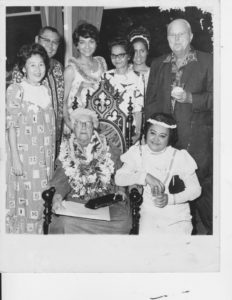
Ho’omau I Ke Ike Award, State of Hawai’i for Preservation of Hawaiian Language, Arts and Culture 1969 PAT NAMAKA BACON, MKP, PELE PUKU’I SUGANUMA;BACK ROW ED UKISHIMA, NAOMI LOSCH, LOTTIE UKISHIMA, CHARLEEN SIMONSON, JACK WATERHOUSE ELLIE WILLIAMSON, ADRIENNE KAEPPLER, MKP, KU’ULEI IHARA BACK ROW; KEKUNI 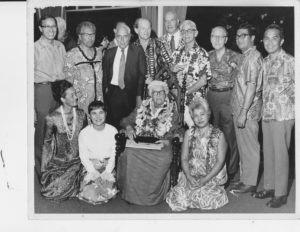 BLAISDELL, DOROTHY KAHANANUI, SAM ELBERT, DON MITCHELL, ?, DR. kENNETH EMORY, ?, ? GEORGE KANAHELE UNKNOWN EVENT
BLAISDELL, DOROTHY KAHANANUI, SAM ELBERT, DON MITCHELL, ?, DR. kENNETH EMORY, ?, ? GEORGE KANAHELE UNKNOWN EVENT
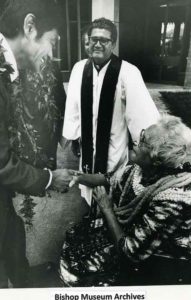
Rev Abraham Akaka
KA ‘ELELE, the Bishop Museum staff newsletter reported: “At a reception given in her honor on June 10 (1974) in the State Capitol rotunda, Dr. Mary Kawena Pukui, Associate in Hawaiian Culture, Emeritus, was presented an award of the Order of Distinction for Cultural Leadership for her outstanding achievements as a Hawaiian scholar, researcher, teacher, translator, linguist, composer, and lecturer. The reception was sponsored by the State Council on Hawaiian Heritage and the State Foundation on Culture and the Arts. Acting Governor George Ariyoshi made the presentation of the award, which has been given to only two other persons. Dr. Pukui’s association with the Museum began in 1938 and continued beyond her official retirement in late 1961. She has translated hundreds of Hawaiian Language sources into English; and tape recording of her interviews with Hawaiians who recalled the ancien ways of their people have provided the Museum with a wealth of ethnological materials that would otherwise have been lost. She is especially noted for her definitive and authoritative Hawaiian-English Dictionary and English-Hawaiian Dictionary, done in collaboration with Dr. Samuel H. Elbert, Professor of Pacific Languages and Linguistics at the University of Hawaii. She was awarded an honorary Doctor of Letters degree from the University of Hawaii in 1960 and an honorary Doctor of Arts and Letters from the Church College of Hawaii (now Brigham Young University, Hawaii Campus) in April of this year.
********
POLYNESIAN CULTURAL CENTER: Kawena was asked to help in the planning of the Hawaiian section of the Polynesian Cultural Center in La‘ie. For its dedication, held in October of 1963, leaders from Samoa, Tonga, Fiji, Aotearoa, Tahiti, etc were gathered. Kawena represented Hawai‘i.
CHURCH COLLEGE (BYUH – Brigham Young University Hawai’i): There is a dormitory on the campus of Brigham Young University Hawai’i, (previously called Church College), named for her. Church College bestowed upon Kawena a doctor of arts and letters on April 9, 1974.
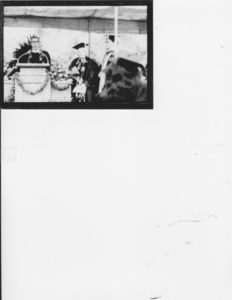
*UPDATE: When requesting a picture of Hale Pūku‘i, La‘akea was informed that subsequent Mormon presidents of the school had the names of the dormitories changed to Dormitory “X”, with “X” being numbers. Later, attempting to be more Polynesian, the names were changed to Hale “X”. Hale Pūku‘i no longer exists.
‘ OHANA (FAMILY): Kawena married Napoleon Kaloli‘i Pūku‘i (whose original name of Kapūku‘i changed when he eliminated the “Ka”) in 1913. They were childless and Kawena wanted children, so considered adopting. but Kaloli‘i wanted only children of his own. The flu epidemic of 1920 took many lives, including the Japanese parents of a Kaua‘i family, leaving the children as orphans Eventually, all but one, a two month old girl, the youngest, were adopted. Kawena took one look at her and wanted the remaining baby for her own. Because of her husband’s refusal, her father stepped in and Kawena’s parents legally adopted the child and gave her to Kawena to raise as her own. [Interestingly, during this time, the Hawaiian Humane Society handled the adoptions of animals and orphans] Kawena’s father gave her the name, Patience Elmay, and her mother contributed NamakauahoaoKawena‘ulaokalaniikiikikalaninui, an inoa kuamuamu and inoa pō combined. The family called her Pat, Namaka, or just Maka. Once the child was part of the family, Kaloli‘i forgot all of his original objections and became fond of her, carrying her about on his shoulders when he went to gamble, calling her his good luck charm. When Kawena wanted to expand her family a year or so later, in 1921, her parents adopted a Japanese-Hawaiian orphaned girl and named the child Faith Charlotte Kalama, who with Namaka, were raised as sisters and daughters of Kawena and Kaloli‘i, who became fond of both. ****** In 1943, Kawena had asked Jack Waterhouse to host the people from the Waikiki Camouflage Unit at his property, Mauna Lahilahi, for a day of fun and relaxation. Kaloli‘i told Kawena to get him a knife to pick ‘opihi (limpet). He was a grumpy sort of guy, but befpre he turned to walk around the point where the rocks held the delicacy he intended to gather, he told her, “You’ve been a good wife to me, never being frivolous and picking your friends wisely,” He walked away and later on a boy ran up to the house and said an old man was sick and fell in the water. Jack told Kawena to wait there and upon return said,, “Kawena, you are a widow.” Kaloli‘i had always said he wanted to die in the ocean. His father had disappeared from his canoe while fishing with his grandfather and Kaloli‘i had an older brother who was born a shark. He got his wish that day. In later years, when Kawena studied hula under Keahi Luahine and Joseph Ilala‘ole, it was Namaka who went along with her and became an excellent dancer and especially valuable and knowlegeable resource after the passing of her mother. 

It was February 27, 1931, after 18 years of marriage, when Kawena gave birth to their daughter, Pelehonuamea, who became a beautiful dancer, taught by her mother and older sister, Namaka and Joseph Ilala‘ole. She was also a beautiful chanter, studying under Malia Kau and Namakahelu of Moanalua. Her performances along with ho‘opa‘a and relative, Ka‘upena Wong, a student of Kawena’s, were memorable. She performed dances no longer seen today. She died suddenly of a heart attack on February 15, 1979, at the state capitol after chanting to introduce Edith Kanaka‘ole, who was receiving an award from then Governor, George Ariyoshi. Among those in attendance were current MKPCPS board members, Kumu Hulas Kaha’i Top;olinski, Cy Bridges and Hardy Spoehr, Director of Papa Ola Lokahi , who immediately applied CPR until medical personnel took over. (Hardy’s father, Alexander Spoehr, was appointed President/Director of the Bishop Museum in January 1953, after the death of Sir Peter Buck and served for nine years before leaving to become chancellor of the newly organized East-West Center. Affectionately known as “Alika,” Ka’upena Wong wrote the “Alika Spoehr Hula” in his honor) Pele’s wake was held at the Mormon church on Beretania St. Kana’e Keawe, close family friend, cultural expert, lecturer, considered by many to be Hawai’i”s finest craftsman and current board member of MKPCPS flew in from Hilo with a beautiful lei wili made of liko lehua, palapalai, ‘ohelo, etc., big enough to surround the casket. Early the next morning, as we arrived for the funeral service, Kana’e nudged La’akea and told him to look at the lei. because the buds that were picked should remain buds and mature no further, but they were in full bloom around the casket. “That’s scientifically impossible,” he said. Pele always said she wanted to be buried in a volcano. ” As we made our way to Punchbowl Cemetery, a sudden downpour of rain, like tears from heaven, was so heavy, that water rushed down the road like a river. As we arrived at the gravesite, the rain suddenly stopped and the sun broke through the clouds, ” noted La’akea.. A grand niece of Kawena’s, Fanny Kamakolu Leong was sent to Honolulu from Hilo to live with Kawena and her family because there were too many of them and the parents had to ask relatives for help. She was the same age as Pele and they grew up together until Kamakolu, in her teens, decided to leave the Pūku‘i household and return to Hilo. Faith (Lottie) married Edwin Ukishima and had Charlotte, Paulie, Irwin and Nathan (Butch); Pat (Namaka) married George Bacon and had Mary (Dodie); and Pele married Bernard Kauhale Suganuma, who was a police officer (retired as a major), born and raised in Papakolea, and had Leighton La‘akea, Elton Kailoa (Tui)and Lawton Pūku‘I.
**************************************
Following Hawaiian tradition, this kanikau for Pele by Kaha’i Topolinski, Kumu Hula of Ka Pa Hula Hawai’i, teacher, cultural expert, family friend,, who learned fromf Pele, Namaka and Kawena, and was a hanai grandson, composed on February 22, 1979.
HE KANIKAU NO PELEHONUAMEA PŪKU‘I SUGANUMA
Ka holo ua makani he aloha nui Ke aloha i wili ʻia me ka ʻeha i ka makani. Ka nā‘ū o ka ua he aloha kū a kāne Pāwali me ka ua lani kū wahine. A he ua lani ʻalo na pua no ha Eia ka ua me ke anu me ʻaneʻi. Anuanu i loko o ka wai, pio ka leo ʻO ke anu, ka ua Waʻahila he hoʻomaʻū. Aloha wau iā ʻoe e kuʻu kumu Auē, auē, ua hala, ua hala kuʻu hoa. ʻO ka welina o ko leo nahe, kuʻu hoʻomanaʻo Hoʻomanaʻo wale mai no me ʻaneʻi. He hoʻomanaʻo mau i ka pua lei momi Ke kumu aloha-lilo ē-ʻohi e! Ua haku ʻia e KahaʻialiʻiokaiwiʻulaoKamehameha Topolinski February 22, 1979 The moving rain sends a thought of great love| A love woven with sadness is borne by the breeze. The rain sighs of its love to men, And whispers of its love to women. It is the heavenly rain blowing among the flowers, tells that showers and coldness are here. Chilled is the heart, unable to speak Cold, as if long-soaked in the rain called Wa‘ahila. Great is my love for you my beloved teacher Alas, alas, my friend has passed from earthly life. It is your pleasant voice that is remembered It will always be recalled here (in my heart). Remembered always is the lovely strand of pearls My beloved teacher is gone! Taken away! Composed by Kaha’i Topolinski, February 22, 1979
**********************
‘Ahahui Māmakakaua, Sons and Daughters of Hawaiian Warriors (lit. Warriors’ Society): Kawena and Pele were members of this genealogical society. The following picture is from the early 1970s. 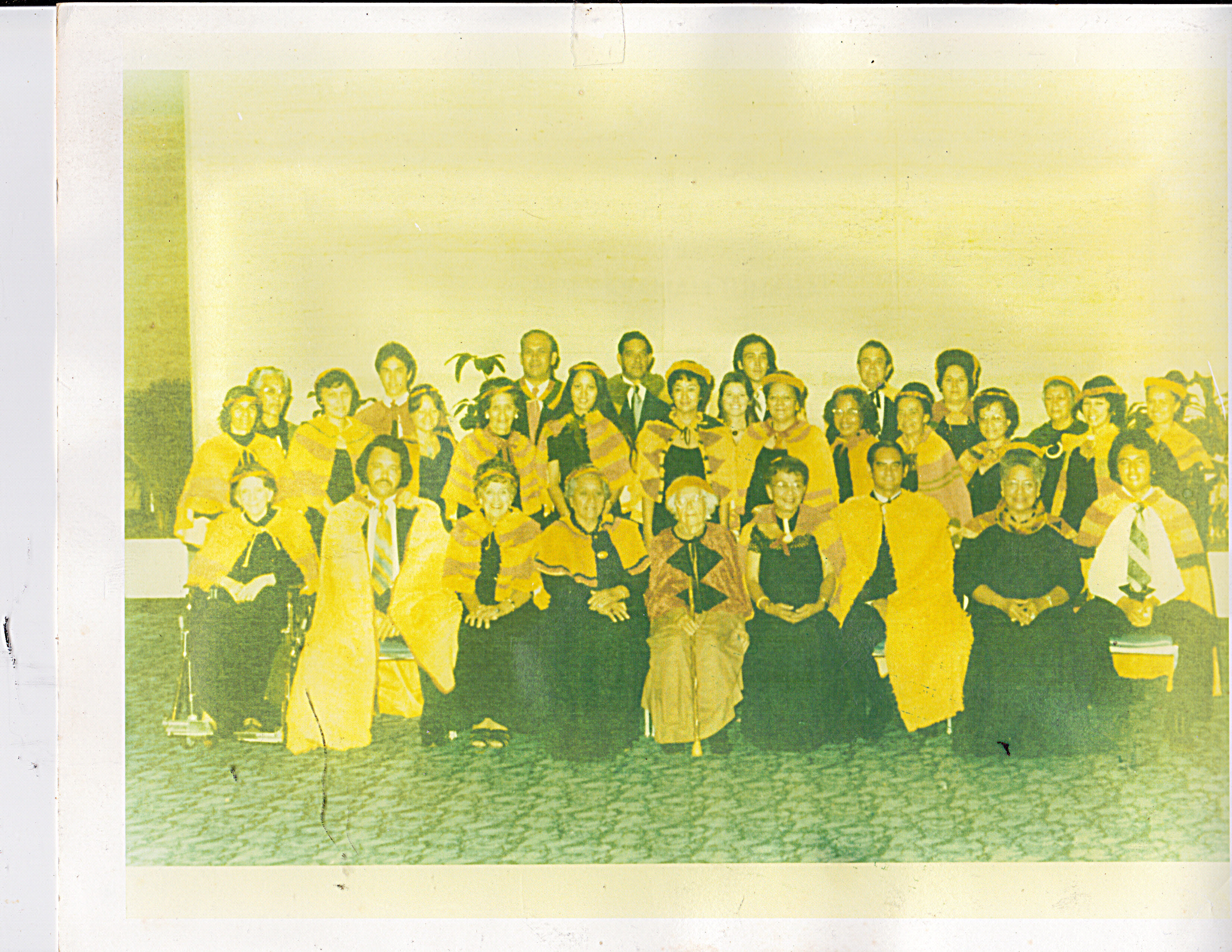 Front Row L to R:O Leemaster, H Malani, H Kell, R Baker, MK Puku’i, H Doane, J Woolsey, T Malani, C Malani Middle Row: S Keahi, T Black, S White, ER Kaeck (Adams), B Rodrigues, Y Lefcourt, F Fung, O Salazar, H Salazar, I Kaeck, H Ayat, B Teresa Last Row: E Flatean, C White, T Pratt, L Taylor, W O Martin, C Robinson, A Ladiera, C Clarke
Front Row L to R:O Leemaster, H Malani, H Kell, R Baker, MK Puku’i, H Doane, J Woolsey, T Malani, C Malani Middle Row: S Keahi, T Black, S White, ER Kaeck (Adams), B Rodrigues, Y Lefcourt, F Fung, O Salazar, H Salazar, I Kaeck, H Ayat, B Teresa Last Row: E Flatean, C White, T Pratt, L Taylor, W O Martin, C Robinson, A Ladiera, C Clarke 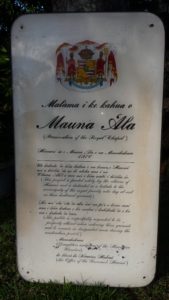 This large plaque, translated by Kawena is at Mauna ‘Ala (The Royal Mausoleum) has been with the caretakers for years. The translation is below.
This large plaque, translated by Kawena is at Mauna ‘Ala (The Royal Mausoleum) has been with the caretakers for years. The translation is below.
Malama I ke kahua O Mauna ‘Ala (Preservation of the Royal Chapel) Hoʻonani ia o Mauna ‘Ala e na Mamakakaua 1976 Ua kukulu ʻia keʻia kahua e na kama O Hawaiʻi nei a hoʻolaʻa ʻia no ke aloha ana I na ʻOhana Aliʻi e moe nei I keʻia wahi i hoʻolaʻa ʻia. (This project is funded solely by the citizens of Hawaiʻi and is dedicated as a tribute to the sovereignty of the royal family who lay at rest on these hallowed grounds.)
,Ke noi ʻoluʻolu ʻia aku nei na poʻe e komo mai ana i keʻia kahua a ke makai i kuhikuhi ʻia i ka wa e kukulu ʻia ʻana (The public is respectfully requested to be properly attired when entering these grounds and to remain in designated areas during the construction period.) Mamakakaua (Daughters and Sons of the Hawaiian Warriors) ke Keʻena ke Kiaaina, Hawaiʻi (The Office of the Governor, Hawaiʻi)
******************************
QUEEN LILI‘UOKALANI CHILDREN’S CENTERS: It was in 1962 that Kawena was approached by Richard Paglinawan from Q.L.C.C. about a case he had with a Hawaiian family that had to do with deep-seated Hawaiian beliefs. She agreed to help and the case was solved. She was asked to meet with the Hawaiian Culture Committee of the Queen Lili‘uokalani Children’s Center, which met weekly.. The committee consisted of Dr. Marian Haertig, psychological consultant, Richard Paglinawan, Grace Oness, William Apaka Jr. and Betty Ann Rocha, chair. The meetings would also be attended by young part-Hawaiian social workers who would run into situations with Hawaiian families that they didn’t completely understand and/or which the Western training they had received could not embrace. What Kawena thought was intended to be a short term, maybe a month or two, relationship turned into weekly meetings that continued for over sixteen years, resulting in the publication of Nana I Ke Kumu, volumes I and II. Tūtū Kawena would share her knowledge of Hawaiian beliefs, customs and practices which helped to solve the problems faced by Hawaiian families. Her help and involvement had a positive effect on the social workers, themselves, who not only were able to better serve their clients, but were further instilled with a sense of pride in themselves and their heritage. The first page of Nana I Ke Kumu II reads:
Ka Mana‘o, Ka ‘I‘ini, A Me Ka Makia The Thought, The Wish, And The Purpose
Mamuli o ke aloha, a mamuli he mea pono i na Hawai‘i e ‘ike, i na mea maika‘i o hope, ka nani o na mele, a me ke aloha o na kūpuna ua kākou ‘ia kēia buke.
Because of love, and because it is well for Hawaiians to know the good things of the past, the beauty of the chants, and the love of the ancestors, this book was written.
Mary Kawena Pūku‘i
In 1971 QLCC was selected to head research into the ancient Hawaiian practice of Ho‘oponopono (To make things right,) and to expand existing knowledge of this Hawaiian practice as a possible therapeutic approach with Hawaiian families, as suggested by Dr. Hirobumi Uno of the Office of the Governor and was enthusiastically encouraged by Masaru Oshiro, Q.L.C.C. Director.. An Advisory Council made up of representatives of the University of Hawai’i School of Social Work, the Department of Social services and Housing, Child and Family Services, the Department of Hawaiian Home Lands and Queen Liliʻuokalani Children’s Center. The research was headed by Lynette Paglinawan of Q.L.C.C. Tutu Kawena, being familiar with this practice, guided those involved, explaining the process and the specific steps taken to “make things right.” ‘Ohana (family) was of utmost importance in the Hawaiian culture, the root of one’s existence and it was important that any problem be resolved and “made right.” This ancient process of resolving any problems within the family received much attention, even prompting international inquiries from researcherss, psychologists and psychiatrists who would contact Tutu Kawena, wanting to know how this practice worked. Ho’oponopono also received much attention here at home, sometimes misunderstood and taking on cult-like appearances in some circles. Other times it was used, with good intentions, to resolve any kind of problem resulting in discussions and/or debates without resolution. Ho’oponopono was a means to identify a problem(s), and untangle, forgive and keep things within the ‘ohana intact. Forgiveness, unlike today, was not an option because people understood that if one would not forgive, one’s ʻaumākua would turn their backs when that person sought forgiveness. When Kawena was a young child, she watched her grandmother set up ho‘oponopono whenever there was conflict in the family, Following a specific procedure, everyone would speak openly and freely and children were never excluded. Sessions would last as long as necessary, ultimately ending with forgiveness given and received, with prayers. At the conclusion of ho‘oponopono, everything was ‘right’ within the family. After Po‘ai passed away, Kawena’s mother, Pa‘ahana, carried on the tradition.
********
HULA, THE DANCE OF THE HAWAIIAN PEOPLE:
Kawena Pūku‘i’s deep desire to preserve things Hawaiian extended far beyond research and publication involved in the world of academia. She was raised with chant and dance all around her and came from a long line of exceptional practitioners of the art of hula. Kawena loved the poetry, chants and dances of her people. In 1933, she had dreams that she must preserve and pursue the dances she had learned from and of her own family. Later in that year, a demonstration/lecture of traditional hula at Kamehameha Schools, by her and daughter, Patience Namaka, was deemed historical. Kawena lectured and chanted, using her ipu, while Namaka, with her long flowing hair almost touching the floor, gracefully presented traditional dances from the past This performance was at a time when the long-standing rule forbidding dancing hula standing up was still very much enforced at Kamehameha and remained so, for another thirty-plus years. 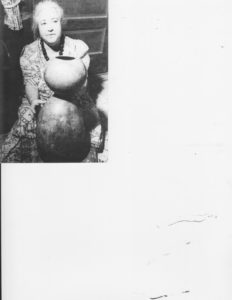 Kawena was born into a family rich in the traditions of, and knowledgeable about, Hawai‘i’s dance form….hula. Her grandmother, Nali‘ipo‘aimoku was a dancer in the court of Queen Emma and it was her duty to teach her mo‘opuna punahele the dances and chants of her people. From a very young age, Kawena was taught by her grandmother, mother, aunts and other relatives. For many years after the coming of the Christian missionaries, hula was looked down upon and discouraged. In remote areas, like Ka‘ū, dancing continued, somewhat secretly. Kawena remembered folks “dancing freely when among themselves, but sitting still and trying to look dignified when a native minister or a foreigner was in their midst.” Latter rulers like Queen Emma and King Kalākaua were accepting of hula, however. Kalākaua’s Coronation in 1883 and Jubilee in 1886 encouraged the participation of hula practitioners from all the islands. In 1942, Kawena wrote, “The hula is a general name for many types of Hawaiian folk dances. Some originated in one locality and spread to others. some were peculair to one island, while others belonged to a whole group but had many versions. A Kaua‘i and a Maui troupe might dance to the same song or mele and yet be different in many ways. Most of the ancient hulas are gone for all time, although many remain.” “When every island had its own ruling chiefs, hula dancing was practiced by chiefs and commoners, by old and young. Dancers of one locality vied with those of another and many localities gained a reputation for having excellent dancers. A good hula master was always found in the court of his chief. There were dances for everyone; standing dances for those whose limbs were young and spry and sitting dances for those who preferred to sit, like the aged and over-plump.” She continued,” Many of our folk dances are gone for all time. A few, due to the courage and interest of some of our people, remain to us today, but are not commonly seen. The ‘ōlapa, a tune danced to the gourd beat, the ‘ulī‘ulī (in which a featheed gourd rattle is used), the pū‘ili (with a split bamboo rattle) are still fairly common, but many others are not. Among those seldom seen now are the hula ‘ala‘apapa, a more dignified gourd dance; the hula pahu, with the big drum; the hula pahu and pūniu, with the big drum and small coconut shell drum; the hula kā-la‘au, or treadle board, peculiar to Kaua‘i; and the ‘ili‘ili, a sitting hula timed to the clapping of two smooth pebbles held adroitly in each hand. There were likewise the turtle dance of Maui, hula honu; the pū‘eke in which two dancer tossed small gourds back and forth between them like playing ball; the hula kuolo, for musicians with gourds; the hula manō or shark dance; the hula kōlea or plover dance; the hula lele kawa, an Oahu dance of diving off from the back of the big whale that came to get the prophet Makuakaumana; the hula pahua, or spear dance; the hula pa‘i umauma, beating the chest; the hula kilu, on Kaua‘i with both pahu and pūniu; the hula ‘ōniu, top spinning; the hula ki‘elelei and kolani, two very obscure dances. Kawena said that men were the first dancers, with the women following later, but “When men did not care to learn the old dances any more, it was the women who learned and saved them for us. Innumerable were these dances and meles now lost to us, but for the remaining fragments we are deeply grateful to those who preserved them. To the women who learned the dances that the men were forgetting, I also give my mahalo nui.”
Kawena was born into a family rich in the traditions of, and knowledgeable about, Hawai‘i’s dance form….hula. Her grandmother, Nali‘ipo‘aimoku was a dancer in the court of Queen Emma and it was her duty to teach her mo‘opuna punahele the dances and chants of her people. From a very young age, Kawena was taught by her grandmother, mother, aunts and other relatives. For many years after the coming of the Christian missionaries, hula was looked down upon and discouraged. In remote areas, like Ka‘ū, dancing continued, somewhat secretly. Kawena remembered folks “dancing freely when among themselves, but sitting still and trying to look dignified when a native minister or a foreigner was in their midst.” Latter rulers like Queen Emma and King Kalākaua were accepting of hula, however. Kalākaua’s Coronation in 1883 and Jubilee in 1886 encouraged the participation of hula practitioners from all the islands. In 1942, Kawena wrote, “The hula is a general name for many types of Hawaiian folk dances. Some originated in one locality and spread to others. some were peculair to one island, while others belonged to a whole group but had many versions. A Kaua‘i and a Maui troupe might dance to the same song or mele and yet be different in many ways. Most of the ancient hulas are gone for all time, although many remain.” “When every island had its own ruling chiefs, hula dancing was practiced by chiefs and commoners, by old and young. Dancers of one locality vied with those of another and many localities gained a reputation for having excellent dancers. A good hula master was always found in the court of his chief. There were dances for everyone; standing dances for those whose limbs were young and spry and sitting dances for those who preferred to sit, like the aged and over-plump.” She continued,” Many of our folk dances are gone for all time. A few, due to the courage and interest of some of our people, remain to us today, but are not commonly seen. The ‘ōlapa, a tune danced to the gourd beat, the ‘ulī‘ulī (in which a featheed gourd rattle is used), the pū‘ili (with a split bamboo rattle) are still fairly common, but many others are not. Among those seldom seen now are the hula ‘ala‘apapa, a more dignified gourd dance; the hula pahu, with the big drum; the hula pahu and pūniu, with the big drum and small coconut shell drum; the hula kā-la‘au, or treadle board, peculiar to Kaua‘i; and the ‘ili‘ili, a sitting hula timed to the clapping of two smooth pebbles held adroitly in each hand. There were likewise the turtle dance of Maui, hula honu; the pū‘eke in which two dancer tossed small gourds back and forth between them like playing ball; the hula kuolo, for musicians with gourds; the hula manō or shark dance; the hula kōlea or plover dance; the hula lele kawa, an Oahu dance of diving off from the back of the big whale that came to get the prophet Makuakaumana; the hula pahua, or spear dance; the hula pa‘i umauma, beating the chest; the hula kilu, on Kaua‘i with both pahu and pūniu; the hula ‘ōniu, top spinning; the hula ki‘elelei and kolani, two very obscure dances. Kawena said that men were the first dancers, with the women following later, but “When men did not care to learn the old dances any more, it was the women who learned and saved them for us. Innumerable were these dances and meles now lost to us, but for the remaining fragments we are deeply grateful to those who preserved them. To the women who learned the dances that the men were forgetting, I also give my mahalo nui.”
****
One day in 1934, a woman appeared at Kawena’s door, quite agitated and distraught. She said her name was Keahi (Keahinuiokaluaopele) Luahine (1877-1937) and that she had been told in dreams to seek out Kawena Pūku‘i and teach her the old Kaua’i hulas that she had been taught. Keahi said she resisted for quite some time, not wanting to appear bold or forward, but her night visitors were increasingly adamant about her doing what she was told because Kawena would be the one to preserve these dances that would otherwise be lost. They became angry at her to the point where she knew better than to ignore them any further. Thus began a serious period of study for Kawena under Keahi, who also became a friend and learned informant, taking along 13 year old Namaka with her.
Keahi was a very traditional person, following the way she had learned, including setting up the kuahu, the altar, necessary for instruction. The proper initial offerings were obtained, Kumu fish for Kawena and ‘Ama’ama for Namaka. Along with the kuahu were strict and ancient kapu placed upon the two haumāna (students) . ) from sunrise to sunset, when they would have to eat ‘ama‘ama (mullet) from head to tail. All scraps were wrapped in ti leaves and white cloth, then weighted down by a rock and depositied in the ocean, after dark, by Kaloli‘i, Kawena’s husband. Also, before beginning each lesson, exercises to loosen the hips and lower body were practiced.
Kawena concentrated on the role of the ho‘opa‘a (chanter and musician) and her daughter, Namaka, was the ‘ōlapa, (dancer), although they each learned both roles. When they first started, Keahi was not pleased with the stiffness of Namaka. Keahi said she “danced like a monkey on a string.” Keahi had a dream in which she was told how to eliminate the problem, Keahi stood behind Namaka with her hands on Namaka’s shoulders and made her ami, rotate her hips, as Keahi firmly and slowly pushed down, while chanting, until Namaka was seated on the ground. When she was done, Namaka stood and danced with softness and grace from then on. Keahi was not only pleased by Namaka’s dancing, she expessed her joy at Namaka’s unusually retentive memory, which was helpful years later in preserving the dances. Keahi taught the way she was taught, holding a thin bamboo stalk used to swat Namaka’s ankles if she didn’t dance correctly Keahi taught them ancient dances of Kaua‘i such as; the Hula Pele (goddess of the volcano); Hula Hoe (paddle); Hula Ki‘i (images); Hula ‘Ilio (dog); Hula Pua‘a (pig); Hula Kala‘au (wood sticks); Hula Kuhi (gesture of honor) and others. The dances employed the use of the ipu (gourd), the pahu (drum), papahehi (treadleboard) and ka la‘au (wooden sticks). Besides hula, Kawena inquired as to practices and ceremonies that Keahi freely shared with her student. At one point in their training, Keahi told her students to get their paddles ready, as she was going to teach them a hula hoe, which she never did. Later, when Kawena visited her on Kaua’i, Keahi showed it to Kawena to see how much she could catch. Kawena got some, but not all of it. When she got home, she had a dream of an old woman, dressed in white, standing by the wet cave called “Ka-wai-o-Kanaloa” and told Kawena about her canoe that went within the cave many years ago and said, “I want you to ride it too. Some people look down at mud, but I want you to look up at the sun. You see, I have put my white hat on your head. You may not feel it, but it is there.” Kawena looked up and sure enough, there was a white hat with the rim covered with small, fine writings. Then she smiled and taught Kawena the following mele. Ku’u wa’a e, holo ku’u wa’a, My canoe – my canoe sails on, Holo ku’u wa’a pololo i ka ‘ino o Puna e It sails and weathers the storms of Puna . O Puna ka ‘aina noho a ka wahine, Puna is the land where the Woman dwells, Wahine i ka ‘iu ‘o na mauna. The Woman who dwells on the summit of mountains Nona ka wa’a i ‘ike ‘ia, Her canoe is very well known, I hho’okele kapu ia e ke kaikunane, It was steered with kapu by her brother. Ua ‘ike a. This is so. Kawena repeated this mele to Keahi and she was so startled that she burst into tears. She said one of her tutu, a very large man, always used this mele-pule, continuously, when her brother went out to catch turtles at Wanini, until he returned. It was an old, old mele for Pele and was used for the hula hoe, or canoe-paddling hula. Thus did Kawena learn a hula hoe, mai ka po mai, out of the night/unseen world. By 1936, Keahi was satisfied that her students had learned all she wanted to teach them and were qualified to present those dances in her tradition. She graduated her two students with the hu‘elepo ceremony, in which they performed all that they had learned, followed by the eating of luau and ‘ama‘ama. Keahi then chanted to free them to go learn elsewhere. Before Keahi released them as haumāna (students), freeing them to go elsewhere to learn, she restricted any teaching of the family dances she had taught them to two pupils, ‘Iolani Luahine who would eventually become one of Hawai‘i’s premier dancers, and Pele Pūku‘i, Kawena’s daughter, when she was old enough. Keahi was the grand aunt and foster mother of ‘Iolani Luahine. ‘Iolani, during her young years, was known as a comic dancer, but when she got older and became serious about her hula heritage, it was Kawena and Namaka who taught her, confirming the reason that Keahi was told to seek out Kawena, so that the ancient dances of her family line would not be lost and would continue. Any one else could only be taught if theree was agreement betwee ‘Iolani, Kawena and Namaka.
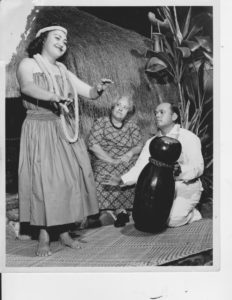
Keahi then sent Kawena and Namaka to her cousin (who was also then living on Oahu), Kapua, who was taught by his father, Kapuanui, a hula master from Hanapepe Valley. Kapua was a strict taskmaster. He never gave out any kind of study aids, never went slowly line by line or pointed out the rhythm and or beating pattern changes.. He would chant non-stop for two hours and it was up to the students to follow. He had a fiery temper and if the student didn’t learn, it was because of the student’s lack of concentration. With his explosive temper and demands, he was difficult to get along with, but Kawena said his mastery of the ipuwai (hula gourd) was unparalleled. Kawena and one other man were in the ho‘opa‘a class. Kapua disliked Kawena trying to learn what Kapua felt was a man’s part being that men were the ho‘opa‘a in ancient times. Much to his dismay,Kawena was determined and continued her study as ho‘opa‘a, and was eventually a hu‘elepo graduate of Kapua. Meanwhile, Namaka studied the dance, sometimes taking her five year old sister, Pele, to learn with her. On January 31, 1936, Keahi danced and Kawena narrated a demonstration of ancient hulas of Kaua‘i for the Kaua‘i Historical Society at Lihu‘e, Kaua‘i. The day after the program, Keahi and Kawena went to the end of Haena Rd. to Ke-ahu-a-Laka heiau, dedicated to Laka, goddess of the hula. Kawena chanted, while Keahi looked for signs. Kawena had long suffered with asthma and didn’t have a strong voice but a sudden mist appeared surrounding Alaka‘i,above the heiau, which Keahi said, indicated that Kawena was a teacher. To commemorate this occasion, when her grandson, La‘akea, was born years later, Kawena also gave him the name, Ka-noe-o-Alaka‘i (The mist of Alaka‘i). Kawena and Namaka then went to study under Kawena’s cousin and uncle, Joseph Keali‘iakamoku ‘Īlālā‘ole, born in Puna but, like Keahi and Kapua from Kaua‘i, had moved to Honolulu. He was the grandson of the beloved Ka‘ū chief, Kupake‘e. ‘Īlālā‘ole’s repertoire consisted of Hawai‘i Island dances. They were with him from 1936 to 1938, sometimes taking young Pele with them. As with their two previous hula teachers, traditional kapu were in effect when being instructed. In the 1940’s, Hattie Lua McFarland, who descended from the hula line of Luika Ka’io, whose teachers were Kanuku, Kamawae and Niuola’a, all from the North Shore area of O’ahu, taught Kawena and Namaka several hula pahu from this hula tradition. Kawena was always willing to share her knowledge of hula with those who were interested. James Ka’upena Wong heard Kawena speak when he was a student at Kamehameha and called her one day and said he would like to learn more about Hawaiian culture and started weekly visitations. He was a kinsman, as his great grandfather was Joseph Mokuahi Poepoe and Kawena told him she and her mother, Pa’ahana, went to visit him when she was in her mid-teens. He told Kawena to hold two round stones. One was male and the other, female. When she returned the stones to him, he prophesied that her culture would be her life’s work. One day Kawena asked, “Boy, would you like to learn how to chant?” He was delighted and he began to study chanting. Kawena’s daughter, Pele (Pūku’i Suganuma) decided she wanted to return to performing hula and chose him as her ho’opa’a (drummer/chanter). The two of them presented many memorable performances, along with Kawena, who did the narrating. Another person who spent much time with Kawena and her family, learning from Kawena, Namaka, as well as Pele, was Kaha’i Topolinski, kumu hula of Ka Pā Hula Hawai’i, who Kawena eventually made him her mo’opuna ho’okama , (adopted adult grandchild).
************
HONOLULU ACADEMY OF ARTS: Kawena was instrumental in returning traditional hula, hula kahiko, to the public view and attention at a time when the world, through Hollywood films, knew only haole-fied “wicky wacky hula” done in cellophane skirts. Popular “authentic” Hawaiian songs of the time included My Hapa Haole Hula Girl, Sweet Leilani, Hawaiian Hospitality and I Wanna Go Back To My Little Grass Shack in Kealakekua, Hawai‘i.
These performances of ancient hula, held at the Honolulu Academy of Arts, drew audiences of up to 1,000 people, including Hawaiians who, themselves, were inspired to look into the past to revive the ancient hula of Hawaii. The late Kumu Hula, George Na‘ope said the first time he saw hula kahiko was at one of these performances. Prior to this, hula studios taught the modern popular, entertaining hula of the day. This series of traditonal hula began the transition from schools being called “hula studios” to being called “halau hula” in the proper Hawaiian tradition, as they started to study, learn and teach ancient hulas.
The first was held on February 13, 1936, entitled “Ancient Hulas of Kaua‘i” done in traditional story-telling sequence. Kawena chanted and narrated, while Keahi Luahine performed the Hula Pele, Hula Hoe (paddle), Hula Ki’i (images), Hula ‘Ilio (dog), Hula Pua‘a (pig), Hula Papahehi (treadle-board), Hula Pahu, Hula Kuhi (gestures of honor) followed by Mele Inoa for Kaumuali‘i, last king of Kaua‘i and Kuhiau, a early sailing vessel.
The second, “Hawaiian Dances,” was held on July 18, 1943, directed by ‘Iolani Luahine with Kawena Pūku‘i as commentator and Lokalia Montgomery as chanter. Other participants were Kahea Beckley; Dancers – Eleanor Hoke, Momi Jacobs, Healani Doane, Cecilia Lake, Pupu Hurley and Florence Ka‘akanui; Musicians – Cecilia Lake, Julia Doyle, Lei Collins, Emma Paishon, Dan Camacho and Jimmie Camacho.
On February 1, 1945, “Ancient Hawaiian Chants and Dances” was held, directed by ‘Iolani Luahine with Kawena Pūku‘i, commentator and Lokalia Montgomery, chanter. Kahea Beckley, Momi Jacobs and Leilani Baker performed.
On September 1, 1946, an article in the Honolulu Advertiser announced “.. a program of ancient Hawaiian chants and hulas will be given in the central court at 8 p.m. on Thursday (9/5). It will be presented by ‘Iolani Luahine
who has done so much to preserve the folk dances and the music of old Hawai‘i. She will be assisted by Mary Pūku‘i, Pele Pūku‘i (15 yrs.), Rosalie Montgomery (chanter) and Fred Kahea who will play the nose flute.
Interesting old hulas which the group will present include the pahu and gourd hulas and sitting hulas such as the pebble, stick, treadle board, image and chest slapping.”
“Ancient Hawaiian Chants and Dances” was repeated on May 15, 1947.
The following are actual programs from some of these presentations and letters from the Director of The Honolulu Academy of Arts, Edgar C. Schenck.
NOTE: BECAUSE THE FIRST TWO PROGRAMS ARE DIFFICULT TO READ, THEY HAVE BEEN RE-TYPED AND APPEAR RIGHT AFTER THOSE TWO PROGRAMS.
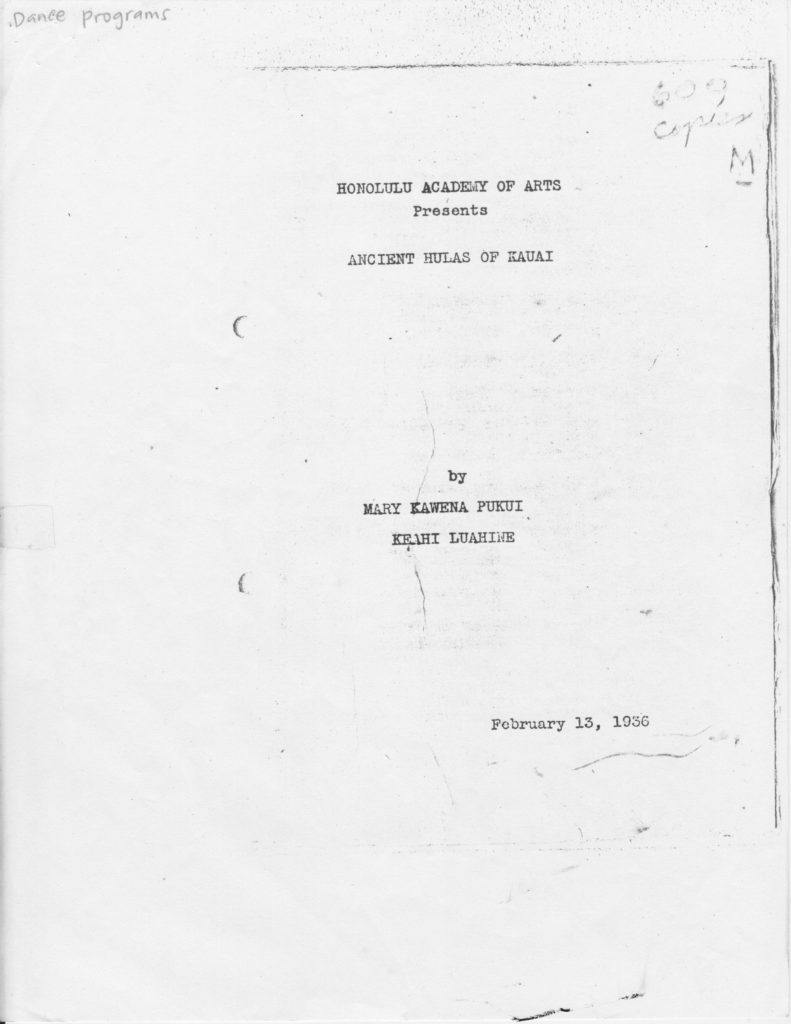
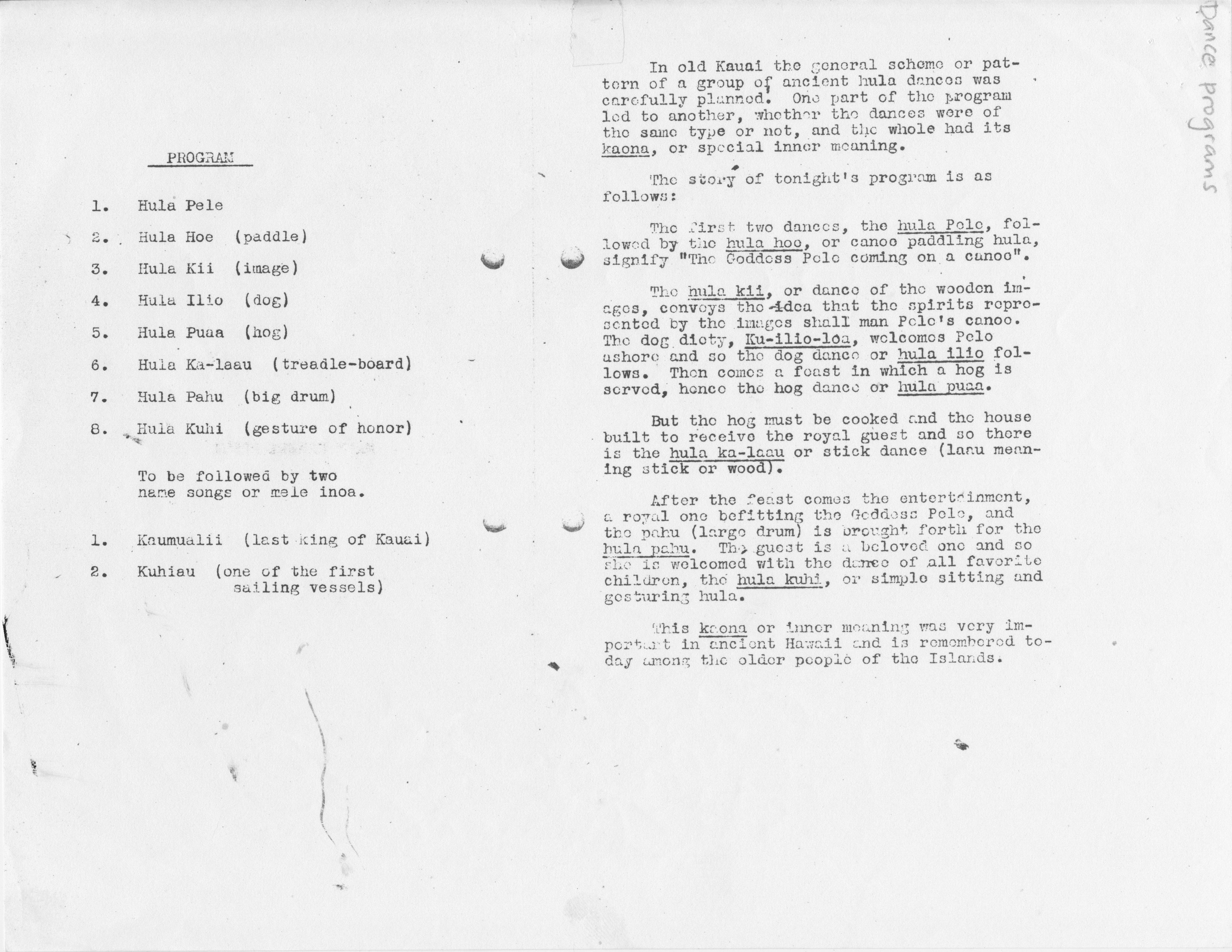 ANCIENT HULAS OF KAUAI by MARY KAWENA PUKUI KEAHI LUAHINE February 13, 1936 PROGRAM 1. Hula Pele 2. Hula Hoe (paddle) 3. Hula Kii (image) 4. Hula Ilio (dog) 5. Hula Puaa (hog) 6. Hula Ka-laau (treadle-board) 7. Hula Pahu (big drum) 8. Hula Kuhi (gesture of honor) To be followed by two name songs or mele inoa. 1. Kaumualii (last king of Kauai) 2. Kuhiau (one of the first sailing vessels) In old Kauai the general scheme or pat- tern of a group of ancient hula dances was carefully planned. One part of the program led to another, whether the dances were of the same type or not, and the whole had its kaona, or special inner meaning. The story of tonight’s program is as follows: The first two dances, the hula Pele, fol- lowed by the hula hoe, or canoe paddling hula, signify “The Goddess Pele coming on a canoe”. The hula kii, or dance of the wooden im- ages, conveys the idea that the spirits repre- sented by the images shall man Pele’s canoe. The dog diety, Ku-ilio-loa, welcomes Pele ashore and so the dog dance or hula ilio fol- lows. Then comes a feast in which a hog is served, hence the hog dance or hula puaa. But the hog must be cooked and the house built to receive the royal guest and so there is the hula ka-laau or stick dance (laau mean- ing stick or wood). After the fease comes the entertainment, a royal one befitting the Goddess Pele, and the pahu (large drum) is brought forth for the hula pahu. The guest is a beloved one and so she is welcomed with the dance of all favorite children, the hula kuhi, or simple sitting and gesturing hula. This kaona or inner meaning was very im- portant in ancient Hawaii and is remembered to- day among the elder people of the Islands.
ANCIENT HULAS OF KAUAI by MARY KAWENA PUKUI KEAHI LUAHINE February 13, 1936 PROGRAM 1. Hula Pele 2. Hula Hoe (paddle) 3. Hula Kii (image) 4. Hula Ilio (dog) 5. Hula Puaa (hog) 6. Hula Ka-laau (treadle-board) 7. Hula Pahu (big drum) 8. Hula Kuhi (gesture of honor) To be followed by two name songs or mele inoa. 1. Kaumualii (last king of Kauai) 2. Kuhiau (one of the first sailing vessels) In old Kauai the general scheme or pat- tern of a group of ancient hula dances was carefully planned. One part of the program led to another, whether the dances were of the same type or not, and the whole had its kaona, or special inner meaning. The story of tonight’s program is as follows: The first two dances, the hula Pele, fol- lowed by the hula hoe, or canoe paddling hula, signify “The Goddess Pele coming on a canoe”. The hula kii, or dance of the wooden im- ages, conveys the idea that the spirits repre- sented by the images shall man Pele’s canoe. The dog diety, Ku-ilio-loa, welcomes Pele ashore and so the dog dance or hula ilio fol- lows. Then comes a feast in which a hog is served, hence the hog dance or hula puaa. But the hog must be cooked and the house built to receive the royal guest and so there is the hula ka-laau or stick dance (laau mean- ing stick or wood). After the fease comes the entertainment, a royal one befitting the Goddess Pele, and the pahu (large drum) is brought forth for the hula pahu. The guest is a beloved one and so she is welcomed with the dance of all favorite children, the hula kuhi, or simple sitting and gesturing hula. This kaona or inner meaning was very im- portant in ancient Hawaii and is remembered to- day among the elder people of the Islands. 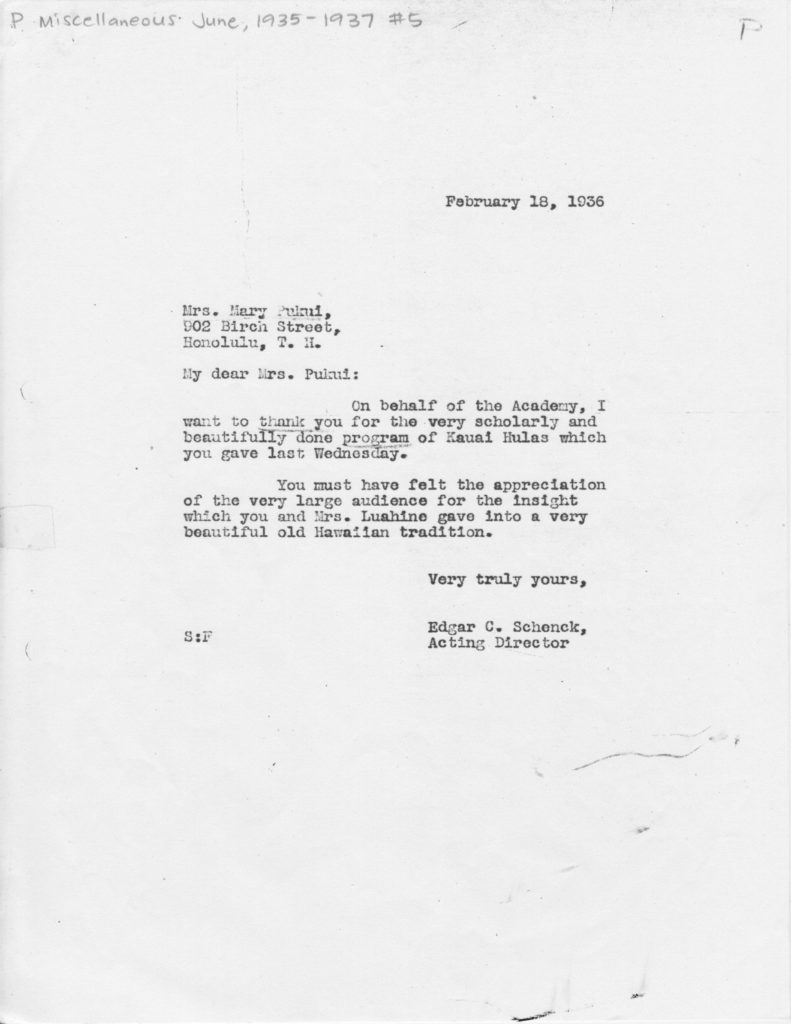
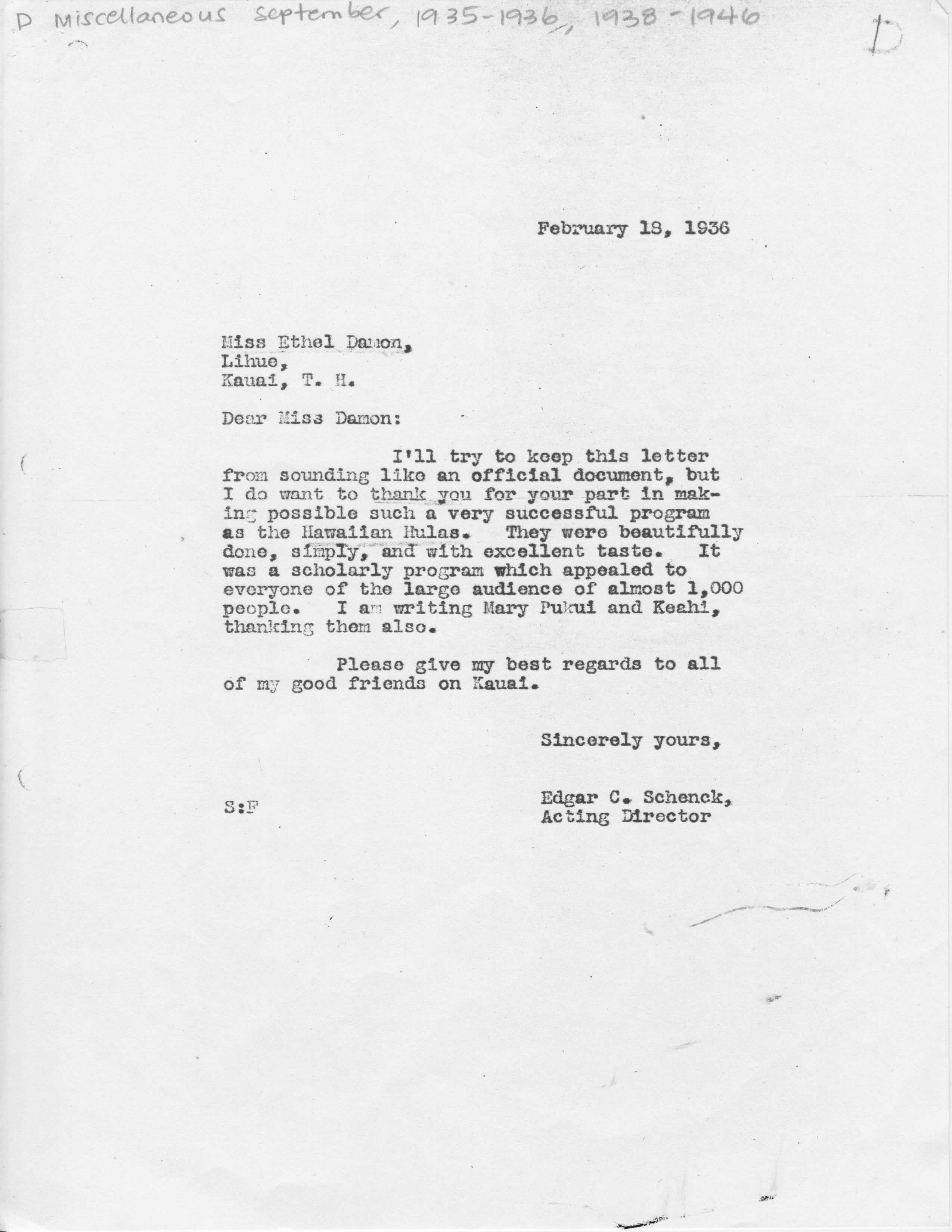
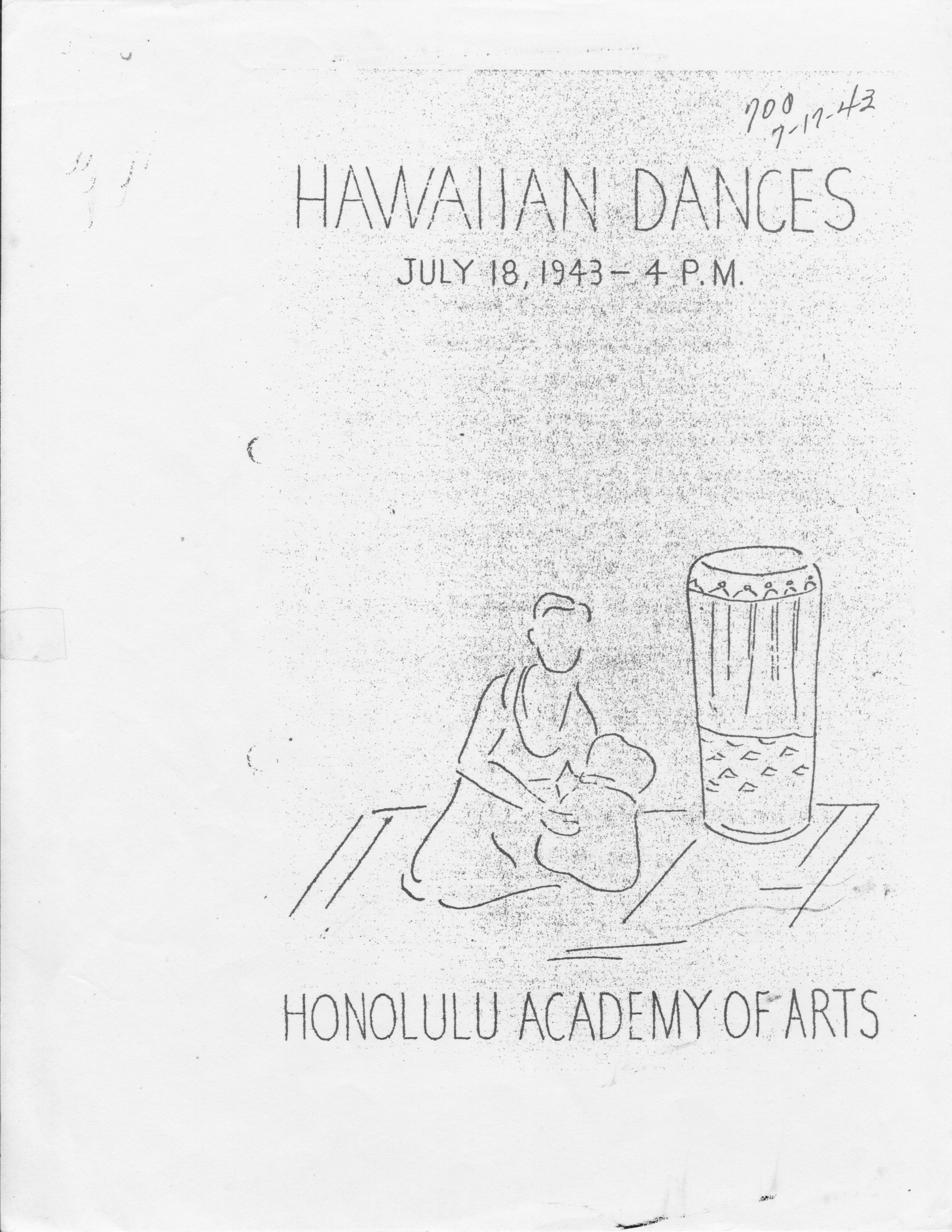
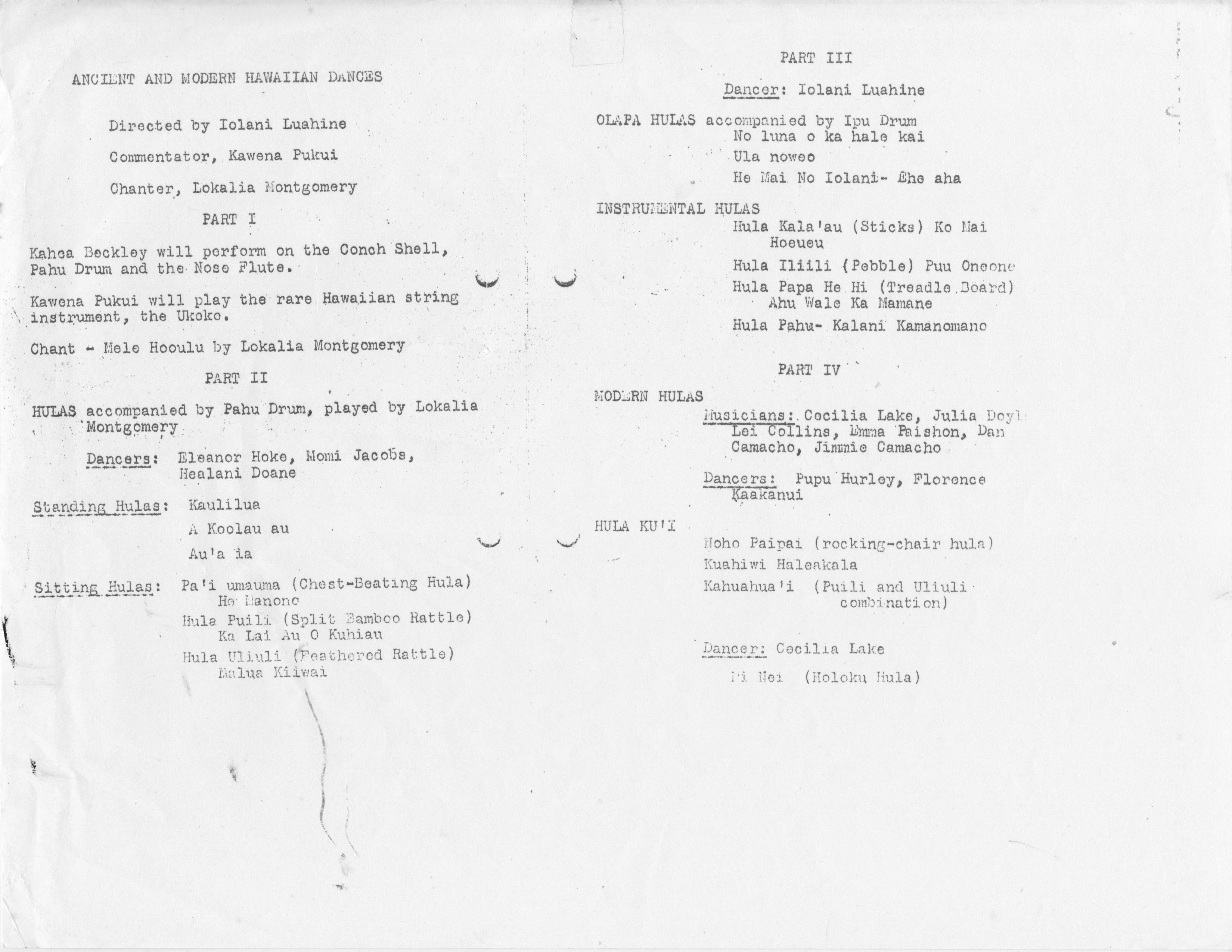 ANCIENT AND MODERN HAWAIIAN DANCES Directed by Iolani Luahine Commentator, Kawena pukui Chanter, Lokalia Montgomery PART I Kahea Beckley will perform on the Conch Shell, Pahu Drum and the Nose Flute. Kawena Pukui will play the rare Hawaiian string instrument, the Ukeke. Chant – Mele Hooulu by Lokalia Montgomery PART II HULAS accompanied by Pahu Drum, played by Lokalia Montgomery. Dancers: Eleanor Hoke, Momi Jacobs, Healani Doane Standing hulas: Kaulilua A Koolau au Au’a ia Sitting hulas: Pa’i umauma (Chest-Beating Hula) He Manono Hula Puili (Split Bamboo Rattle) Ka Lai Au O Kuhiau Hule Uliuli (Feathered Rattle) Malua Kiiwai PART III Dancer: Iolani Luahine OLAPA HULAS accompanied by Ipu Drum No luna o ka hale kai Ula noweo He Mai No Iolani – Ehe aha INSTRUMENTEL HULAS Hula Kala’au (Sticks) Ko Mai Hoeueu Hula Iliili (Pebble) Puu Oneone Hula Papa He Hi (Treadle Board) Ahu Wale Ka Mamane Hula Pahu – Kalani Kamanomano PART IV MODERN HULAS Musicians: Cecilia Lake, Julia Doyle Lei Collins, Emma Paishon, Dan Camacho, Jimmie Camacho Dancers: Pupu Hurley, Florence Kaakanui HULA KU’I Noho Paipai (rocking-chair hula) Kuahiwi Haleakala Kahuahua’i (Puili and Uliuli combination) Dancer: Cecilia Lake Mi Nei (Holoku Hula)
ANCIENT AND MODERN HAWAIIAN DANCES Directed by Iolani Luahine Commentator, Kawena pukui Chanter, Lokalia Montgomery PART I Kahea Beckley will perform on the Conch Shell, Pahu Drum and the Nose Flute. Kawena Pukui will play the rare Hawaiian string instrument, the Ukeke. Chant – Mele Hooulu by Lokalia Montgomery PART II HULAS accompanied by Pahu Drum, played by Lokalia Montgomery. Dancers: Eleanor Hoke, Momi Jacobs, Healani Doane Standing hulas: Kaulilua A Koolau au Au’a ia Sitting hulas: Pa’i umauma (Chest-Beating Hula) He Manono Hula Puili (Split Bamboo Rattle) Ka Lai Au O Kuhiau Hule Uliuli (Feathered Rattle) Malua Kiiwai PART III Dancer: Iolani Luahine OLAPA HULAS accompanied by Ipu Drum No luna o ka hale kai Ula noweo He Mai No Iolani – Ehe aha INSTRUMENTEL HULAS Hula Kala’au (Sticks) Ko Mai Hoeueu Hula Iliili (Pebble) Puu Oneone Hula Papa He Hi (Treadle Board) Ahu Wale Ka Mamane Hula Pahu – Kalani Kamanomano PART IV MODERN HULAS Musicians: Cecilia Lake, Julia Doyle Lei Collins, Emma Paishon, Dan Camacho, Jimmie Camacho Dancers: Pupu Hurley, Florence Kaakanui HULA KU’I Noho Paipai (rocking-chair hula) Kuahiwi Haleakala Kahuahua’i (Puili and Uliuli combination) Dancer: Cecilia Lake Mi Nei (Holoku Hula) 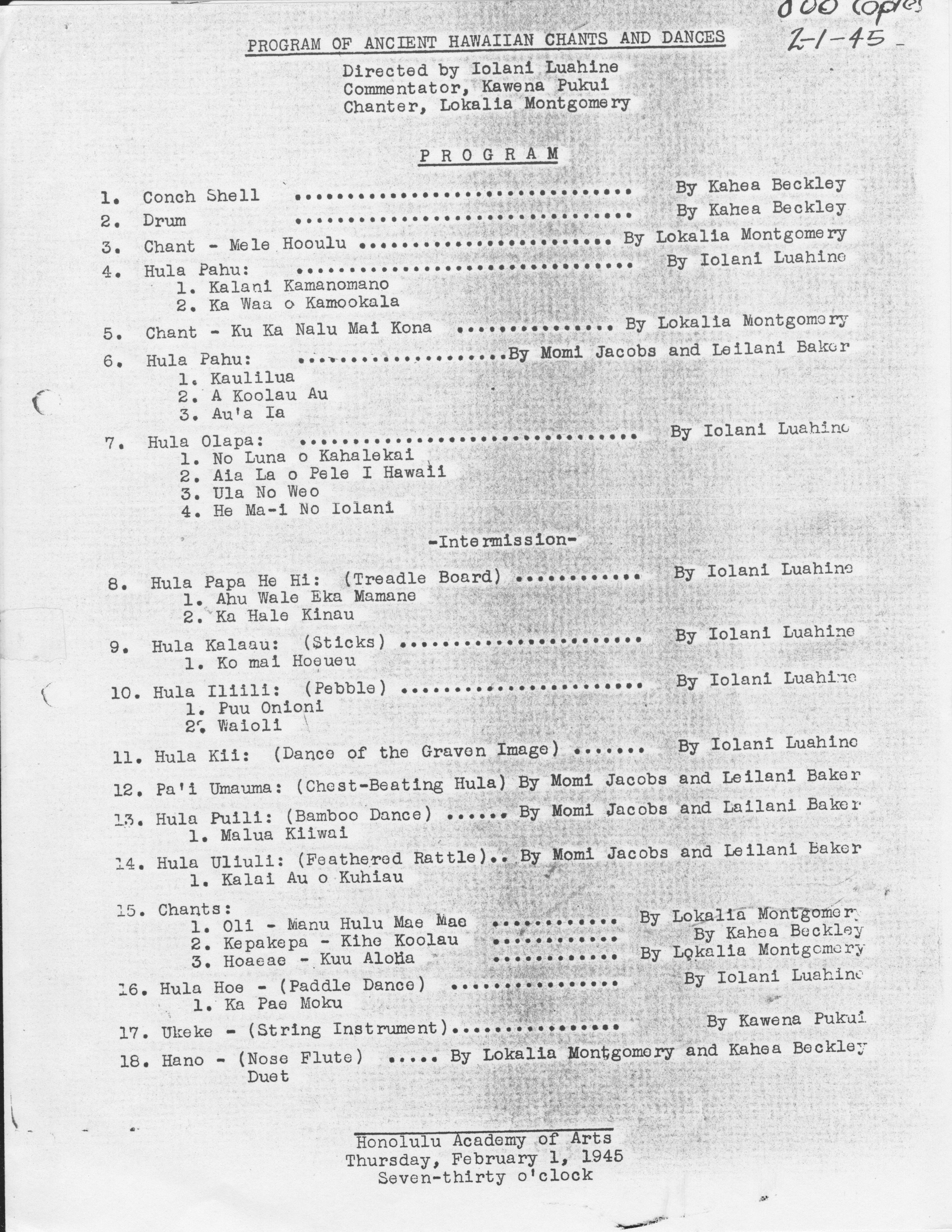
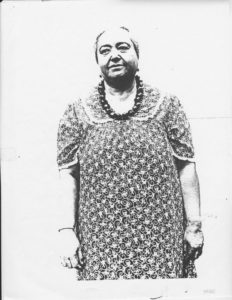
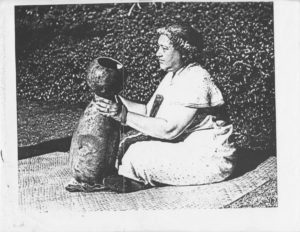 Commentary on Hula today: Both Kawena, and then Namaka, have commented through the years that the focal point of hula was the mele and the dance accompanied the story told by the chant. They learned to dance so that a deaf man could follow the story, through the dance. It has reversed because very few understand the story, the poetry, so now the focus ;is on the dance.
Commentary on Hula today: Both Kawena, and then Namaka, have commented through the years that the focal point of hula was the mele and the dance accompanied the story told by the chant. They learned to dance so that a deaf man could follow the story, through the dance. It has reversed because very few understand the story, the poetry, so now the focus ;is on the dance.
**************************
SONGS AND CHANTS:
Kawena Pukui wrote more than 150 songs and chants. Many of the songs were in collaboration with others, although she wrote both lyrics and music for over 50 songs. Some of these songs are considered “classics,” and any Hawaiian group must have some of these songs in their repertoire. Her first composition set to music was, “Mele Ho’ala for La’akea” (La’akea’s Wake Up Song,” written for her grandson, La’akea, when he was three months old. She would sing this song every morning to wake him, as he had been given to her to raise.
Mele Ho’ala for La’akea Song to Awaken La’akea
Aia ka la me ka hikina, The sun is rising in the east ‘Ula wena i ka ‘ili ‘o ke kai It casts a red glow over the sea Ka hea mai nei i ku’u kama lei, It is calling to my beloved chil E ala, e ala, ua ao. Awake, awake, it is day.
Pa mai ka makani aheahe, A gentle wind is blowing Hali ana i ke ‘ala o na pua, Laden with the fragrance of flowers, Ke pane mai nei, me ka leo It is answering in a gentle voice nahenahe, E ala, e ala ua ao Awake, awake, it is day.
Ke mele ‘oli nei na manu, The birds are gaily singing ,Leo hone o ka lau la’au, The sweet singers of the tree tops Ke pane mai nei me ka piha hauoli, They are singing joyously, E ala, e ala, ua ao. Awake, awake, it is day.
Ke ala mai nei kamali’i, Little children are now awakening Na hoa launa o ku’u lei, The playmates of my child, E pa’ani a e laulima pu, To play and to work together, Ua ala o La’akea, ua ao. La’akea is awake, it is day.
Alice Kalahui, who was Supervisor of Music and Dance encouraged her to enter this song in the annual song writing contest sponsored by the City Parks and Recreation Department and she won third prize. She won and placed so many times in subsequent contests that, eventually, she was barred from entering.
THE NA HŌKŪ HANOHANIO AWARD – was presented to Kawena in 1978, its very first year. HAWAIIAN MUSIC HALL OF FAME- Kawena was inducted in 1995, the first year of this award. Kawena was a prolific songwriter and composer, helping many others during her lifetime, She also wrote songs for events, people or places and gave them away to the requester. Her collaboration with other noted Hawaiian artists produced many popular songs, considered “classics” today. Listed below are some of those compositions.
Hāniumalu
Hauoli Lā Hanau
’52 Honolulu
’52 Hula
‘51 Ho‘onani (Glorify)
’52 Kaho‘olawe
’52 Kama‘a Hou (Nina, Lani,Lahela)
Kilauea
Ko Kupuna
Noho Paipai
Ku‘u Lei (My Lei)
’49 Ku’u Lei Lehua
‘52 Ku‘u Liko O La’i Aloha
’52 Ku‘u Lupe (Nina, Lani, Lahela)
Ku’u Wa’a (Nina, Lani, Lahela)
La‘i Aloha
’52 Lawai‘a (Fishing)
Lei Pūpū (Lei of Sea Shells)
’52 Lilia Nananana (Spider Lily)
Little Drummer Boy (trnslted into Hawaiian) (J Tingsley)
Manu Ulili Mele Ho‘ala (for La’akea)
’50 Mele Ka‘i Ho‘i Hula
’52 Moa Molokini Na Hoe Wa‘a (Nina, Lani, Lahela)
‘Ohu Kakahiaka (Moving Mist)
Pi-‘ā-pā (Alphabet)
’49 Pikake
’51 Pua Aloalo (Hibiscus)
’49 Pua Melia (Plumeria)
’40 Pua Waiohinu
Wehiwehi Nu’uanu
’52
SONGS IN COLLABORATION WITH MADDY LAM:
Ha’aheo Kaimana Hila (Na Palapalai)
Hanauma (Kawai Cockett/**Soph.Combined)
Home Kapaka ‘50 (Natalie Ai Kamau’u)
Ho’onani (Glorify)
Ho’omaika’i
Ka ‘Iwa (Kekua Fernandez)
https://www.youtube.com/watch?v=YfJuKygEYpgr. Women)
Kana Kaloka [Santa Claus] (Leo Nahenahe Singers) https://www.youtube.com/watch?v=U3tYnxl35Q4
Ka’u Nui (K. Lake Trio/**Jr. combined) https://www.youtube.com/watch?v=rdjARMx24yI https://www.youtube.com/watch?v=WCBCdDylNV0
Ke Anuenue ’54 (Darlene Ahuna) https://www.youtube.com/watch?v=8EnSOb_HrcQ
Kipukai ’56 (Na Leo Pilimehana) https://www.youtube.com/watch?v=wqOc2YeTpRg
Koa’e ’57 (Manoa Voices/**Jr. Men) https://www.youtube.com/watch?v=K7SORYuGWbM https://www.youtube.com/watch?v=fzcExvShlks
Ku’u Ipo Onaona ’46 https://www.youtube.com/watch?v=lBh1_BBWT-Y
Ku’u Lei Lehua Ku’u Sweetie ’58 (Darlene Ahuna/Myra English/**Fresh.) https://www.youtube.com/watch?v=SVqBUcBUYwE https://www.youtube.com/watch?v=dG602Vdz5mE https://www.youtube.com/watch?v=l_TMjfGEH_U
Ku’u Tutu ’55 (Leina’ala Haili/Genoa Keawe) https://www.youtube.com/watch?v=jHaPFzMeBCY https://www.youtube.com/watch?v=h76Uecx69yA
Mele Inoa No Kilihama ’55
Nani Ke Ao Nei (K. Kelekolio) https://www.youtube.com/watch?v=0rwCCYZGQSY
Nani Oahu Nani Venuse (Wenusi) ’81 (Kahauanu Lake Trio) https://www.youtube.com/watch?v=K6FqZ4_F2C8
Na Pele Ka’a “55 No Keaha ’55 (Sonny Chillingsworth) https://www.youtube.com/watch?v=R2_7JXeB67o
Po La’ila’i (Ku’uipo Kumukahi/** Senior Men) https://www.youtube.com/watch?v=3-2yqKlD9jU https://www.youtube.com/watch?v=o7Jk8-SWzcQ
Pua Ahihi ’64 (K. Lake Trio/ O’Brian Eselu/**Jr. women ) https://www.youtube.com/watch?v=-WWzHbz7Pmo https://www.youtube.com/watch?v=8YlYiRFauVk https://www.youtube.com/watch?v=LgUi1t8-2xo
SONGS IN COLLABORATION WITH IRMGARD FARDEN ALULI:
Boy From Laupahoehoe (Bill Ka’iwa) https://www.youtube.com/watch?v=mOEJ0tG9CLY
Ku’u Hoa He’e Nalu (**Soph. Men) https://www.youtube.com/watch?v=X2RTgITao80
Ku’u Pete (Waimanalo Keiki, Seattle Slack Key Festival) https://www.youtube.com/watch?v=R7G_s-A9nhg https://www.youtube.com/watch?v=6qDuznSy_Fw
Maui Poi Maker’s Tune (Myrtle Hilo) https://www.youtube.com/watch?v=iOTLRlH71bw
Sun and Sand
Punalu’u (Jesse Tinsley) https://www.youtube.com/watch?v=vnG5zU72bKE
Lahaina
Kalia
Ho’omaika’i
Manono Aloha
Ho’i Mai Ku’uipo
Ka Lei O Punahou
Maka Alamihi
SONGS IN COLLABORATION WITH KAHAUANU LAKE:
Pua Lililehua (K. Lake Trio/**Seniors combined) https://www.youtube.com/watch?v=OV98w5XWGsg https://www.youtube.com/watch?v=_abC69H8BD8
Please Release Me Let Me Go Translated into Hawaiian but contrary sentiment
SONGS IN COLLABORATION WITH EDDIE KAMAE: Ke Ala A Ka Jeep (Eddie Kamae/Hoku Pa’a) https://www.youtube.com/watch?v=2QHb9POSU2E https://www.youtube.com/watch?v=bWZ8GuHv-lU
** 2007 Kamehameha Schools Song Contest Honoring Mary Kawena Puku’i
RELATED LINKS:
KA LEHUA I MILIA –Before Kalimakuhilani Suganuma was Miss Aloha Hula, she was an ordinary beautiful hula dancer and alumnus of Kamehameha ʻ05. Here she is, performing one of her great-grandmotherʻs (Tūtū Pukuʻi) compositions, “Ka Lehua I Milia” at a kanikapila gathering at the Kamehameha band room one evening. This was to display the songs for Song Contest 2007 that was dedicated to Mary Kawena Pukuʻi – ʻAʻaliʻi Kū Makani ʻO Nāʻālehu. Manu Boyd – ʻUkulele Hailama Farden – ʻUkulele, Kuʻualoha Kauliʻa – Bass. Chad Takasugi – Guitar, Randie Fong – Piano https://www.youtube.com/watch?v=ISE51_4lVgM
MISS ALOHA HULA 2008 KALIMAKUHILANI SUGANUMA (SOUTHARD) performs family chants for her kahiko presentation: Ka Lawai’a Holona I Ke Kai O Manaka’a, He Mele O Kupake’e, Na kupuna o Ka’u https://www.youtube.com/watch?v=JT6Vx47ESZY
MISS ALOHA HULA 2008 KALIMAKUHILANI SUGANUMA (SOUTHARD) performs Kilauea, a chant written by her great grandmother, Mary Kawena Puku’i, set to music for her auana prsentation. https://www.youtube.com/watch?v=JT6Vx47ESZY#t=5.6215635
EDDIE AND MYRNA KAMAE, during interview by Leslie Wilcox on her program, Long /story Short, mentions their long relationship with Mary Kawena Puku’i. https://www.youtube.com/watch?v=Nh8YchXgRcs.
LEGACY OF LIGHT, highlights the lives of Gabby Pahinui and Mary Kawena Puku’i. https://www.youtube.com/watch?v=LyF1v7aDLTs
HIKI NO, THE MARY KAWENA PUKU’I CULTURAL PRESERVATION SOCIETY president and grandson of M.K. Puku’i is interviewed by students of Hawaiian Mission Academy, where his grandmother graduated in 1923 wheb she was 28 years old. https://www.youtube.com/watch?v=WLP0s08B_GU
‘
‘ŌLELO HAWAI’I, THE HAWAIIAN LANGUAGE:
The Decline of the Hawaiian Population In 1778, the British explorer Capt. James Cook became possbly the first European to encounter the Hawaiian Islands. He encountered a healthy and robust population living in a pristine habitat with no diseases. While no one knows exactly how many Native Hawaiians there were when Cook arrived, scholars agree that that contact with Europeans had disastrous consequences for the islanders. Sara Goo of the Pew Research Center stated, “Captain Cook and his crew wrote in well-documented accounts about concerns that they had infected the population with venereal diseases (Cook said he unsuccessfully tried to prevent his men from mingling with the native women).” Hawaiians had no resistance to na ma‘i haole (foreign diseases) and the result was devastating. Over the years, many other infectious diseases and illnesses such as measles, chicken pox, polio and tuberculosis, all introduced by foreigners who came to the Hawaiian Islands, killed thousands of Hawaiians. … Historical accounts by missionaries and other Westerners who first arrived in the 1820s frequently predicted the complete eradication of the Hawaiian race from the planet by the early 20th century. Indeed, by 1920, the Native Hawaiian population had dwindled to just under 24,000, according to the U.S. Census.” That picture has dramatically improved over the past few decades, although just how much depends on which set of numbers you’re using to estimate how many people were living on the Hawaiian islands before the arrival of Europeans. According to Kamehameha Schools, the 1778 population was around 300,000, but recent estimates by sociologist David Swanson place them much higher, at around 683,000. Whether you use the Kamehameha Schools estimate or the Swanson estimate, from European contact in 1778 to 1920, a mere 142 years, the Hawaiian population had decreased by a low of 92 percent (92%) to a high of 96.5 percent (96.5%). Meanwhile, the influx of foreigners and importing of foreign labor for the sugar plantations soon made the Hawaiian population a minority in their own land
********
The Decline of the Hawaiian Language Hawa‘’i was recognized by nineteen nations around the world, including the United States, as a legitimate sovereign government with treaties in place. In January of 1893, the Hawaiian Monarchy was illegally overthrown by a group of businessmen, mostly American, aided and supported by the United States military and U.S. MinisterJohn Stevens. Now the movement to eliminate the Hawaiian language accelerated, although the Hawaiian language is a rich and fascinating language, descriptive and intricate, far beyond languages such as English. The Reverend Lorenzo Lyons, a much loved missionary to Hawai’i wrote in 1878: “I’ve studied Hawaiian for 46 years but am by no means perfect . . . it is an interrminable language . . . it is one of the oldest living languages of the earth, as some conjecture, and may well be classed among the best . . . the thought to displace it or to doom it to oblivion by substituting the English language, ought not for a moment to be indulged. Long live the grand old, sonorous, poetical Hawaiian language.” In 1896, three years after the illegal overthrow of the Hawaiian Monarchy a law was passed by the illegal “Republic” of Hawai’i banning Hawaiian. Act 57, sec. 30 of the 1896 Laws of the Republic of Hawai’i stated: The English Language shall be the medium and basis of instruction in all public and private schools, provided that where it is desired that another language shall be taught in addition to the English language, such instruction may be authorized by the Department, either by its rules, the curriculum of the school, or by direct order in any particular instance. Any schools that shall not conform to the provisions of this section shall not be recognized by the Department. [signed] June 8, 1896 Sanford B. Dole, President of the Republic of Hawaiʻi This law established English as the medium of instruction for the government-recognized schools both “public and private”. While it did not ban or make illegal the Hawaiian language in other contexts, its implementation in the schools had far reaching effects. Those who had been pushing for English-only schools took this law as license to extinguish the native language at the early education level. While the law stopped short of making Hawaiian illegal (it was still the dominant language spoken at the time), many children who spoke Hawaiian at school, including on the playground, were disciplined. This included corporal punishment and going to the home of the offending child to strongly advise them to stop speaking it in their home. Moreover, the law specifically provided for teaching languages “in addition to the English language,” reducing Hawaiian to the status of a foreign language, subject to approval by the Department. Hawaiian was not taught initially in any school, including the all-Hawaiian Kamehameha Schools. This is largely because when these schools were founded, like Kamehameha Schools founded in 1887 (nine years before this law), Hawaiian was being spoken in the home. Once this law was enacted, individuals at these institutions took it upon themselves to enforce a ban on Hawaiian. Kamehameha Schools even checked all outgoing mail of their boarding students to insure that nothing was written in Hawaiian.,
********
Dictionaries of the Hawaiian Language He loa ka ‘imina o ke ala o Hawai‘i ‘imi loa. Long is the search for the way of Hawai‘i’s thinkers. The earliest list of Hawaiian words appeared in Captain James Cook’s A Voyage to the Pacific Ocean, Volume III, compiled in 1778, the year that Cook first came upon the Hawaiian Islands, and included about 250 words, spelled much differently than today. For example, nooe (nui) and eeheu (ihu). Anyone who has seen old drawings or read old text about our islands has seen words like Owhyhee (Hawai’i), Mowee (Maui), Wahoo (Oʻahu) and Tamaahmaah (Kamehameha). Subsequently,other lists were prepared: Manuel Quimper in 1791; Urey Lisiansky in 1804; Archibald Campbell in 1809 and James Arago in 1819, containing 170 to 400 words, with the spelling styles varying according the compiler’s language,of Spanish, Russian, British or French. In 1829, the missionaries decided to standardize the spelling by voting amongst themselves as to using “k” or “t”, “l” or “r”, “w” or “v”, etc., thereafter consistently teaching and printing the language in accordance with those decisions. There were nine dictionaries printed from 1836 to 1945 by Andrews, Mosblech, Emerson-Bishop, Remy, Hitchcock, Andrews-Parker and Judd-Pūku‘i-Stokes, varying in content. In 1949, the legislature of the Territory of Hawaʻʻi commissioned Mary Pǖkuʻi and Samuel Elbert to write a new dictionary of Hawaiian, either revising the Andrews-Parker work or starting from scratch.[57] Pūkuʻi and Elbert took a middle course, using what they could from the Andrews dictionary, but making certain improvements and additions that were more significant than a minor revision. Kawena Pūku’i was the senior author, responsible for the Hawaiian words and definitions including writing down words and remembering all the various ways the words were used in order to capture their exact definitions. In the Hawaiian language, there are many words that, although spelled exactly the same, would have various definitions, depending solely on the pronunciation. Sam Elbert dealt with the intricacies of putting together a dictionary. The Hawaiian-English Dictionary, co-authored by Mary Kawena Pūkuʻi and Samuel H. Elbert, published in 1957, contained approximately 10,000 more words than previous works and introduced an era of gradual increase in attention to the language and culture. A Monumental and Challenging Work: To begin to understand the significance of this endeavor, one must consider the time in which this task was undertaken. When Mary Kawena Pūkuʻi was commissioned to, and agreed to, work on a Hawaiian-English Dictionary, with Sam Elbert, a former student of hers who taught Hawaiian and was a professor of linguistics at the University of Hawaiʻi, it was a completely different world than today. The general thought was that the language was basically a dead one, only spoken by a relatively few people and was undoubtedly headed for extinction. Kawena, who was raised by her Hawaiian grandmother, recalled that her haole father, Henry Nathaniel Wiggin, was criticized for allowing his child to learn the Hawaiian language and customs. There was testimony before the territorial legislature that it would be a complete waste of time and money to fund a Hawaiian Dictionary. Those American businessmen/politicians and missionaries who were in full support of the outlawing of speaking Hawaiian in the schools and other areas had very much succeeded in their intent to eliminate the mother tongue of Hawai‘i and convert all native Hawaiians into English speaking Americans. Several generations of students and well-meaning parents had reduced native speakers to a handful of older folks, with the numbers constantly dwindling as they passed away. There was no demand for Hawaiian language teachers, or classes offered, except minimally at the University level. Kawena was concerned that the language was changing and future generations of translators would not be able to understand the Hawaiian spoken and written by those native speakers of the past, but spending time, money and effort trying to save what was generally considered a “dead” language was foolish, according to many, and she was highly criticized and berated, perhaps surprisingly, but sadly, by other Hawaiians. She would receive scathing phone calls, called names and even cursed. After one particularly vicious verbal thrashing from a Hawaiian woman, she returned quietly to the dinner table with tears in her eyes after telling her attacker, “I’m doing this for my moʻopuna, and some day, yours will benefit, too.” Today, Hawaiian is flowing out of the mouths of the children and adults, and growing, thanks to programs like ʻAha Pnana Leo, and later, Ka Papahana Kaiapuni Hawaiʻi. The Hawaiian language is an official language of Hawaiʻi and the dictionary is the bible of our mother tongue and can be found all over the world.
********
ʻAha Pūnana Leo’s “A Timeline of Revitalization” points out that in the year 1928,”Mary Kawena Pūkuʻi, born in 1895, begins translating Hawaiian newspapers at the Bishop Museum. This has developed out of her earlier assistance to Dr. Martha Beckwith, a professor of folklore at Vassar College. Ms. Pūkuʻi’s keen interest in providing future generations of Hawaiians with an accurate record of their ancestral language and culture provides motivation for her to spend years documenting that heritage and assisting interested others for decades to come.” It further notes that in the year 1957, “The Hawaiian Dictionary by Mary Kawena Pūkuʻi and Samuel H. Elbert is published with funding from the territorial legislature. Containing approximately 30,000 entries spelled with full marking of all ʻokina (glottal stops) and kahakō (macrons used in distinguishing long vowels), this book opens the door to the Hawaiian language for younger generations and could arguably be considered the key to later rebirth of Hawaiian as a language of children and families. Seven years later, the two complete an English-Hawaiian companion volume.”
********
While working on the dictionary, Kawena’s time and attention was in great demand. There were always people locally and abroad, who wanted to speak with her. In order to get work done on the dictionary, she spent much of her time in isolation, with boxes and boxes of file cards of Hawaiian words, in the little quarters next to the main house of Dr.Handy’s country home in Punalu‘u, taking her grandson, La‘akea with her one summer. She explained to him that the diacritical marks used, the ‘okina (glottal stop) and Kahakō (macron) were used as aids to pronounce Hawaiian words because the pronunciation of a word made a difference in its meaning. She said that she and other native speakers, as well as writers of the past, never used them because they knew their language, but future translators would have to know this. The two spent many hours together, walking early in the morning along the beach. They sometimes ran across an old man, cleaning the yard at one of the homes and Kawena, knowing he descended from a Ka‘ū chiefly family would greet him with, “Aloha, ku‘u ali‘i.” (Good morning, my chief). Family would come out on some weekends and enjoy the beach. At the publication of the Hawaiian-English Dictionary in 1957, Kawena offered to the gathering at the Bishop Museum reception, the premier performance of “Poli‘ahu,” written in honor of the Snow Goddess of Mauna Kea. The chant and dance composed and choreographed by her, was performed by her daughter, Pele Pūku‘i Suganuma, accompanied by Ka‘upena Wong, who chanted and kept the quick rhythm on his pahu (drum).
********
A second edition in1961 and a third edition in 1964 followed the much celebrated first edition of 1957. The 1971 fourth edition updated and combined the third edition of the Hawaiian-English Dictionary and the first edition of the English-Hawaiian Dictionary, published in 1963. It also included one thousand new entries and meanings; a glossary of gods, demigods, family gods and heroes; a list of specializations of Hawaiian gods and important forms they assumed; and a list of Hawaiian reflexes of Proto-Polynesian and Proto-Malayo-Polyesian, unchanged from that appearing in the third edition
********
Hawaiian Grammar was published in 1979. “Without question, this is the definitive grammar of the Hawaiian language. Indeed it is the first attempt at a comprehensive treatment of the subject since W. D. Alexander published his concise (fifty-nine page Short Synopsis of the Most Essential Points in Hawaiian Grammar in 1864. This grammar is intended as a companion piece to the Hawaiian Dictionary, by the same authors.” “This long-expected work may, no doubt, be characterized as the most exhaustive and reliable Hawaiian grammar ever published. Both authors have invested results of several decades of their own lives into this book, and thus all linguists engaged in the study of the Polynesian languages have at their disposal . . . ‘an academic grammar’ of a major Polynesian language . . . Without exaggeration . . . this grammar of Hawaiian by Elbert and Pukui is a major contribution to Polynesian studies.” — Asian and African Studies “Elbert and Pūku’i’s work is a little jewel: Scholarship, knowledge of the language light-heartedness, readability, completeness and the richness of the data all make the grammar a joy to read as well as to consult. . . . An absolute must for all students of the Polynesian area.” —Pacific Studies ********
*******************
NOMINATED FOR NOBEL PRIZE in LITERATURE:
Dr. Mary Kawena Pukui was nominated for this award in 1981 by Adelaide Suits of Ann Arbor, Michigan. The Editor’s Note, leading into an article in The Native Hawaiian newspaper in February of 1981 stated: “The accomplishments of the native Hawaiian scholar, Dr. Mary Kawena Pukui, are legion. She is respected, revered and beloved by the Hawaiian people.” The tribute, nominating her for the Nobel Award in Literature, was written by Adelaide Suits of Ann Arbor, Michigan. The transcendent images of a culture as they are realized in the works of its finest literary artists have long been a worthy focus of the Nobel Prize for literature. The wide range of cultures represented in past awards signifies the breadth of the Nobel Committee’s search for artists and a belief in the global value of recorded literature–a belief that literature can carry a message of inspiration to cross all lines of race and creed.. It is with this in mind that I wish to propose the native Hawaiian writer and scholar, Dr. Mary Kawena Pukui, as a candidate for the Nobel Award in Literature. Dr. Pukui, in a long and productive career reaching across seven decades, has drawn on the well-springs of an oral tradition belonging to her aboriginal ancestors to create a literature of rare significance and beauty. Themes of love and reconciliation, integrity of the family and the unity and dignity of all life convey through the modern idiom of Dr. Puku’s written work the values of an ancient people that are relevant to the human condition now and in every time and place. This year, at the age of eighty-five, Dr. Pukui is looking forward to the publication of still another major work. It is an event that will bring the published writings of this remarkable and uniquely gifted woman close to sixty in number. The contribution she has made to Hawaiian life and literature can hardly be measured. Literary images of her creation are known throughout the society: they have come to form a spearhead for the cultural renaissance which is sweeping across all lines of age, race and creed in Hawaii and directing the development of a new identity for island people. It has brought her the title of “Living Treasure of the State of Hawaii,” an honorary doctorate from the University of Hawaii and numerous awards from colleagues, Hawaiian officialdom and the local populace. Among her own people she is regarded with reverent love. Dr. Pukui’s birth foreshadowed her place in the literary history of her island homeland. She was born Mary Kawena Wiggin at Haniumalu, Hawaii on April 20, 1895, the daughter of Pa’ahana Kanaka’ole, a pure-blooded Hawaiian woman, and Henry Nathaniel Wiggin, an American from Massachussets. On her marriage in 1913 to Napoleon Kaloli’i Pukui, she acquired the Hawaiian surname she uses today. The early nurture and training of Dr. Pukui was designed by her parents to invest her with the values of a dual cultural heritage. In infancy, Mary Wiggin was chosen through the Hawaiian system of adoption to the punahele (favored child) of Nali’ipo’aimoku, her maternal grandmother. For the first seven years of her life she lived as her grandmother’s only companion in a traditional Hawaiian village. During that time she received a thorough grounding in the sacred lore of old Hawaii with the spiritual powers and knowledge descending from chiefs and priests in the grandmother’s ancestral line. After the death of her grandmother, she moved to live with hr parents in the city of Honolulu. There she learned the language and culture her American father that enabled her in later years to communicate the values of an older oral culture in the written language of the new. Dr. Pukui began to write and translate from Hawaiian materials at the age of fifteen. A woman writer living near her home in Honolulu had noticed the young girl’s artistic insight and prodigious memory for the records of the past; Mary was encouraged to preserve in writing the knowledge she had received from her mother’s family. The creative quality of her work soon attracted the attention of the wider professional community in Hawaii and Mary Pukui became sought after by scholars in academic disciplines as co-author for a variety of cultural and literary projects. This conjunction of Mary Pukui’s well of creativity and the skills of established scholars resulted in a number of major publications in the fields of literature, sociologhy, history and anthropology. The significance of these publications is such that Mary Pukui’s works are now recognized as the outstanding authoritative sources in Hawaiian studies. Dr. Pukui’s interests has centered throughout her career on the poetry and chants of Hawaiian oral literature. In them she sees a record of the history, beliefs and aesthetic experiences of the Hawaiian people. The chanting of poetry gives Hawaiians a medium for expressing the infinitely varied quality of life and in turn, the subtle colorings of complex symbolism become a part of the chanter’s identity. Chants are valued possessions of a family and are passed, as heirlooms, from one generation to another. They are used to celebrate important occasions in the family’s communal life where the bonds of shared aesthetic experiences will work to hold the family’s identity in a single frame. The numerous songs and chants in Hawaiian and English composed by D. Pukui fit in to strengthen the social fabric and thereby maintain this tradition. Some are writen to celebrate a birth, marriage or special event; they are given as gifts to the honored family or friend. Others are written for the opening ceremony of the Hawaiian state legislature, the dedication of a park, or for one of the Hawaiian civic organizations. Pukui song compositions are played in concerts and on the air where they form a part of the popular culture of the people of Hawaii. The pervasive aspect of Dr. Pukui’s poetic imagery is seen in the popular song composition, “Pua Lililehua.” Ostensibly, it concerns a mo’o (lizard) that lived beside a stream in Palolo Valley. Lililehua, a legendary lady named after a famous wind and rain of that valley, was courted by the mo’o, but the lady’s human sweetheart, also lived by the Palolo stream and, of course, the mo’o was jealous. Thinly veiled in the mists of the poem’s artistic symbolism was the true subject of the story, the secret love of a Hawaiian artist for a woman he felt far above him. The sagebrush flower, Lililehua, os the poem, became a reality when the beloved woman at last deciphers the meaning of the song and when she returns his affection the entire populace is able to join in their happiness. It illustrates the irresistable quality of a powerful creative vision, In a myriad of delicate and passionate images, Dr, Pukui mirrors the many levels of man and nature, myth and reality time and place and in rhythmic interchange she welds them into one. Since ancient times, Hawaiians have expessed their aesthetic life in a combination of dance and poetry known as hula Dr. Pukui has contributed many dance poems for both children and adults to this particular genre. In “Ke Ao Nani” she has created a classic of children’s hula literature. It translates as “This beautifu World” and with a few simple words she has formed with it a representation of the four corners of the sacred creation. Arms and voices lift up to the birds in the sky, down to the flowers of the earth, over to the trees on the mountains and out to the fish in the sea. Images of our beautiful world rise and live in the mind’s eye. In the same way Dr, Pukui’s poetry celebrates the ordinary in a child’s immediate environment, in “Kama’a Hou” (new shoes), “Moa” (the chicken), and “Ku’u Lupe” (my kite), simple objects are lifted from their mundane surroundings through the excitement of vivid rhythmic imagery and placed in the exceptional atmosphere of the artistic experience. In a related area, Dr. Pukui has collected and recreated in translation many of the chants from the “unwritten literature” of Hawaii. In 1973 she published a special group of chants under the title, The Echo of Our Song with Alfons Korn as co-author. It included a first publication of a number of poems from Dr. Pukui’s family collection. The title, taken from the traditional call at the end of a chant- “let the echo of our song be heard” – tells of a persistent theme in Dr.Pukui’s life, the desire to share the unique poetic visions of Hawaii’s people. We hear in them the poignant cry of the leprosy victim, Ka’ehu, as he is separated from his family and friends, the song of the surf-rider, Naihe, who overcomes treachery through the power of a love chant and returns safely to shore; the birth chant of Kau-i-ke-ao-uli, who was stillborn and then prayed into life by the high priest, Ka-malo-ihi. Dr. Pukui’s translations bring contemporary meaning to the poems by dramatizing the relevance of Hawaii’s past and giving it a new life. She transplants them to bloom anew in the soil of her own time. Another area of Dr. Pukui’s many-faceted career is her work as translator, researcher and teacher for the Bishop Museum. Her name was noted as early as 1936 in the report of the resident Bishop Museum director, Peter Buck, for her research on Hawaiian food plants and medicine. She was recognized for her assistance in the editing and translation of S. Kamakau’s History of Hawaii and for a manuscript on traditional beliefs and customs of Hawaii that included a complete Hawaiian text. Later, as a research assistant on the Bishop Museum staff, she focused on preservation of records of the Hawaiian past. Her translations alone, from Hawaiian language souorces related to the material culture of canoes,, fishing and food, arts and crafts fill books of transcriptions that cover over nine feet of shelf at the museum library. They serve as rich resource material for the growing number of students of Hawaiian culture. The year 1936 was also the time that Dr. Pukui began research for what has become a classic in Hawaiian social literature, The Polynesian Family Sustem in Ka’u, Hawaii (published with co-author E.S.C. Handy in 1958). The picture of traditional culture it presents was taken from the authors’ studies at Haniumalu, the village of Dr. Pukui’s birth. The circumstances of the study may be unique in the annals of social science research and are interesting to not. In order to gain the confidence of the villagers and pave the way for willing cooperation in the study, Dr. Pukui asked her mother, Pa’ahana Wiggin, to adopt the “foreign” Dr. Handy and his wife so they might become her brother and sister. The close family relationship provided the ideal situation for an ethnographic study. In the style of m,odern anthropological writing and long before the advent of the interpretive approach to information on culture, Dr. Pukui gives us the world of the Hawaiian through the eyes of wise elders, ideas are conveyed indirectly through stories, chants, preverbs and personal experience. The result is a work of imagination and timeless significance. Another unusual project in Dr. Pukui’s efforts to preserve the heritage of the past was a series of interviews she made of older members of the Hawaiian population. In 1951 she traveled across the island chain to seek out and record conversations with Hawaiians elders still living in remote communities. The conversations, recorded on tape and placed in the Bishop Museum Library, help to keep alive the rich memories of kupuna, the revered old people of Hawaii, by providing direct experience of their temperment and language. Dr. Pukui has addressed the problems of psychological imbalance among modern Hawaiians in Nana I Ke Kumu, subtitled “Look to the Source.” Volume one of the two volume work was published in 1974 with the collaboration of E.W. Haertig and Catherine Lee, the second in 1980 with the collaboration of John McDermott and Catherine Lee. The first volume is described in the preface as a “source book of Hawaiian cultural practices, concepts and beliefs which illustrate the dignity contained in the cultural roots of every Hawaiian child.” Within the specttrum of spiritual and physical forces impinging on the modern Hawaiian, Dr. Pukui defines the ancient images of psychic power which can be the source of eithr his sickness or health. She speaks the unith of all life, “Oneness with the living aspect of native phenomena, with spirits and gods and other persons as souls, is not extra-sensory to the Hawaiian but a part of the natural consciousness.” And because the Hawaiian lives also in a world of western images aned concepts, she accompanies the indigenous beliefs and modes of treatment with theories and practice of western psychoanalytical thinking. Thus a further mode has been presented for greater understanding of the differing cultural framework in Hawaiian society. The importance of language for the cultural growth of Hawaii’s pople inspired the largest project of Dr. Pukui’s career, the compilation of a new and comprhensive Hawaiian-English dictionary. The interest in ethnic studies following World War II brought the need of an accurate lexicon of the almost forgotten Hawaiian language. The last important dictionary had been compiled by a missionary, Lorrin Andrews, in 1865. Dr. Pukui was chosen by a committee of scholars as the most able person to fill this need. At the time the decision was made, Dr. Pukui had already collected significant amounts of material on words and definitions. She spent the nexrt eight years living in isolation at a cottage on the north shore of Oahu in order to have the depth of concentration needed for compiling such a large quantity of date. When the first edition was ready for publication, in 1957, Dr. Pukui had spent a total of 20 years on the project. The dictionary is known as the Pukui-Elbert Hawaiian-English Dictionary; Dr. Pukui as senior author supplied the definitions and was responsible for their accuracy; Dr. Samuel Elbert, a lixicographer, was in charge of the dictions=ary’s technical aspects. The first edition contained over twenty-five thousand entries, the largest of any Polynesian lexicon. The work was hailed as “the culmination of one hundred and eighty years of research”, reaching across the centuries to explorer Captain James Cook’s first collection of 250 words in 1778,. The second part of the project, the English-Hawaiian Dictionary, was published in 1964, and, in 1971, a combined edition was brought out. A related project, a Hawaiian-english Grammar, was published in 1979. Together these volumes stand as the definitive work on the Hwaiian Language. The central theme of Dr. Pukui’s lifework is suggested by the closing phrases of the dictionary preface: “Ua ‘imihia ka mano wai o ko Hawai’i kupuna: the many sources of water and life of Hawai’i’s ancestors have been sought after.” She sought, within the mysteries of an ancient language, cultural meanings that give life and nourishment to all people. As John Dewey said, language is data of the senses that forms a creative force that binds us “of” and “by” the world to give us our shape and form. The Hawaiian way of “knowing” that Dr. Pukui reveals to her readers is similarly embedded in the power of affective language __ intuitive, qualitative, bound to the world to give us our shape and form. The Hawaiian way of “knowing” that Dr.Pukui reveals to her readers is similarly embedded in the power of affective language — intuitive, qualitative, bound to the world of the senses. She presents words as objective realities with roots in the feeling states where meaning originates, and these states are rejuvenated and enlarged through the use of language. Language is, for her, a means to increased sensitivity to life; a way for consciousness to grow and flourish. It is Dr. Pukui’s lasting achievement that, Janus-like, she has faced two worlds and crystalized in her writing the vital elements of both. Through this she has made the added dimensions of life and language available to us all. In terms vivid and concrete, laced with gentle humor, based in sentient imagery, she has cast a vision of a new people, capable of deep feelings toward each other and toward their world. That we might cherish each other is, she tells us, a plan for our survival. It is worthy of the highest honors that society can offer and a basis for my appeal to the committee to consider Dr. Mary Kawena Pukui for the Nobel Prizew for Literature. Note: Ms Suits completed her nomination/tribute with a biography, selected bibliography and the words and translations for Pua Lililehua and Ke Ao Nani.
***********************************************
KEY PEOPLE 1945 – 1960 The Honolulu Star-Bulletin, Tuesday, Mardh 7, 1995 A Special Island Tapestry Article by Marisa Maemori
“The end of World War II lifted blackout regulations, martial law, curfew and military restrictions on labor in Hawaii. Anti-communist hysteria briefly visited the islands and the Korean War took its toll on Hawaii servicemen in the early 1950’s, but the general trend was toward growth – in statehood.
What follows is a list of 10 people who made a difference in Hawaii in the years between 1945 and 1960, plus others who helped shape today’s Hawaii.” The article listed John Anthony Burns, Rev. Abraham Akaka, John Wayne Hall, Chinn Ho, Iolani Luahine, Delbert Metzger, Mary Kawena Pukui, Charles Phillip Pahinui, Ah Quon McElrath, Marion Saunders,as the 10. Under Mary Kawena Pukui, was noted: “Mary Kawena Pukui is known for her work in preserving Hawaiian culture. She was a researcher, teacher, translator, author and song composer who often aided others with their Hawaiian lyrics. She co-wrote “Hawaiian Dictionary” with linguist Samuel Elbert in 1957 and “The Echo of Our Song,” as anthology of chants and poems in English and Hawaiian, with Alfons Korn in 1974. Kawena Pukui was awarded the West Honolulu Rotary’s first David Malo Award in 1957. She died in 1986.”
***********************
HAWAIIAN RENAISSANCE by George Kanahele Star-Bulletin & Advertiser, Sunday April 17, 1977
This article, in the Focus section, began, “What is happening among Hawaiians today is probably the most significant chapter in their modern history since the overthrow of the monarchy and loss of their nationhood in 1893. For, concomitant with this cultural rebirth, is a new political awareness which is gradually being transformed into an articulate, organized but unmonolithic movement” (The following pertain this article.)
He mentioned the activity on Kaho’olawe as an example of “Hawaiian political action.” “Seven years ago, it was said that Hawaiian music was in its death throes. (I know, because I was the one who said it.) Today there are more musicians playing Hawaiian music than anyone can remember. There are more songs being composed today and probably more records being produced.” “In the field of dance, the hula (once described by a zealous bishop as an unnameable lewdness and as one of the causes of the decline of the Hawaiian race) has probably more devotees today than at any time in recent years. As in the slack key, much more interest is shown in ancient dances because they are more distinctive, authentic.” “One way to tell if people are serious about reviving their culture is to see whether they are studying their language. Hawaiians, both young and old, are doing just that. Not only Hawaiians, but others as well. Not too many years ago, you were lucky to get more than a handful of students registering for a Hawaiian language class at the University. Now there are hundreds of students each year. Unfortunately, a ‘manini’ (or stingy) budget cannot accommodate all the students.” “Did you know that one of the best selling books published by the University of Hawaii Press of Hawaii is the Pukui-Elbert Hawaiian dictionary? How else can you explain this widespread interest in learning what some have called a ‘non-functional’ language, other than in terms of a cultural renaissance?” “Another vital dimenstion of the Hawaiian Renaissance is the intellectual ferment among Hawaiians, a fact which completely escaped the writer and editors of Fodor’s guidebook of Hawaii (1975 edition) I quote ‘So far there have been no Hawaiian intellectuals. There may never be.’ And, in a pitiful effort to be coy, it states, ‘Perhaps (they or the Hawaiians are allergic to thought.’ “If they had taken the pains to do their homework, they would have learned that the literary output of Hawaiians in recent years has been unprecedented. If they needed an example, they could have read the writings of John Dominis Holt or talked with Charles Kenn or Mary Kawena Pukui. They and others have produced plays,, scholarly treatises, memoirs, textbooks, a novel, poems, short stories, a dictionary and so on.” “In higher eduction, more Hawaiians have earned PhDs in the last 10 years than ever before. Once a rarity, now a Hawaiian PhD is becoming almost commonplace. They are found in nearly all fields, including mathematics, engineering, anthropology, biology and so on, and in many universities across the land. Of course, a PhD is no assurance of intellectual quality, but it certainly doesn’t mean that Hawaiians are ‘allergic to thought.'” The article goes on to recognize Hawaiian experts in the fields of art and design: Herb Kane, Momi Cazimero, Charles Heen and Joel Awai and that “Hawaiians represent the most creative emerging artistic force in the islands and that in the near future we will see even more notable artistic achievements from them.. “I think as attitudes change, so will the old stereotypes that characterized the Hawaiian as ‘dumb, fat, lazy and undisciplined’ and the distorted notion that Hawaiians were better suited for menial, non-professional, non-intellectual work. Ethnic prejudices, like barnacles stuck to a ship’s hull, are hard to remove, but they must be.”
*****************************************
HAWAI’I’S GREAT LEADERS SHAPED SOCIEY The Honolulu Advertiser, Sunday, August 22, 1999, by John Griffin
(The writer expressed the difficulty in listing Hawaii’s leading figures of the outgoing 20th century because of considerations such as those of the plantation era, the Big Five period, post World War II, changes in the political and economic systems at different times and all the different ethnic groups
“Perhaps it’s best, then, to say that certain figures led or represented tides of history at certain key times. Some examples:” (named were) Gov. Jack Burns U.S. Sen. Dan Inoouye Jack Hall Henry Kaiser and Roy Kelley Gen. Delos Emmonsd Miles Cary “Women: from plantation workers to the society ladies of the outdoor circle “to such outstanding individuals as Mary Kawena Pukui, who did landmark work on the Hawaiian language.” “This, of course, is only a haole-heavy partial list. One could, and should, go on to Duke Kahanamoku’s influence on surfing and swimming, Gabby Pahinui and others on Hawaiian music, Bamboo Ridge publisher Darrell Lum and Eric Chock and their encouragement of local literature, the influence of artists Asami Doi and Jean Charlot. and that neglects other endeavors in fields such as law and medicine. “Finally, there’s a thought I like: Perhaps the real 20th century heroes of American (and, of course, Hawaiian) society are the ordinary people who came as immigrants or stayed and fought lry Kocal battles that addup even if they aren’t in history books.”
****************************
Centennial Tribute to Mary Kawena Pūku‘i Honolulu Advertiser, April 20, 1995 by Mark Matsunaga Her Legacy Was Perpetuation of Hawaiian language, culture.
(This article appeared on her birthday, nine years after her passing and was about her life and accomplishments. Here are some quotes.)
Pūku‘i’s work has touched virtually anyone with an interest in Hawaiian language or culture today. “It’s frightening to try to think what our lives would be without her work,” said master chanter Ka‘upena Wong, who began studying Hawaiian chants from Pūku‘i in the early 1950s. “These islands would be very un-Hawaiian. Kawena kept us Hawaiian.” Composer-songwriter Irmgard Aluli also met Pūku‘I in the 50s, forging a partnership that would collaborate on many songs. Aluli wasn’t a native speaker of Hawaiian and often sought Pūku‘i’s help writing or checking her lyrics. “She was my source for anything Hawaiian,” said Aluli, “She wasn’t afraid to pass on her knowledge.” Eddie Kama’e, another Hawaiian music legend, still refers to her as “my teacher, Kawena.” He once learned about an old song from a Hawaiian elder,.who recalled only one verse. Kama’e mentioned it to Pūku‘i, and “She picked up the pad and wrote the additional seven verses. She had remembered them from her childhood.” Pūku‘I taught him about li fe more than songs, and inspired him to write music for children, “because they are the future.” He plans to produce a film on Pūku‘i, more than her accom- plishments and awards, he hopes to convey (article cut-off) And, always, Pūku‘i’s home was open to a continuous stream of visitors and students. “It was like Grand Central Station,z’ said Pūku‘i’s first daughter, Patience Namaka Bacon. Aluli, Wong and Kama’e credit Bacon – a respected kumu hula in her own right – and her late husband, George, with providing the support that let Pūku‘i teach them. Bacon said, “She enjoyed inparting information to the folks who visited her.”
*************************
